

The Truth about Greens in Regulation
If you’re like most amateur golfers, chances are you want to hit more greens and have more birdie putts. And I’m all for that strategy. But before teaching you strategies to do that, it’s important to understand your “benchmark” of greens number based on your handicap.
Because here’s the thing, so many golfers get mad when they miss a green or only have 5-6 birdie putts per round. But depending on your handicap, that might be equal or above the average number per round.
Don’t believe me? Check out the PGA Tour averages first to better understand what’s realistic and what is a pipe dream. I’ll also help you understand your benchmark and five ways to find the putting surface more often.
Green in Regulation Definition
Before we dive in, you might be thinking… so what is a green in regulation (also abbreviated GIR) anyways?
This is a popular statistic to track for professional golfers and amateur golfers alike. Regulation means hitting in the number required (or less). You get a GIR as a regulation statistic if you hit:
- A par 3 in one shot (or a hole in one).
- A par 4 in two shots or less. Yes, driving the green in one counts too!
- A par 5 in three shots or less.
- A par 6 in four or fewer strokes. Believe it or not, but there are some golf courses with par 6’s.
Then, if you have two strokes on the green after hitting on in regulation, you’ll be making par. Or, drain the putt for a birdie or eagle.
As you will learn in this post, this statistical category is so important in shooting lower scores.
Tour Averages For Greens in Regulation
When researching this article, it’s pretty incredible to learn the PGA Tour averages for greens in regulation. Because if you’re like me, you probably think they average 70% or more, regardless of distance.
But it’s just not the case…
The Tours rank golfers based on all sorts of stats from fairways, putting, scrambling, sand saves and more.
Here’s the thing…
These are the best players in the world and yet, they still miss a lot more greens than the casual viewer might realize.
Let’s break it down by distances first.
PGA Tour Approach Shot Statistics (GIR Percentage)
This information is gathered from the PGA Tour :
- 200+ yards = 40% of greens. When they do hit the green from 200 plus yards, the average proximity to the hole is 54 feet from 225-250 yards. And 43 feet from the hole between 200-225 yards. For most golfers, this should be a big eye-opener. If you’re over 200 yards and hit the green, good for you because less than half of professional players do!
- 175-200 yards = 53% of greens. From under 200 yards, PGA Tour players hit just a little more than half of the greens and when they do, they average 34 feet from the hole.
- 150-175 yards = 63% of greens. From this range, players hit the green 10% more the last category, but still average 27 feet from the hole.
- 125-150 yards = 69% of greens. And when they do hit the green, they are still 23 feet away from the hole. This is a surprising proximity number to me since most players have a wedge or 9 iron (at most) from this range.
- 100-125 yards = 74 % of greens. This is another crazy stat as the pros only have a wedge of sorts from this distance and only hit the green 3 or 4 times! Not to mention, the average distance to the hole is still 20 feet.
- Less than 100 yards = 81% of greens. Finally, players from short range on the course average 17 feet from the pin between 75-100 yards and 15 feet from 50-75 yards.
The GIR percentage for each distance from the pros should make even the worst golfer have a little hope. If guys on the major tours can’t get the golf ball on the green constantly, then recreational golfers won’t either. And that’s okay!
As long as you keep working on your short game and have mostly two putts on the putting green, you can score well.
Let’s break down the average green in regulation numbers for amateurs next.
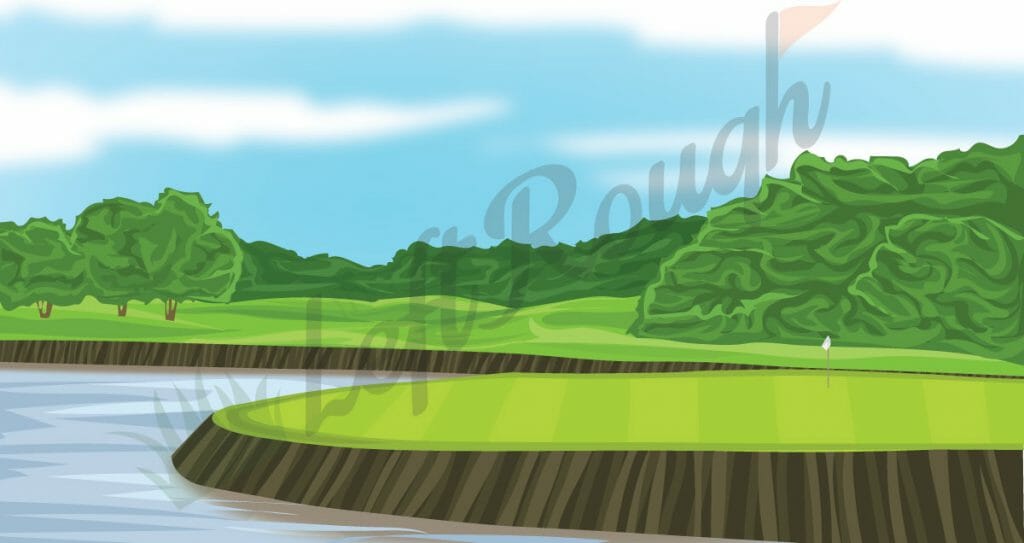
Why Your GIR is Crucial to Your Score
Greg “the Shark” Norman once said, “Happiness is a long walk with a putter.” And he’s 100% right.
It’s a great feeling when you hit your ball on the green as you eye the birdie or eagle putt from the fairway. Generally speaking, when you hit the green, it should mean a lower score and as important, less stress.
Because if you miss the green, all kinds of bad things can happen. Thick rough, deep bunkers, and all kinds of other obstacles the golf Gods throw at us.
But the numbers for amateurs for average green in regulation on the course might surprise you too:
- 25-29 handicap = 3 greens
- 20-24 handicap – 3.5 greens
- 15-19 handicap: 5.1 greens
- 10-14 handicap: 6.9 greens
- 6-9 handicap: 8.5 greens
- 3-5 handicap: 10.2 greens
- 0-2 handicap: 11.8 greens
- +3 to +1 handicap: 12.6 greens
- Tour average: 11.7 greens
Essentially, if you shoot over a 100, you will only hit a few greens. If you shoot in the 90s, you will average less than five greens. If you shoot it in the 80s, you will average about seven greens. And if you shoot in the 70s, you will average about 10 greens.
Also, don’t let the Tour average green in regulation number fool you either. Those guys are playing much longer courses in high stakes environments… often needing birdies to win or make the weekend.
How to Hit More Greens in Golf – 5 Strategies For More GIR
Hitting greens typically means less stress and in general, an average lower stroker average. Even if you’re a world-class putter, your putting can’t make up for poor iron play on a consistent basis. The key is to increase your GIR stroke as much as possible to set yourself up for success.
Now that you have a better understanding of how many greens the pros hit and why they’re crucial to your score… let’s get into some tips. I’m confident that when you use all five of these tips, you’ll hit additional greens in regulation than ever before.
1. Hit More Fairways (Improve Your Tee Shot Game)
If you want to hit more greens in regulation, you need to give yourself the best opportunity to do so with quality tee shots. Because if you’re constantly playing from the thick stuff or behind trees, improving your GIR number is nearly impossible.
Especially for everyday amateur players, who aren’t as skilled with recovery shots as low handicap or scratch golfers. For skilled players, hitting fairways isn’t as important because they usually have a consistent enough swing to get on or near the green from the rough.
But for the everyday golfer, a solid tee ball will help a ton. It will usually mean an easier next shot to the putting green by avoiding fairway bunkers and other trouble off the tee. Because remember, if you hit in a hazard or out of bounds, you won’t be able to hit the GIR.
Plus, when you’re in the fairway, club selection is much easier too. Not having to worry about thick rough or flier lie will increase your chances of selecting the right club and finding the dance floor.
Here are a few tee box strategies to help you out.
Commit to a Shot
One of the reasons that a lot of players miss fairways is because they don’t commit to a shot off the tee. Instead, they hit and hope it finds the short grass. When in reality, you should have a clear starting point and end point for your golf ball before making a practice swing.
Imagine the shot for a second and feel a high draw , a low cut , or a straight shot you want to hit. Whether you pull it off or not, at least you had a high percentage shot in mind. This will help you on the course and commit in your mind the shot you want to play.
Have a Fairway Finder
I always suggest having some sort of “fairway finder” shot and/or club. This could either be a specific shot you play or a certain club that tends to find the short grass.
For some players, this might be a choke down, controlled driver swing. For others, it might be hitting a fairway wood or hybrid to find the fairway instead. Practice your fairway finder on the range so you have more consistency and confidence on the course.
Even Tiger Woods had a fairway finder, he called it the stinger and here is how to hit the stinger shot .
Plan Your Third Shot
Another tip to help you get on in regulation and have an easy two putts (or less) is to plan your third shot on Par 5s better. Sometimes that means going for it so you can get a short chip, while other times it means laying back and going for it in three.
Par 5s, despite being the longest holes, are the best chances for birdies. Set yourself up by thinking one shot ahead, so your third shot gives you the best opportunity.
2. Nail Your Pre-Shot Routine
Hitting fairways will generally help you hit more greens. But once you’re in the fairway, it’s important to have a solid pre-shot routine to lock in your approach shot . Otherwise, you’re more likely to waste epic drives and feel like you didn’t take advantage of a great tee shot.
Plus, your pre-shot routine will help you:
- Find the right distances.
- Evaluate weather conditions.
- Choose the right golf club to hit.
- Create a solid approach shot strategy.
- Pick an ideal target and best place(s) to miss.
- Stay calm under pressure and give yourself the best chance to putt for birdie.
A pre-shot routine will help with every single club in the bag. The more automatic you can make your routine, the easier it will be to go “unconscious” and into a flow state.
Just like training your swing, make sure that you practice your pre-shot routine as well.
3. Know Your Distances For Your Second Shot
Another huge part of hitting more greens every round is knowing your distances for each golf club. Because you could hit a great tee ball and have an awesome routine, but miss the green if you leave your second shot short or long. Then you’re scrambling to get it up and down and save par.
Sure, we’re all humans and bound to hit some shots thin or fat and miss the putting surface. But there is nothing worse than hitting a good shot and missing the GIR because you didn’t know your distances for each club.
Make sure to minimize this mistake by spending time on the range and during casual rounds getting to know your distances. The easiest way to do this is with a launch monitor , as it will tell you total distance and a lot more for each shot you hit. You can also use your rangefinder to hit targets on the range to better understand your distances.
As you become more advanced, try to have several distances with each club too. This will help you hit more greens because you’ll have more shots in the bag. Whether you’re uphill/downhill , playing in wind , or cold temperatures , you will have a shot for it.
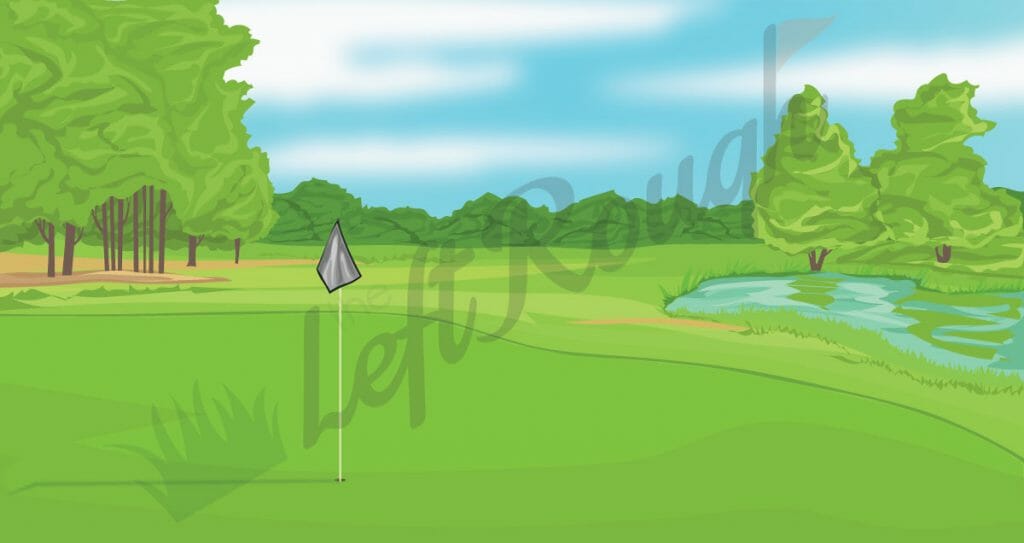
4. Aim for the Fat Part of the Green
The PGA Tour stats showed one thing to me above all else – when players hit the green, they’re not that close! Think about the GIR percentage…
- From 200+ yards they only less than 50% of the greens and still have 40 plus feet on average!
- From 150 yards, they hit a little over 60% of the greens and still have 20 plus feet.
- And from inside 100 yards, they still don’t average inside 10 feet.
So what’s the point?
If the best players in the world don’t throw darts all day (and they get paid millions of dollars to play golf), why should you?
The easiest way to hit more greens is to forget the flag entirely. Aim for the widest part of the green and I bet you will be astounded by your green in regulation numbers.
Will your playing buddies give you grief from time to time? Probably, but I bet you will also be the guy who takes their money at the end of the round too.
By aiming at the fat part of the green, you will not only hit more greens, but also short side yourself less often. So even if you miss the green, you will have an easier up and down too and not need your short game on fire every round. Not to mention, hitting greens at or above regulation percentage can help your confidence from tee to green.
As you get into wedges and short irons, then you can maybe aim more towards the flag. But for anything longer than a short iron, aim for the middle, accept a 20-30 foot putt, and keep the momentum going.
5. Track Your Stats
Finally, to hit more greens, it’s super important to track your stats . This way you can learn more about your game and figure out how to practice more efficiently. Since most of us only have so much time to work on our game , it’s important to spend it on your weaknesses.
When you track your stats, you will learn if you need to improve on the putting surface, work on your short game , long irons or hit more fairways. When tracking your round on the course, make sure to:
- Include a statistical category for fairways hit, greens in regulation, up/down percentage, and number of putts.
- Track consistently so you can get averages and practice more efficiently between rounds.
- Notate your common miss-hit as it can be used to manage your miss and quickly improve your score.
Bonus Tip: Get Better on the Putting Surface
The bonus tip isn’t about hitting greens, as the first five tips will help with that a ton. But this tip is preaching the importance of putting when you get on the dance floor.
Because there is not much more frustrating than hitting a bunch of greens and scoring poorly due to bad putting. Trust me, I’ve been there myself more times than I can count.
Putting is the not so secret part about scoring well. But I think a misunderstanding that so many golfers have is how many putts they “should” make.
PGA Tour Putting Averages
The PGA Tour average is 28.95 putts per round.
Basically, if you can keep it under 30 putts, it is usually going to be a good scoring day for most golfers.
But proximity to the hole plays a huge role in making sure you avoid three putts. Check out the 2021 putting averages too for the average professional golfer:
- 35+ Feet: .32% make percentage
- 30-35 Feet: .60% make percentage
- 25-30 Feet: .88% make percentage
- 20-25 Feet: 12% make percentage
- 15-20 Feet: 18% make percentage
- 10-15 Feet: 29% make percentage
- 5-10 Feet: 53% make percentage
- 3-5 Feet: 87% make percentage
When you hit it closer, the odds of a putt dropping are more in your favor. And the best way to give yourself more quality looks is to use the five tips from above.
Also, here are a few more additional stats that might surprise you:
- 1 Putts Per Round = 7.15
- 2 Putts Per Round = 10.08
- 3 Putts Per Round = .54 (less than one 3-putt per round)
- Avg Distance of Birdies = 9.4 feet
- Avg Distance of Eagles = 16.8 feet
FAQs About Greens in Regulation
Do you have more questions about hitting greens so you can shoot lower scores? If so, hopefully our questions and answers below can help you out even more.
What is a good percentage of greens in regulation?
It depends on your handicap and skill level more than anything else. Some players might average a few greens in regulation. While others might have a green in regulation number between 6-9 and highly skilled players will be 10 or more.
Who has the best greens in regulation on the PGA Tour?
If you’ve ever wondered “Who hits the most greens on tour” it’s a great question. The list is constantly changing on a weekly basis, but the 2021 Tour average is 64%.
That means that PGA Tour players average roughly 11 of 18 greens per round (the European Tour is about the same too). But the breakdown by distances above are a much better way to understand. Since overall distance to the pin has a much bigger impact on total score.
Click here to check out the latest stats and tournaments for GIR averages.
What’s the PGA Tour record for greens hit?
There have been tons of times when players on the Tour, LPGA Tour, and European Tour have 18/18 greens per round. This is an incredible feat in itself and obviously requires tremendous ball striking.
And the four round tournament record is 69 of 72 greens according to the Tour’s website ! Here is what they said about this crazy good performance… “As for greens in regulation, the record is 69 of 72 greens for a four-round event. The record belongs to Peter Jacobson (1995 AT&T Pebble Beach Pro-Am) and Jerry Kelly (1996 Walt Disney World Oldsmobile Classic).”
How impressive is that GIR stat? Imagine only having three attempts for saving par and 69 birdie attempts in four days.
But another amazing record is Tiger Woods from his historical season in 2000. What many have dubbed the greatest golf of his career, during that year he found 75.15% of all greens .
This is the highest GIR in regulation percentage ever since the tour began tracking GIR. His average score was also a tour record as well! Needless to say, Tiger Woods’ golf game that year was something we’ll likely never see again.
Does fringe count as a green in regulation?
No, the fringe does not count as green in regulation. Even though you can (and should) putt a majority of your fringe balls, they technically don’t count as a green on your stat sheet. But in general, putt the ball from the fringe to shoot better scores.
Final Thoughts on Greens in Regulation
Hopefully these stats will show that whenever you’re watching golf on TV, it’s basically the highlight reel. Sure, you will see the occasional bad shot on the big stage (like Ian Poulter hitting shanks) but it’s not often with pro golfers. Instead, they’re showing you the longest drives, the tightest approach shots, and the best putts.
In reality though, the majority of Tour players (both PGA and LPGA Tour) do not get it as close as you think, if they do even find the green. Which should be pretty eye-opening for the casual golfer. And if anything, it should make you feel better about your game by creating realistic expectations about your GIR number for the round.
So instead of going flag hunting 18 holes in a row, use the five tips to set yourself up for success:
- Hit more fairways by getting a go-to “fairway finder” shot and solid tee box strategy.
- Create a solid pre-shot routine to help you pick the right club and focus on the target.
- Know your distances as if you were Justin Rose or some other pro you love. A launch monitor is the easiest way to learn your distances for each club and get the ball on the green more often than not.
- Aim for the fat part of the green 90% of the time (or more). Unless you have a wedge or short iron, opt for the middle part of the largest area of the green.
- Tracks your stats so you can learn to improve your first shot and practice efficiently.
The higher your green in regulation number, the less stress you will have and likely much fewer strokes every round too.

Opinion & Analysis
The wedge guy: what we can learn from tour stats.
Today’s post was inspired by a conversation one of the Edison Golf customer service team had with a follower/challenger on Facebook. The skeptical golfer claimed that he could “hit it to 12 feet from 85 yards anytime he wanted.” His claim drove our rep to the PGA Tour website just to compare this golfer’s claim to PGA Tour reality.
His relating of this conversation and my subsequent research into tour stats inspired me to share how actual PGA Tour players’ performance might be used to help you understand your own game and how to get better, no matter whether you are a low single-digit player or still working to break 80, 90, or even 100.
The “entry point” for the research was to see how this golfer’s claims of “hitting it to 12 feet” from 85 yards would stack up to tour-level performance. Turns out this guy would be the best on tour by far if he can really do that.
INSIGHT #1: Through the entire 2021 season, only ONE tour professional averaged less than 12’ from 75-100 yards, and the tour average is almost 18 feet from that range. Now we all know that they hit it to three feet or less reasonably often, so that must mean that it is just as “normal” for tour players to hit a 75- to 100-yard wedge shot to 20-25 feet or further. In fact, just this past weekend, I saw a number of wedge shots of that distance end up 40-50 feet from the hole. It happens, even to these guys.
This revelation inspired me to dive a bit deeper into PGA Tour stats to understand the difference between hitting approach shots from the fairway and from the rough. I’ve done this deep dive periodically through my twenty years of writing this blog as “The Wedge Guy,” and the data revealed is amazing — and very enlightening.
The PGA Tour “strokes gained” analysis over the years has implied that hitting it far is much more important than hitting it straight. I won’t argue that this approach to statistics must show that, or it wouldn’t be published.
But I’ve long been an advocate for recreational golfers to find a way to get their drives in the fairway, even if it means sacrificing a few yards. There are few courses that play as easy from the rough as the fairway, and PGA Tour statistics seem to support that hypothesis, even for these guys, who have extraordinary skills and strength to gouge shots from the rough. The rest of us just do not have either. But what is the difference — for them — between hitting approach shots from the rough and the fairway? Here is a look at the entire 2021 season stats for proximity to the hole from both, from various distances:

These figures illustrate that, on average across all approach shot distances from 5-6 iron (200-225) or less, hitting their approach from the rough will increase the length of the resulting putt or chip by about 60 percent or more. The only takeaway you can make from this is that it is extremely important to these guys to be able to hit approaches from the fairway rather than the rough, regardless of what the “strokes gained” numbers seem to imply.
Even more glaring is that the average approach from 150-175 yards in 2021 ended up closer to the hole than one from the rough from only 75-100 yards from the rough! This means that tour professionals are more accurate from the fairway with a 7- or 8-iron than they are from the rough with a sand wedge. If the rough is that penalizing for them, maybe you should re-think what it does to your scoring.
I’m just sayin’…

2022 Abu Dhabi Championship Picks & Selections: Tommy Fleetwood to shine in the Gulf
2022 Sony Open prop bets: Why Kevin Na is the man to back in Hawaii
Terry Koehler is a fourth generation Texan and a graduate of Texas A&M University. Over his 40-year career in the golf industry, he has created over 100 putter designs, sets of irons and drivers, and in 2014, he put together the team that reintroduced the Ben Hogan brand to the golf equipment industry. Since the early 2000s, Terry has been a prolific writer, sharing his knowledge as “The Wedge Guy”. But his most compelling work is in the wedge category. Since he first patented his “Koehler Sole” in the early 1990s, he has been challenging “conventional wisdom” reflected in ‘tour design’ wedges. The performance of his wedge designs have stimulated other companies to move slightly more mass toward the top of the blade in their wedges, but none approach the dramatic design of his Edison Forged wedges, which have been robotically proven to significantly raise the bar for wedge performance. Terry serves as Chairman and Director of Innovation for Edison Golf – check it out at www.EdisonWedges.com.
10 Comments
Jan 15, 2022 at 7:12 pm
——————————– An curious quote from Terry:
“But I’ve long been an advocate for recreational golfers to find a way to get their drives in the fairway, even if it means SACRIFICING a few yards.” ——————————–
I’ve found that if my drive lands in the fairway, it rolls out another 20 yards or so. If it drifts into the first cut, the ball stops and doesn’t advance. So, a shot that lands in the fairway means I’m hitting an approach shot with a 7i rather than a 5i.
Overall, the article seems to be going three directions at once. Not sure what the ultimate takeaway is…
Jan 15, 2022 at 2:31 am
Sounds like Lou Stagners work I’m just sayin
Jan 15, 2022 at 1:35 am
“claimed that he could “hit it to 12 feet from 85 yards anytime he wanted.”
Do you really think someone would do that? Just go on the internet and tell lies?
Jan 14, 2022 at 8:56 pm
This article needs an editor’s review – badly. The too narrow column widths in the embedded table caused the column headers to wrap incorrectly. It’s pretty confusing, as pointed out by other reader comments. Then there is this sentence, “Even more glaring is that the average approach from 150-175 yards in 2021 ended up closer to the hole than one from the rough from only 75-100 yards from the rough!” If you are going to sell ads on these pages, stuff like this should be cleaned up before publishing.
Jan 14, 2022 at 7:25 pm
————— AS Terry noted… “But I’ve long been an advocate for recreational golfers to find a way to get their drives in the fairway, even if it means sacrificing a few yards…” —————
I would suggest that keeping drives in the fairway INCREASES net yardage. Drives in fairway will roll out an extra 20 yards, while those that land in the first cut just stop. Drifting into first cut can make my approach shot 10 to 20 yards longer than keeping a drive in the short grass.
That said, I’m not sure of the main take-away from this. Terry went about three different directions in this article.
Jan 14, 2022 at 4:24 pm
Does the Al Approaches column include approaches from the rough, which that column heading implies, or just the ones from the fairway?
Jan 14, 2022 at 4:22 pm
I confused. Does the All Approaches column include the ones from the rough, which the column heading implies, or only ones from the fairway? If it is all approaches, the ones from the fairway would be even loser, and I would like to see those distances because that would be the comparison you re trying to make.
James Kendzior
Jan 14, 2022 at 3:04 pm
Does the average yardage for “All approaches” include shots from the rough? I assume it does and, if so, that skews the results. What you should be looking at is the difference between all approach shots from the fairway vs. all approaches from the rough. The variance should be even greater.
Jan 13, 2022 at 7:44 pm
The formatting on that yardage table is almost as consistent as my swing.
Jan 13, 2022 at 3:20 pm
“Even more glaring is that the average approach from 150-175 yards in 2021 ended up closer to the hole than one from the rough from only 75-100 yards from the rough! This means that tour professionals are more accurate from the fairway with a 7- or 8-iron than they are from the rough with a sand wedge.”
75 – 100 17’6” **29’8”** 150-175 **27’10”** 45’2” ——————- The reason you still push it up the hole, is because you are trading the “risk” of losing 10′ in prox, thats a trade everyone would take.
As well, thats assuming 100% of the time laying up you’ll find the fairway, which isn’t the case, and the penalty of 150-175 if rough is likely a missed green given prox of 45’2″
In other words, get it down the hole as far as you can avoiding penalties.
Your email address will not be published. Required fields are marked *
This site uses Akismet to reduce spam. Learn how your comment data is processed .

You may like
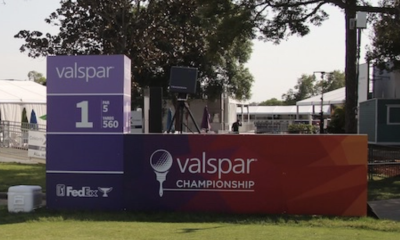
Vincenzi’s 2024 Valspar Championship betting preview: Elite ballstrikers to thrive at Copperhead
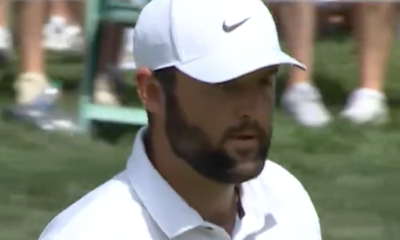
‘I really think it’s possible’ – 4-time major champ says Scottie Scheffler could win the Grand Slam in 2024
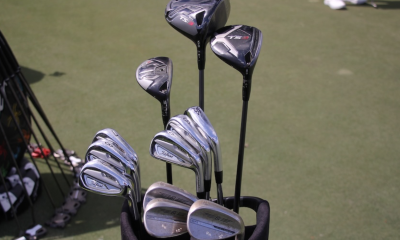
Russell Henley WITB 2024 (March)
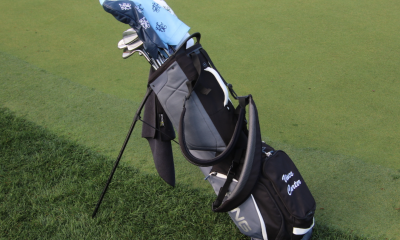
Vince Carter WITB 2024 (March)
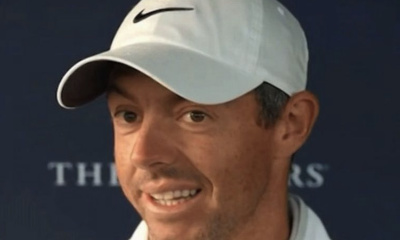
Rory McIlroy takes shot at Greg Norman while discussing Monday’s Saudi PIF meeting

Scottie Scheffler had an interesting response when asked how he ‘quiets the noise’ following Players victory
The PGA TOUR will stay in Florida this week for the 2024 Valspar Championship.
The Copperhead Course at Innisbrook Resort is a par 71 measuring 7,340 yards and features Bermudagrass greens overseeded with POA. Infamous for its difficulty, the track will be a tough test for golfers as trouble lurks all over the place. Holes 16, 17 and 18 — also known as the “Snake Pit” — make up one of the toughest three-hole stretches in golf and should lead to a captivating finish on Sunday.
The field is comprised of 156 golfers teeing it up. The field this week is solid and is a major improvement over last year’s field that felt the impact of players skipping due to a handful of “signature events” in a short span of time.
Past Winners at Valspar Championship
- 2023: Taylor Moore (-10)
- 2022: Sam Burns (-17)
- 2021: Sam Burns (-17)
- 2019: Paul Casey (-8)
- 2018: Paul Casey (-10)
- 2017: Adam Hadwin (-14)
- 2016: Charl Schwartzel (-7)
- 2015: Jordan Spieth (-10)
In this article and going forward, I’ll be using the Rabbit Hole by Betsperts Golf data engine to develop my custom model. If you want to build your own model or check out all of the detailed stats, you can sign up using promo code: MATTVIN for 25% off any subscription package (yearly is best value).
Key Stats For Copperhead
1. strokes gained: approach.
Strokes Gained: Approach grades out as the most important statistic once again this week. Copperhead really can’t be overpowered and is a second-shot golf course.
Total SG: Approach Over Past 24 Rounds (per round)
- Tony Finau (+.90)
- Nick Taylor (+.81)
- Justin Thomas (+.77)
- Greyson Sigg (+.69)
- Christiaan Bezuidenhout (+.67)
2. Good Drive %
The long hitters can be a bit limited here due to the tree-lined fairways and penal rough. Playing from the fairways will be important, but laying back too far will cause some difficult approaches with firm greens that may not hold shots from long irons.
Golfers who have a good balance of distance and accuracy have the best chance this week.
Good Drive % Over Past 24 Rounds
- Brice Garnett (+91.3%)
- Zach Johnson (+91.1%)
- Sam Ryder (+90.5%)
- Ryan Moore (+90.4%)
- Aaron Rai (+89.7%)
3. Strokes Gained: Ball Striking
Adding ball-striking puts even more of a premium on tee-to-green prowess in the statistical model this week. Golfers who rank highly in ball-striking are in total control of the golf ball which is exceedingly important at Copperhead.
SG: Ball Striking Over Past 24 Rounds:
- Xander Schauffele (+1.32)
- Keith Mitchell (+1.29)
- Tony Finau (+1.24)
- Cameron Young (+1.17)
- Doug Ghim (+.95)
4. Bogey Avoidance
With the conditions likely to be difficult, avoiding bogeys will be crucial this week. In a challenging event like the Valspar, oftentimes the golfer who is best at avoiding mistakes ends up on top.
Gritty golfers who can grind out difficult pars have a much better chance in an event like this than a low-scoring birdie-fest.
Bogey Avoidance Over Past 24 Rounds
- Brice Garnett (+9.0)
- Xander Schauffele (+9.3)
- Austin Cook (+9.7)
- Chesson Hadley (+10.0)
- Greyson Sigg (+10.2)
5. Strokes Gained: Total in Difficult Conditions
Conditions will be tough this week at Copperhead. I am looking for golfers who can rise to the occasion if the course plays as difficult as it has in the past.
Strokes Gained: Total in Difficult Conditions Over Past 24 rounds
- Xander Schauffele (+1,71)
- Min Woo Lee (+1.39)
- Cameron Young (+1.27)
- Jordan Spieth (+1.08)
- Justin Suh (+.94)
6. Course History
That statistic will tell us which players have played well at Copperhead in the past.
Course History Over Past 24 rounds
- Patrick Cantlay (+3.75)
- Sam Burns (+2.49)
- Davis Riley (+2.33)
- Matt NeSmith (+2.22)
- Jordan Spieth (+2.04)
The Valspar Championship Model Rankings
Below, I’ve compiled overall model rankings using a combination of the five key statistical categories previously discussed — SG: Approach (27%), Good Drive % (15%), SG: BS (20%), Bogeys Avoided (13%), Course History (13%) Strokes Gained: Total in Difficult Conditions (12%).
- Xander Schauffele
- Victor Perez
- Greyson Sigg
- Justin Thomas
- Lucas Glover
2024 Valspar Championship Picks
Justin thomas +1400 ( draftkings ).
Justin Thomas will be disappointed with his finish at last week’s PLAYERS Championship, as the past champion missed the cut despite being in some decent form heading into the event. Despite the missed cut, JT hit the ball really well. In his two rounds, the two-time major champion led the field in Strokes Gained: Approach per round.
Thomas has been up and down this season. He’s missed the cut in two “signature events” but also has finishes of T12 at the Arnold Palmer Invitational, T12 at the Waste Management Phoenix Open, T6 at the Pebble Beach AT&T Pro-Am and T3 at the American Express. In his past 24 rounds, he ranks 3rd in the field in Strokes Gained: Approach and 6th in Strokes Gained: Ball Striking in the field.
Thomas loves Copperhead. In his last three tries at the course, he’s finished T13, T3 and T10. Thomas would have loved to get a win at a big event early in the season, but avoidable mistakes and a balky putter have cost him dearly. I believe a trip to a course he loves in a field he should be able to capitalize on is the right recipe for JT to right the ship.
Christiaan Bezuidenhout +6000 ( FanDuel )
Christiaan Bezuidenhout is playing spectacular golf in the 2024 season. He finished 2nd at the American Express, T20 at Pebble Beach and T24 at the Genesis Invitational before finishing T13 at last week’s PLAYERS Championship.
In his past 24 rounds, the South African ranks 3rd in the field in Strokes Gained: Approach and 26th in Strokes Gained: Ball Striking. Bezuidenhout managed to work his way around TPC Sawgrass last week with minimal damage. He only made five bogeys in the entire week, which is a great sign heading into a difficult Copperhead this week.
Bezuidenhout is winless in his PGA Tour career, but certainly has the talent to win on Tour. His recent iron play tells me that this week could be a breakthrough for the 35-year-old who has eyes on the President’s Cup.
Doug Ghim +8000 ( FanDuel )
Doug Ghim has finished in the top-16 of his past five starts. Most recently, Ghim finished T16 at The PLAYERS Championship in a loaded field.
In his past 24 rounds, Ghim ranks 8th in Strokes Gained: Approach and 5th in Strokes Gained: Ball Striking. In terms of his fit for Copperhead, the 27-year-old ranks 12th in Bogey Avoidance and 7th in Strokes Gained: Total in Difficult Conditions, making him a great fit for the course.
Ghim has yet to win on Tour, but at one point he was the top ranked Amateur golfer in the world and played in the 2017 Arnold Palmer Cup and 2017 Walker Cup. He then won the Ben Hogan award for the best male college golfer in 2018. He certainly has the talent, and there are signals aplenty that his talent in ready to take him to the winner’s circle on the PGA Tour.
Sepp Straka +8000 ( BetRivers )
Sepp Straka is a player who’s shown he has the type of game that can translate to a difficult Florida golf course. The former Presidents Cup participant won the 2022 Honda Classic in tough conditions and should thrive with a similar test at Copperhead.
It’s been a slow 2024 for Straka, but his performance last week at the PLAYERS Championship surely provides some optimism. He gained 5.4 strokes on approach as well as 1.88 strokes off the tee. The tee-to-green game Straka showed on a course with plenty of danger demonstrates that he can stay in control of his golf ball this week.
It’s possible that the strong performance last week was an outlier, but I’m willing to bet on a proven winner in a weaker field at a great number.
Victor Perez +12000 ( FanDuel )
Victor Perez is no stranger to success in professional golf. The Frenchman has three DP World Tour wins including a Rolex Series event. He won the 2019 Alfred Dunhill Links Championship, as well as the 2023 Abu Dhabi HSBC Championship, which are some big events.
Perez earned his PGA Tour card this season and enters the week playing some fantastic golf. He finished in a tie for 16th in Florida at the Cognizant Classic and then tied for third in his most recent start at the Puerto Rico Open.
In his past 24 rounds in the field, Perez ranks 11th in Strokes Gained: Approach, 1oth in Strokes Gained: Ball Striking, 6th in Good Drive % and 15th in Bogey Avoidance.
Perez comes in as a perfect fit for Copperhead and offers serious value at triple-digit odds.
Myrtle Beach, Explored: February in South Carolina
As I gain in experience and age, and familiarity breeds neither contempt nor disdain, I understand why people return to a place. A destination like Myrtle Beach offers a sizable supply and diversity of restaurants, entertainment venues, and shops that are predicated on the tenets of the service industry. Greet your customers with a smile and a kind word, and they will find comfort and assurance. Provide them with a memorable experience and they will suggest your place of business to others.
My first tour of Myrtle Beach took place in the mid-1980s, and consisted of one course: Gator Hole. I don’t remember much from that day, and since Gator Hole closed a decade later, I cannot revisit it to recollect what I’d lost. Since then, I’ve come to the Grand Strand a few times, and been fortunate to never place a course more than once. I’ve seen the Strantz courses to the south and dipped my toe in the North Carolina courses of Calabash. I’ve been to many in the middle, including Dunes, Pine Lakes, Grande Dunes among them.
2024 brought a quartet of new courses, including two at the Barefoot Resort. I’d heard about the North Myrtle Beach four-pack of courses that highlight the Barefoot property, including layouts from Pete Dye, Tom Fazio, Davis Love III, and Greg Norman. I had the opportunity to play and shoot the Dye and Fazio tracks, which means that I’ll have to return to see the other two. Sandwiched between them were the TPC-Myrtle Beach course, also from Tom Fazio, and the Pawley’s Plantation trace, by the hand of Jack Nicklaus. I anticipated a bit of the heroic, and bit of the strategic, and plenty of eye candy. None of those architects would ever be considered a minimalist, so there would be plenty of in-play and out-of-play bunkers and mounds to tantalize the senses.
My nephew arrived a few days early, to screen a few more courses. As a result, you the reader will have an extra quarter of mini-reviews, bringing the total of courses in this piece to eight. It was inconceivable that CJR would play four courses that I had never played nor photographed, but that was the case. His words appear at the end of this piece. We hope that you enjoy the tour.
Main Feature: Two Barefoots, a TPC, and Pawley’s Plantation
Barefoot Dye
What Paul “Pete” Dye brought back from his trips to the United Kingdom, hearkened back to what C.B. MacDonal did, some 65 years prior. There is a way of finding bunkers and fairways, and even green sites, that does not require major industrial work. The Dye course at Barefoot Resorts takes you on a journey over the rumpled terrain of distant places. If there’s one element missing, it’s the creased and turbulent fairways, so often found in England and Ireland. The one tenet of playing a Dye course, is to always aim away from temptation, from where your eyes draw you. Find the safe side of the target, and you’ll probably find your ball. It then stands that you will have a shot for your next attempt. Cut the corner, and you might have need to reload. The Barefoot course begins gently, in terms of distance, but challenges with visual deception. After two brief 4s and a 3, the real work begins. The course is exposed enough, to allow the coastal winds to dance along the fairways. Be ready to keep the ball low and take an extra club or two.
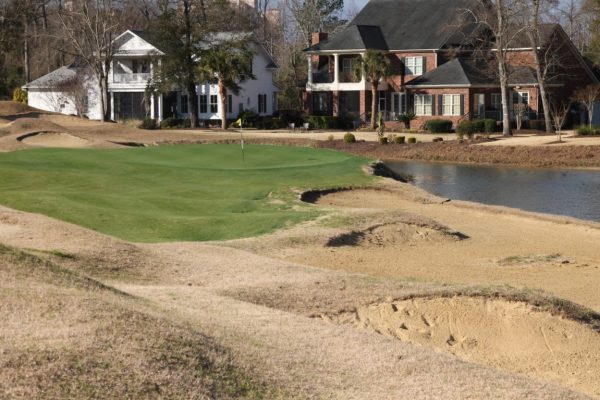
TPC-Myrtle Beach
If memory serves, TPCMB is my first trek around a TPC-branded course. It had all the trappings of a tour course, from the welcome, through the clubhouse, to the practice facilities and, of course, the course. TPC-Myrtle Beach is a Tom Fazio design, and if you never visit Augusta National, you’ll now have an idea of what it is like. You play Augusta’s 16th hole twice at TPCMB, and you enjoy it both times. Fazio really likes the pond-left, green-angle-around par three hole, and his two iterations of it are memorable.
You’ll also see those Augusta bunkers, the ones with the manicured edges that drop into a modestly-circular form. What distinguishes these sand pits is the manner in which they rise from the surrounding ground. They are unique in that they don’t resemble the geometric bunkering of a Seth Raynor, nor the organic pits found in origin courses. They are built, make no mistake, and recovery from them is manageable for all levels of bunker wizardry.
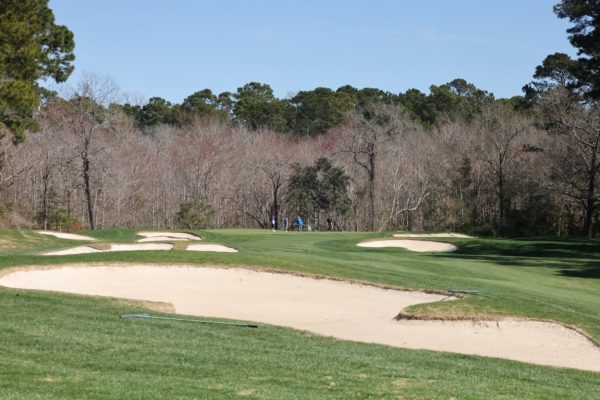
Barefoot Fazio
If you have the opportunity to play the two Tom Fazio courses back to back, you’ll notice a marked difference in styling. Let me digress for a moment, then circle back with an explanation. It was written that the NLE World Woods course designed by Fazio, Pine Barrens, was an homage to Pine Valley, the legendary, New Jersey club where Fazio is both a member and the architect on retainer. The Pine Barrens course was plowed under in 2022, so the homage no longer exists. At least, I didn’t think that it existed, until I played his Barefoot Resort course in North Myrtle Beach.
Pine Valley might be described as an aesthetic of scrub and sand. There are mighty, forced carries to travers, along with sempiternal, sandy lairs to avoid. Barefoot Fazio is quite similar. If you’re not faced with a forced carry, you’ll certainly contend with a fairway border or greenside necklace of sand. When you reach the 13th tee, you’ll face a drive into a fairway, and you might see a distant green, with a notable absence: flagstick. The 13th is the icing on the homage cake, a callout of the 8th hole at Pine Valley. Numero Ocho at the OG has two greens, side by side, and they change the manner in which the hole plays (so they say.) At Barefoot Fazio, the right-side green is a traditional approach, with an unimpeded run of fairway to putting surface. The left-side green (the one that I was fortunate to play) demands a pitch shot over a wasteland. It’s a fitting tribute for the rest of us to play.
Be certain to parrot the starter, Leon’s, advice, and play up a deck of tees. Barefoot Fazio offers five par-three holes, so the fours and fives play that much longer. Remember, too, that you are on vacation. Why not treat yourself to some birdie looks?
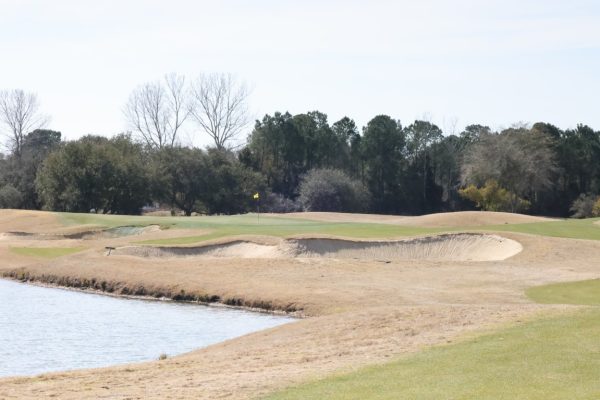
Pawley’s Plantation
The Jack Nicklaus course at Pawley’s Plantation emerged from a period of hibernation in 2024. The greens were torn up and their original contours were restored. Work was overseen by Troy Vincent, a member of the Nicklaus Architecture team. In addition, the putting corridors were reseeded with a hardier, dwarf bermuda that has experienced great success, all along the Grand Strand that is Myrtle Beach.
My visit allowed me to see the inward half first, and I understand why the resort wishes to conclude your day on those holes. The front nine of Pawley’s Plantation works its way through familiar, low country trees and wetlands. The back nine begins in similar fashion, then makes its way east, toward the marsh that separates mainland from Pawley’s Island. Recalling the powerful sun of that Wednesday morning, any round beginning on the second nine would face collateral damage from the warming star. Much better to hit holes 11 to close when the sun is higher in the sky.
The marshland holes (12 through 17) are spectacular in their raw, unprotected nature. The winds off the Atlantic are unrelenting and unforgiving, and the twin, par-three holes will remain in your memory banks for time’s march. In typical Golden Bear fashion, a majority of his putting targets are smallish in nature, reflecting his appreciation for accurate approach shots. Be sure to find the forgiving side of each green, and err to that portion. You’ll be grateful.
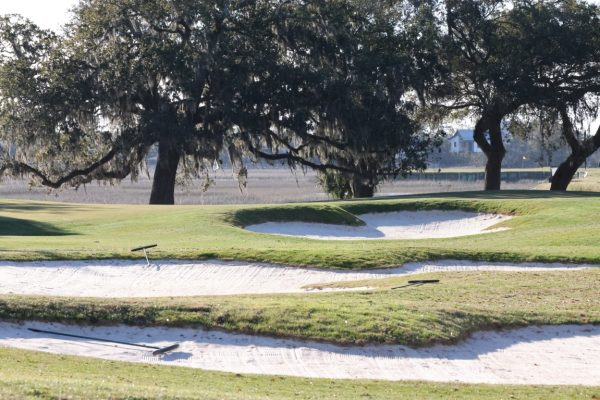
Bonus Coverage: Myrtlewood, Beechwood, Arrowhead, and King’s North
Arrowhead (Raymond Floyd and Tom Jackson)
A course built in the middle of a community, water threatens on most every hole. The Cypress 9 provides a few holes forcing a carried drive then challenge you with water surrounding the green. On Waterway, a drivable 2nd hole will tempt most, so make sure the group ahead has cleared the green.
Myrtlewood ( Edmund Alt and Arthur Hills) and Beechwood (Gene Hamm)
A middle of the winter New Englander’s paradise. Wide open fairways, zero blind shots and light rough allow for shaking off the rust and plenty of forgiveness. A plethora of dog legs cause one to be cautious with every tee shot. Won’t break the bank nor the scorecard.
King’s North @ Myrtle Beach National (Arnold Palmer)
Vincenzi’s 2024 Players Championship betting preview: Pete Dye specialists ready to pass tough TPC Sawgrass test
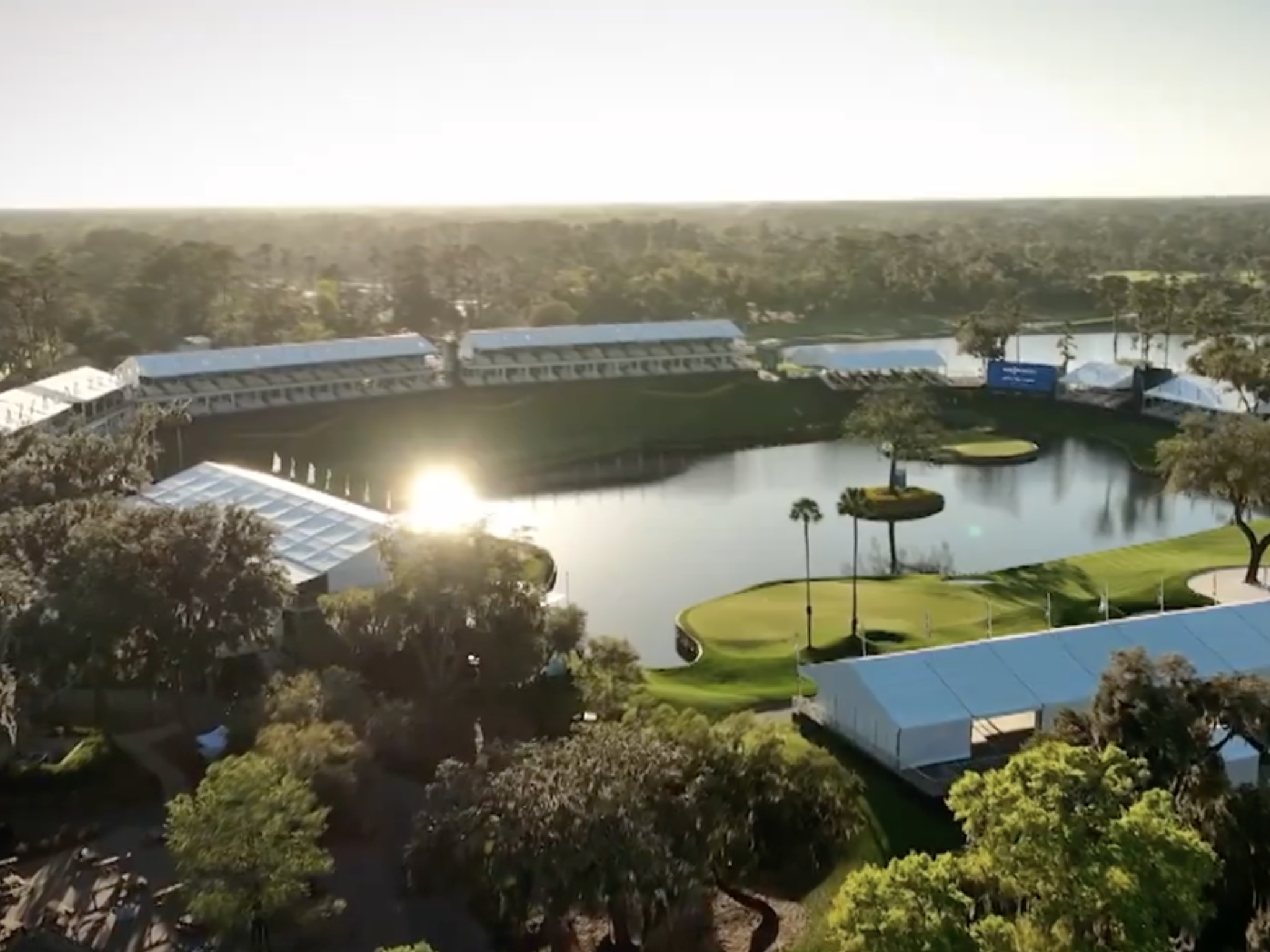
The PGA Tour heads to TPC Sawgrass to play in one of the most prestigious and important events of the season: THE PLAYERS Championship. Often referred to as the fifth major, the importance of a PLAYERS victory to the legacy of a golfer can’t be overlooked.
TPC Sawgrass is a par-72 measuring 7,245 yards and featuring Bermudagrass greens. Golfers must be patient in attacking this Pete Dye course.
With trouble lurking at every turn, the strokes can add up quickly. With a par-5 16th that is a true risk-reward hole and the famous par-3 17th island green, the only safe bet at TPC Sawgrass is a bet on an exciting finish.
THE PLAYERS Championship field is often referred to as the strongest field of the year — and with good reason. There are 144 in the field, including 43 of the world’s top 50 players in the OWGR. Tiger Woods will not be playing in the event.
THE PLAYERS is an exceptionally volatile event that has never seen a back-to-back winner.
Past Winners at TPC Sawgrass
- 2023: Scottie Scheffler (-17)
- 2022: Cameron Smith (-13)
- 2021: Justin Thomas (-14)
- 2019: Rory McIlroy (-16)
- 2018: Webb Simpson (-18)
- 2017: Si-Woo Kim (-10)
- 2016: Jason Day (-15)
- 2015: Rickie Fowler (-12) In this article and going forward, I’ll be using the Rabbit Hole by Betsperts Golf data engine to develop my custom model. If you want to build your own model or check out all of the detailed stats, you can sign up using promo code: MATTVIN for 25% off any subscription package (yearly is best value).
5 Key Stats for TPC Sawgrass
Let’s take a look at five metrics key for TPC Sawgrass to determine which golfers boast top marks in each category over their last 24 rounds.
Strokes Gained: Approach has historically been far and away the most important and predictive stat at THE PLAYERS Championship. With water everywhere, golfers can’t afford to be wild with their iron shots. Not only is it essential to avoid the water, but it will also be as important to go after pins and make birdies because scores can get relatively low.
Total SG: Approach Over Past 24 Rounds
- Tom Hoge (+1.37)
- Scottie Scheffler (+1.20)
- Tony Finau (+0.99)
- Jake Knapp (+0.83)
- Shane Lowry (+0.80)
2. Total Driving
This statistic is perfect for TPC Sawgrass. Historically, driving distance hasn’t been a major factor, but since the date switch to March, it’s a bit more significant. During this time of year, the ball won’t carry quite as far, and the runout is also shorter.
Driving accuracy is also crucial due to all of the trouble golfers can get into off of the tee. Therefore, players who are gaining on the field with Total Driving will put themselves in an ideal spot this week.
Total Driving Over Past 24 Rounds
- Rory McIlroy (22)
- Akshay Bhatia (25)
- Keith Mitchell (25)
- Adam Hadwin (34)
- Sam Burns (+39)
3. Strokes Gained: Total at Pete Dye Designs
TPC Sawgrass may be Pete Dye’s most famous design, and for good reason. The course features Dye’s typical shaved runoff areas and tricky green complexes. Pete Dye specialists love TPC Sawgrass and should have a major advantage this week.
SG: Total (Pete Dye) per round over past 36 rounds:
- Patrick Cantlay (+2.02)
- Scottie Scheffler (+1.90)
- Min Woo Lee (+1.77)
- Sungjae Im ( +1.72)
- Brian Harman (+1.62)
4. Strokes Gained: Ball Striking
Prototypical ball-strikers have dominated TPC Sawgrass. With past winners like Sergio Garcia, Henrik Stenson, Webb Simpson, Rory McIlroy and Justin Thomas, it’s evident that golfers must be striking it pure to contend at THE PLAYERS.
SG: Ball Striking Over Past 24 Rounds
- Scottie Scheffler (+2.02)
- Tony Finau (+1.51)
- Tom Hoge (+1.48)
- Keith Mitchell (+1.38)
- Will Zalatoris (+1.18)
5. Par 5 Average
Par-5 average is extremely important at TPC Sawgrass. With all four of the Par-5s under 575 yards, and three of them under 540 yards, a good amount of the scoring needs to come from these holes collectively.
Par 5 Average Over Past 24 Rounds
- Scottie Schefler (+4.31)
- Erik Van Rooyen (+4.35)
- Doug Ghim (+4.34)
- Wyndham Clark (+4.34)
- Matt Fitzpatrick (+4.31)
6. Strokes Gained: Florida
We’ve used this statistic over the past few weeks, and I’d like to incorporate some players who do well in Florida into this week’s model as well.
Strokes Gained: Florida over past 30 rounds:
- Scottie Schefler (+2.43)
- Erik Van Rooyen (+1.78)
- Doug Ghim (+1.78)
- Wyndham Clark (+1.73)
- Matt Fitzpatrick (+1.69)
7. Strokes Gained: Total on Courses with High Water Danger
With water everywhere at TPC Sawgrass, the blow-up potential is high. It can’t hurt to factor in some players who’ve avoided the “eject” button most often in the past.
Strokes Gained: Total on Courses with High Water Danger over past 30 rounds:
- Scottie Schefler (+2.08)
- Rory McIlroy (+1.82)
- Tony Finau (+1.62)
- Patrick Cantlay (+1.51)
- Will Zalatoris (+1.49)
THE PLAYERS Championship Model Rankings
Below, I’ve compiled overall model rankings using a combination of the five key statistical categories previously discussed — SG: Approach (25%), Total Driving (20%), SG: Total Pete Dye (14%), SG: Ball-striking (15%) SG: Par 5 (8%), SG: Florida (10%) and SG: High Water (8%).
- Scottie Scheffler
- Shane Lowry
- Tony Finau
- Corey Conners
- Keith Mitchell
- Will Zalatoris
- Cameron Young
- Collin Morikawa
- Wyndham Clark
2024 THE PLAYERS Championship Picks
(All odds at the time of writing)
Patrick Cantlay +2500 (DraftKings):
Patrick Cantlay is winless since the 2022 BMW Championship but is undoubtedly one of the most talented players on the PGA Tour. Since the win at Wilmington Country Club, the 31-year-old has twelve top-10 finishes on Tour and is starting to round into form for the 2024 season.
Cantlay has done well in the most recent “signature” events this season, finishing 4th at Riviera for the Genesis Invitational and 12th at Bay Hill for the Arnold Palmer Invitational. The former Tour Championship winner resides in Jupiter, Florida and has played some good golf in the state, including finishing in a tie for 4th at the 2023 Arnold Palmer Invitational. His history at TPC Sawgrass has been up and down, but his best career start at The PLAYERS came last year when he finished in a tie for 19th.
Cantlay absolutely loves Pete Dye designed courses and ranks 1st in the field in Strokes Gained: Total on Dye tracks in his past 36 rounds. In recent years, he’s been excellent at both the RBC Heritage and the Travelers Championship. TPC Sawgrass is a place where players will have to be dialed in with their irons and distance off the tee won’t be quite as important. In his past 24, rounds, Cantlay ranks in the field in Strokes Gained: Approach.
Despite being winless in recent years, I still believe Cantlay is capable of winning big tournaments. As one of the only United States players to bring their best game to Marco Simone for the Ryder Cup, I have conviction that the former top amateur in the world can deliver when stakes are high.
Will Zalatoris +3000 (FanDuel):
In order to win at TPC Sawgrass, players will need to be in total control of their golf ball. At the moment, Will Zalatoris is hitting it as well as almost anyone and finally has the putter cooperating with his new switch to the broomstick style.
Zalatoris is coming off back-to-back starts where he absolutely striped the ball. He finished 2nd at the Genesis Invitational and 4th at the Arnold Palmer Invitational where his statistics were eye opening. For the week at Bay Hill, Zal gained 5.0 strokes on approach and 5.44 strokes off the tee.
Throughout the early part of his career, Zalatoris has established himself by playing his best golf in the strongest fields with the most difficult conditions. A tough test will allow him to separate himself this week and breakthrough for a PLAYERS Championship victory.
Shane Lowry +4000 (DraftKings):
History has shown us that players need to be in good form to win the PLAYERS Championship and it’s hard to find anyone not named Scottie Scheffler who’s in better form that Shane Lowry at the moment. He finished T4 at the Cognizant Classic followed by a solo third place finish at the Arnold Palmer Invitational.
The fact that the Irishman contended at Bay Hill is a great sign considering he’s really struggled there throughout his career. He will now head to a different style of course in Florida where he’s had a good deal of success. He finished 8th at TPC Sawgrass in 2021 and 13th in 2022.
Lowry ranks 6th in the field in approach in his past 24 rounds, 7th in Strokes Gained: Total at Pete Dye designed courses in his last 30 rounds, 8th in par 5 scoring this season, and 4th in Strokes Gained: Total in Florida over his past 36 rounds.
Lowry is a player who’s capable of winning big events. He’s a major champion and won another premier event at Wentworth as well as a WGC at Firestone. He’s also a form player, when he wins it’s typically when he’s contended in recent starts. He’s been terrific thus far in Florida and he should get into contention once again this week.
Brian Harman +8000 (DraftKings):
(Note: Since writing this Harman’s odds have plummeted to 50-1. I would not advise betting the 50).
Brian Harman showed us last season that if the course isn’t extremely long, he has the accuracy both off the tee and with his irons to compete with anyone in the world. Last week at Bay Hill and was third in the field in Strokes Gained: Approach, gaining 5.54 strokes on the field in the category.
In addition to the strong iron play, Harman also gained strokes off the tee in three of four rounds. He’s also had success at Pete Dye tracks recently. He finished 2nd at last year’s Travelers Championship and 7th at the RBC Heritage.
It would be a magnificent feat for Harman to win both the Open Championship and PLAYERS in a short time frame, but the reality is the PGA Tour isn’t quite as strong as it once was. Harman is a player who shows up for the biggest events and his odds seem way too long for his recent track record.
Tony Finau +6500 (FanDuel):
A few weeks ago, at the Genesis Invitational, I bet Hideki Matsuyama because I believed it to be a “bet the number” play at 80-1. I feel similarly about Finau this week. While he’s not having the season many people expected of him, he is playing better than these odds would indicate.
This season, Tony has a tied for 6th place finish at Torrey Pines, a tied for 19th at Riviera and tied for 13th at the Mexico Open. He’s also hitting the ball extremely well. In the field in his past 24 rounds, he ranks 3rd in Strokes Gained: Approach, 3rd in Strokes Gained: Ball Striking, 6th in Par 5 average and 15th in Total Driving.
Finau’s problem has been with the putter, which has been undeniably horrific. However, this week he will see a putting surface similar to the POA at TPC Scottsdale and PGA West, which he’s had a great deal of success on. It’s worth taking a stab at this price to see if he can have a mediocre week with the flat stick.
Sungjae Im +9000 (FanDuel) :
It’s been a lackluster eighteen months for Sungjae, who once appeared to be a certain star. While his ceiling is absolutely still there, it’s been a while since we’ve seen Im play the type of golf expected of a player with his talent.
Despite the obvious concerns, the South Korean showed glimpses of a return to form last week at the Arnold Palmer Invitational. He tied for 18th place and gained strokes off the tee, on approach, around the green and with the putter. When at his best, Im is a perfect course fit for TPC Sawgrass. He has remarkable precision off the tee, can get dialed in with his irons on shorter courses and can get up and down with the best players on Tour.
This number has gotten to the point where I feel comfortable taking a shot on it.
Billy Horschel +20000 (FanDuel):
Billy Horschel is a great fit on paper for TPC Sawgrass. He can get dialed in with his irons and his lack of distance off the tee won’t be a major detriment at the course. “Bermuda Billy” does his best work putting on Bermudagrass greens and he appears to be rounding into form just in time to compete at The PLAYERS.
In his most recent start, Billy finished in a tie for 9th at the Cognizant Classic and hit the ball extremely well. The former Florida Gator gained 3.32 strokes on approach and 2.04 strokes off the tee. If Horschel brings that type of ball striking to TPC Sawgrass, he has the type of putter who can win a golf tournament.
Horschel has been great on Pete Dye designed courses, with four of his seven career PGA Tour wins coming on Dye tracks.
In a season that has seen multiple long shots win big events, the 37-year-old is worth a stab considering his knack for playing in Florida and winning big events.

The Wedge Guy: Golf mastery begins with your wedge game

Tour pro calls Anthony Kim a ‘f*****g idiot’ following Instagram comeback post

Insider photos from Tiger Woods’ launch event for his new “Sun Day Red” apparel line

Brandel Chamblee outlines what his tough road back to PGA Tour would look like for LIV pros

This Rory McIlroy post-round ‘The Match’ moment is going viral…but all is likely not what it seems

Anthony Kim WITB 2024 (February)

Tour Edge unveils new Hot Launch 524 Series of golf clubs

Scottie Scheffler WITB 2024 (March)

Tiger Woods opts for veteran caddie to loop for him this week at Riviera

Anthony Kim’s speculated LIV Golf sign-on fee may surprise you
Russell Henley WITB accurate as of the Cognizant Classic. Driver: Titleist TSi3 (10 degrees, B1 SureFit setting) Shaft: Project X...
The NBA legend was teeing it up in the Arnold Palmer Invitational Pro-Am. Driver: Ping G430 Max 10K (9 degrees)...
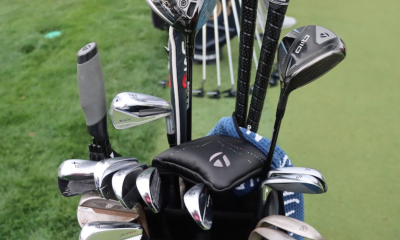
Scottie Scheffler’s winning WITB: 2024 Players Championship
Driver: TaylorMade Qi10 (8 degrees @8.25) Buy here. Shaft: Fujikura Ventus Black 7 X (45 inches) 3-wood: TaylorMade Qi10 (15...
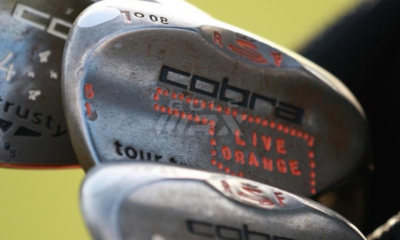
WITB Time Machine: Rickie Fowler’s winning WITB, 2015 Players Championship
At the 2015 Players Championship, Rickie Fowler captured his elusive “big win” in steely fashion, battling Sergio Garcia and Kevin...

Photos from the 2024 Arnold Palmer Invitational
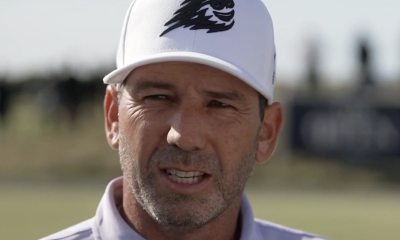
The total sum that Sergio Garcia needs to pay in fines if he wants to return to DP World Tour revealed
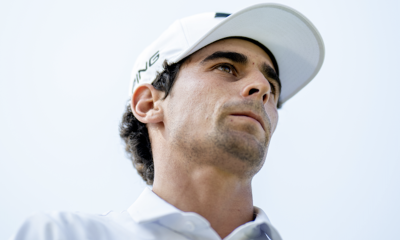
Joaquin Niemann names 3 PGA Tour events he’d love to play each year ‘in a perfect world’
Valspar Championship
Innisbrook Resort (Copperhead Course)
PGA Tour Stats: Who's the best on approach shots inside 100 yards?
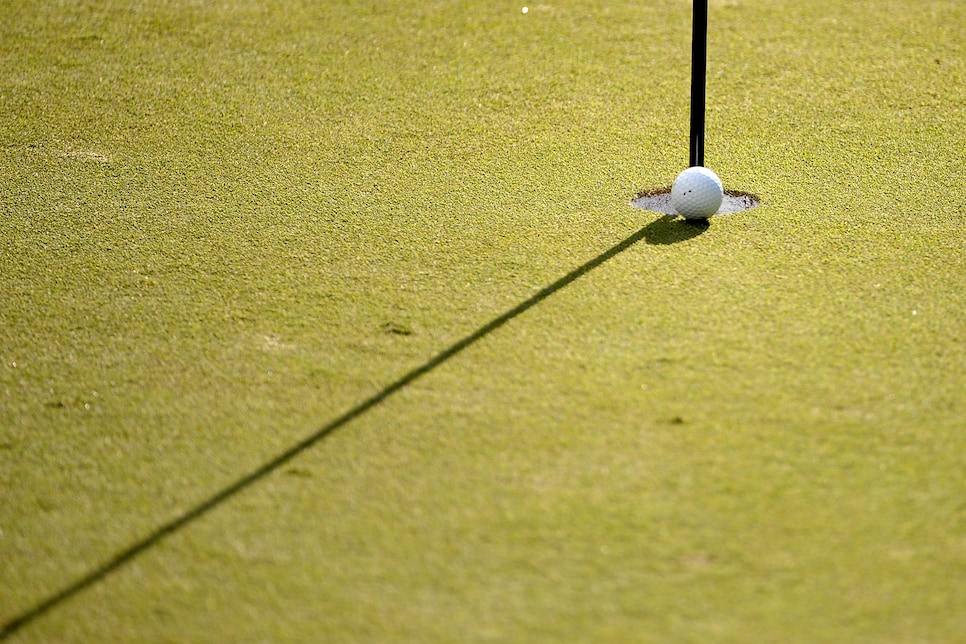
Photo by Robert Laberge/Getty Images
Bubba Watson won the Travelers Championship by knocking a 73-yard lob wedge to within a foot or two on the 72nd hole to finish with a clinching birdie. Watson’s shot not only won the tournament for him, but brought to mind how important it is for tour pros to knock it close when they're inside 100 yards. Though bombing tee shots seem to get the most attention, it all goes for naught if the player can’t knock the subsequent approach close. With that in mind, we take a look at the top five in approach-shot proximity from inside 100 yards and the lob wedges they use.
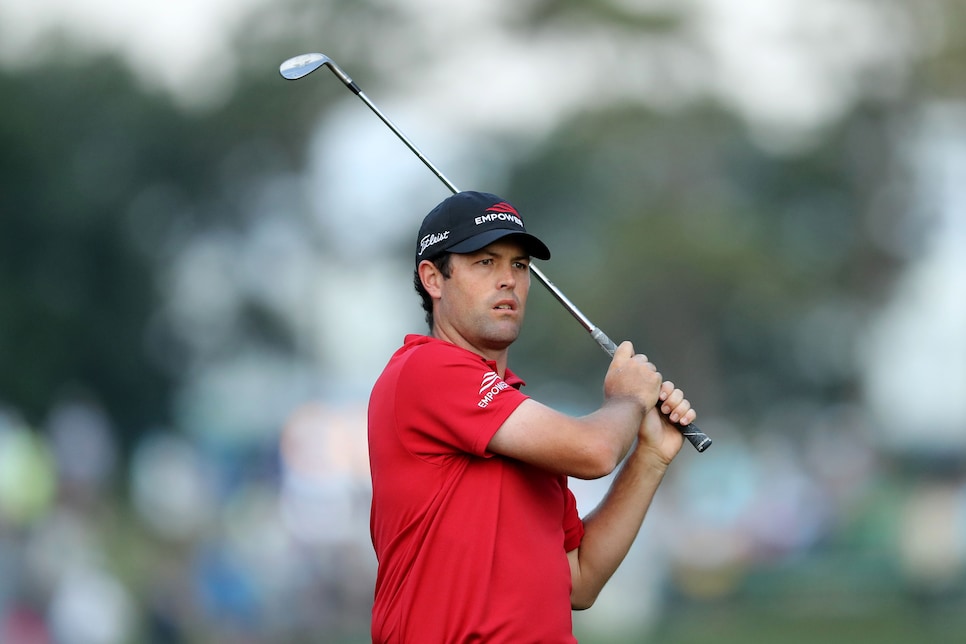
David Cannon

Andrew Redington

RELATED: PGA Tour stats: The top-5 leaders in greens in regulation ahead of the U.S. Open
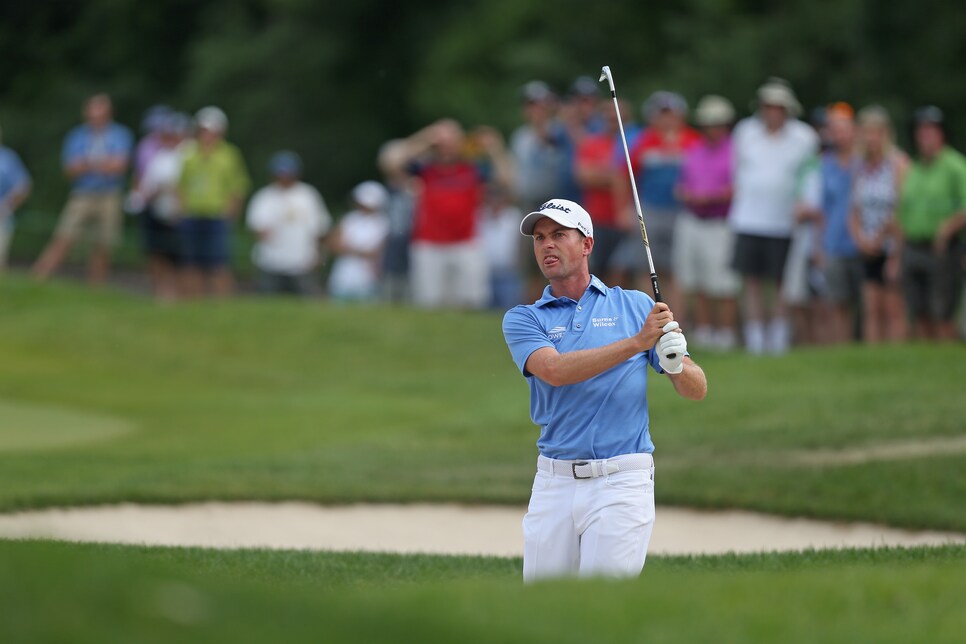
Matt Sullivan
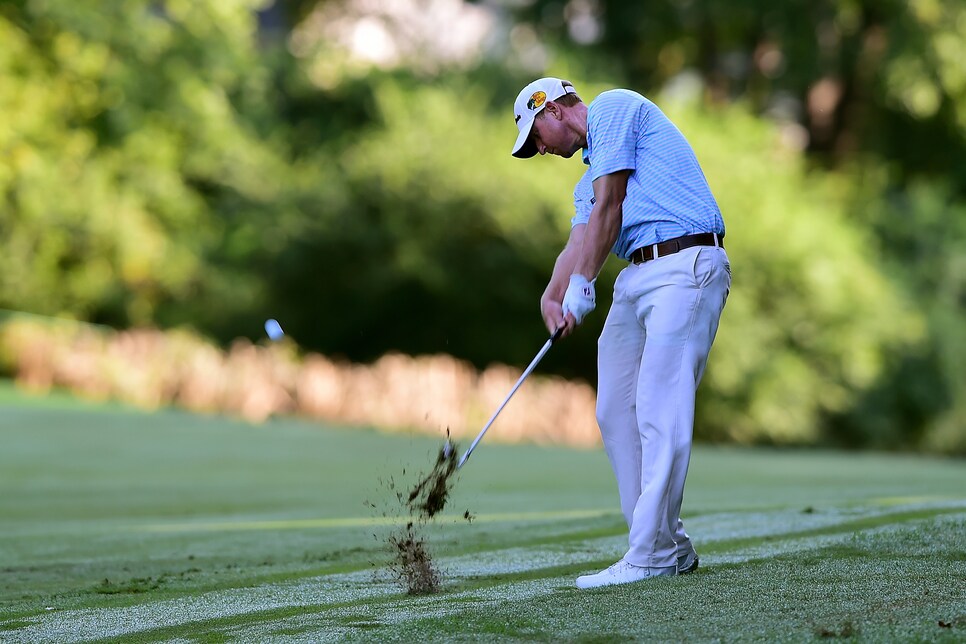
Jared C. Tilton
RELATED: PGA Tour stats: The top 5 players in proximity to the hole and the irons they use
More from Golf Digest
Trending now.
Golf Insider is reader-supported. When you buy through links on our site, we may earn an affiliate commission l earn more here

How Good Do Your Approach Shots Need To Be?
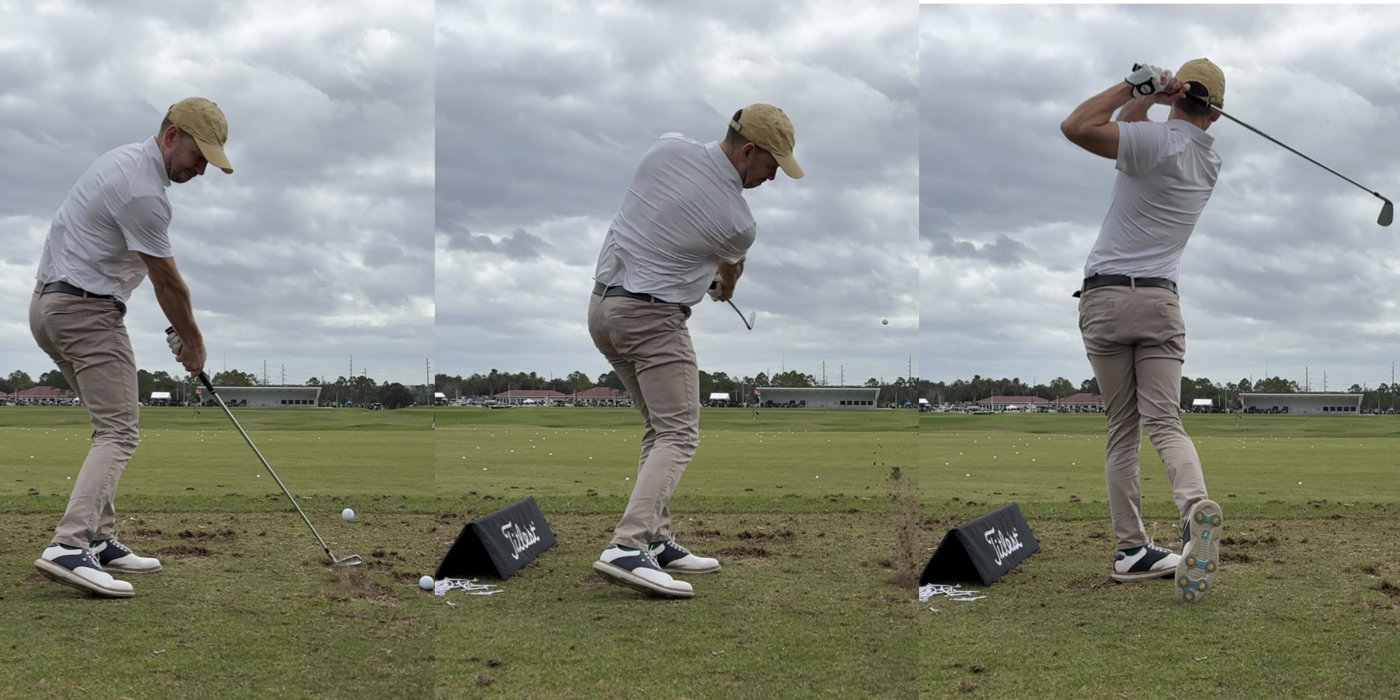
It is one thing to know you’re not good enough at a skill, it’s another to know exactly what your targets should be. Many golfers struggle with their approach shots into the greens, but few know what they should aim for.
In this article, we’re going to look at approach play data from the best players on the PGA Tour before we share data trends from club golfers. A big thanks to ShotScope for letting us share their insights.
The aim is to help you understand what golfers’ approach play looks like and to help you understand what your goals should be at your current level.
PGA Tour Approach Play
Let’s start by looking at the best in the world when it comes to approach play. Below are some snapshots of data from the PGA Tour last year (so we have a full season’s data).

100-125 yards
When we turn on the TV we’re used to seeing players pepper the pin with their wedges, however we’ve got to remember we are watching the outliers that week, the winners.
On average PGA Tour Pros hit 75.4% of greens from 100 to 125 yards away from the fairway. To put this another way, they miss 1 in 4 greens from the fairway with a wedge in hand.
The best last season was Nicolai Hojgaaerd with an average proximity of just inside 16ft. The Tour average was 20ft. That means for every wedge shot they hit to 10ft they would hit one to 30ft.
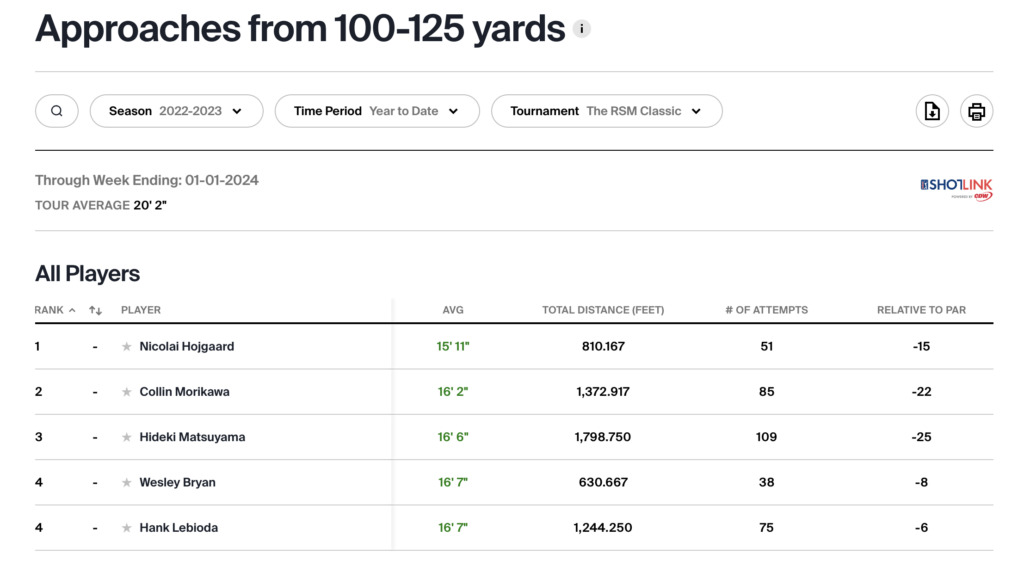
125-150 yards
From 125 to 150 yards PGA Tour players average 69.3% GIR, hitting less than 7 out of 10 greens from the fairway. Some may see this as impressive others seeing this for the first time might be surprised by these figures.
As expected, the average distance from the hole also goes up to 23ft. However, check out the right-hand column with ‘relative to par’. This shows just how impressive PGA players’ putting and short games are. They average -1 under par for every 4 attempts from the fairway between 125 and 150 yards.
For me as a coach, this highlights that many amateurs underestimate just how good pros short game and putting are. Most club golfers would be considerably over par from the same set of approach shots.
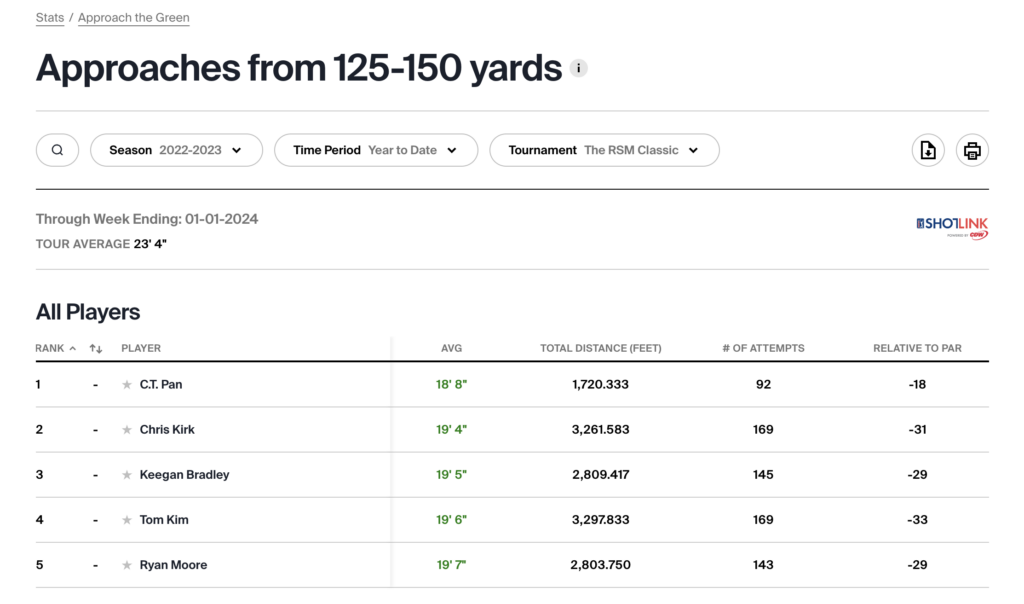
150-175 yards
As we back up to 150-175 yards we see PGA Tour players still average an impressive 64% GIR, this is partly due to their accuracy, but also because they are hitting much shorter irons from this distance compared to most club players.
The average proximity to the hole is a shade under 30ft, so next time you find the middle of the green from this distance, pat yourself on the back, you’ve pretty much hit the PGA Tour average.
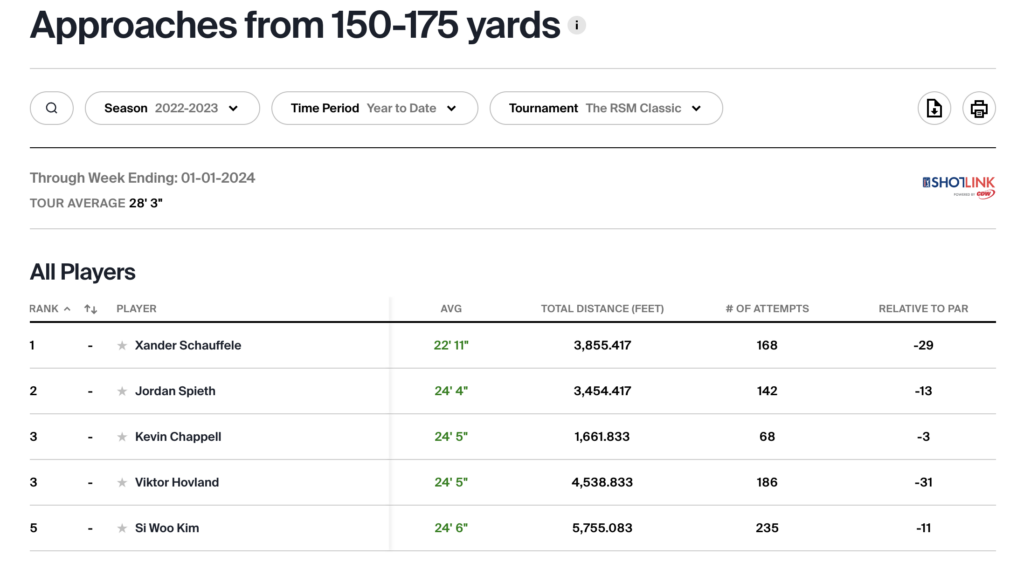
Takeaways from Tour data
If this is your first time looking into this data you might be surprised with these numbers, PGA pros can often look like golfing robots on TV. Hopefully, it gives you more compassion for the bad shots you hit and helps you celebrate the good shots you hit that find the green.
One insight I’d like to share is that after a few years of working with players of this level, you’d be amazed at how infrequently they aim directly at the flag.
The best players in the world are often aiming at the middle of the green, or between the flag and the middle of the green to ensure they are on the putting surface. If you are less skilled than a tour player I’d suggest you do the same.
Despite all the new fancy golf stats, greens in regulation is still one of the best predictors of golfing performance across all handicap levels.
Club players approach data
We don’t have the exact same metrics to compare from ShotScope, but here I wanted to share what average looks like for club players using ShotScopes tracking apps.
On the lefthand side below we have the average proximity by club across all club golfers. We don’t have the distance these shots were hit from, but it starts to give you an insight into the difference in proximity from tour average proximity from 100-175 yards (20 to 28ft) and the average proximity we see from average club golfers.
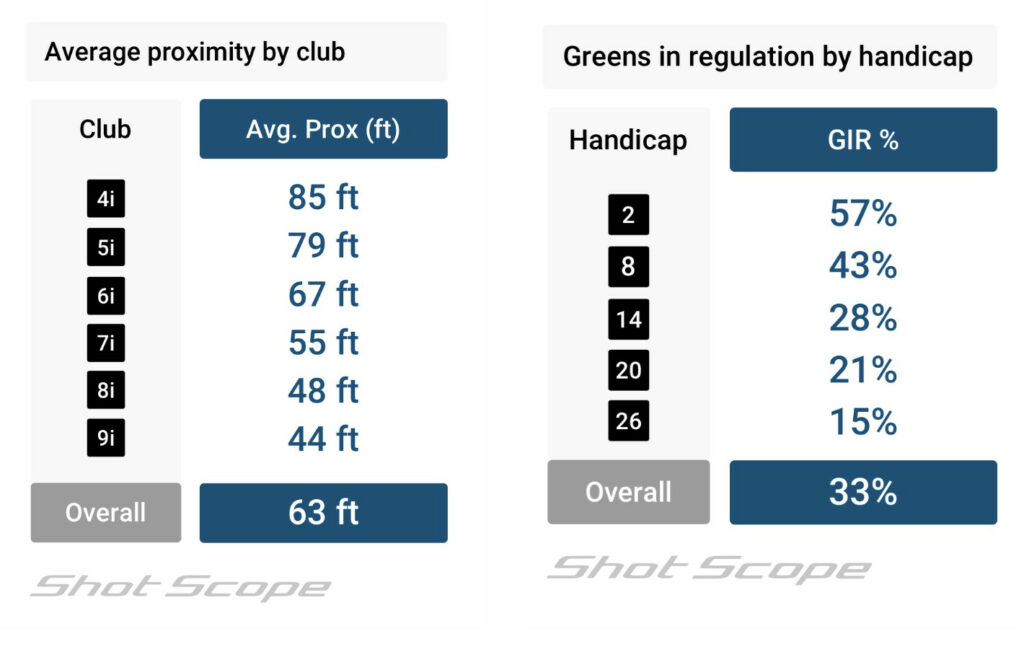
On the right-hand side, we have the average greens in regulation (GIR) by handicap. Pay attention to this graphic, it shows the jump you should look to make if you do have a handicap goal. You can also dig deeper into these trends here on our stats by handicap dashboard .
This greens in regulation data shows that if you stood on the 1st tee aiming to hit 7 to 8 greens in regulation you would be playing to a single-figure standard, 10 greens in regulation you’d be scratch standard and would not be a million miles away from Tour standard (66.3% average in 2023, Scotty Scheffler led with a crazy 74.4%).
One final stat below, here is ShotScope’s data on GIR by club for club golfers. Most club golfers will miss the greens more times than they will hit it with a 9-iron, they will miss two-thirds of greens with a 7-iron, and only hit a green 1 out of 10 attempts with a 4-iron.

Don’t beat yourself up next time you hit a poor shot with a mid or long iron, those are very tricky to hit well for all amateur golfers.
Some useful insights to finish
Hopefully, this piece has been interesting so far, I wanted to end with something you can take away to improve your own performance.
Below we have dispersion data from TrackMan for an Average Male Amateur (AMA) hitting shots from 160 yards away.
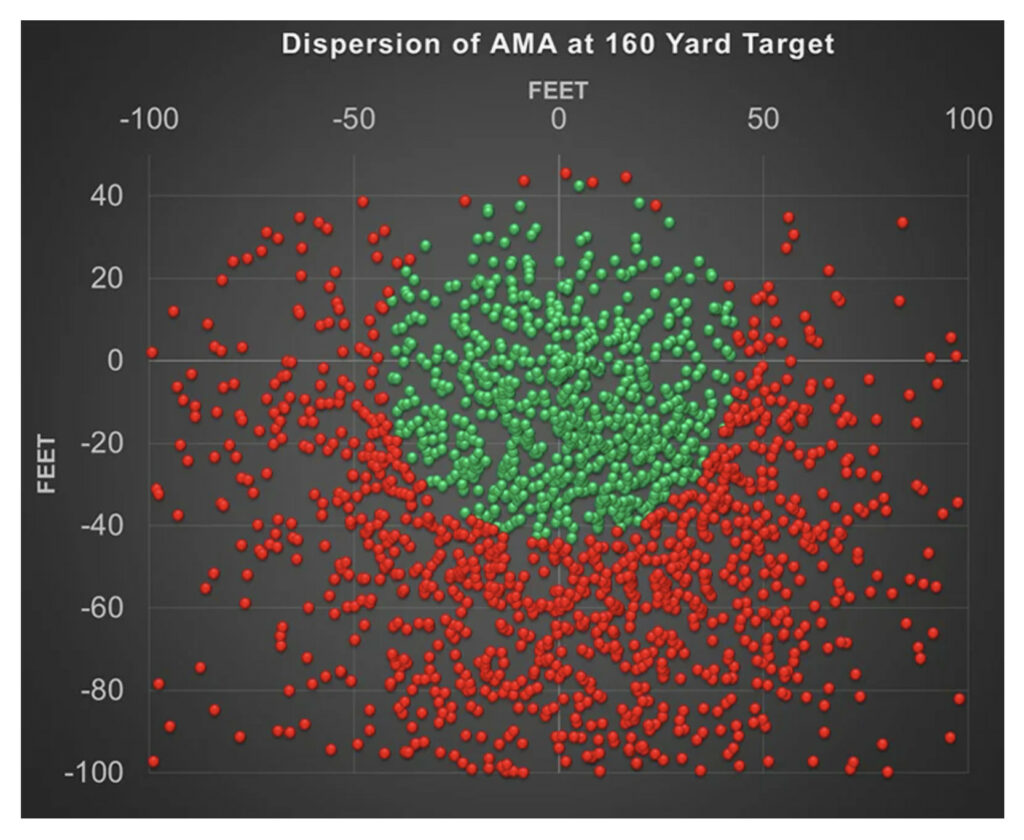
The green dots hit the green, the red dots missed. Just take note of how few shots are long of the green (6 in total) and how short most shots finish (the vast majority 40 to 100ft short).
The takeaway here is that most golfers would improve their scores considerably if they took 1-2 clubs more for every single shot they hit.
Golfers have a strong basis for remembering shots that miss long, and blame all shots that finish short of the green on poor execution. However, the data shows that golfers would be far closer to the hole and would shoot lower scores if they just shifted their entire distribution up 1 to 2 clubs.
I hope you’ve enjoyed this little trip through some data on approach play. A big thanks to PGA Tour, ShotScope & TrackMan for sharing their data.
Next time you play, reset your expectations, pick targets closer to the middle of the green and make sure you take enough club!
Happy golfing – Will @ Golf Insider
How useful was this post?
Click on a trophy to rate it!
Average rating 4.8 / 5. Vote count: 23
No votes so far! Be the first to rate this post.
As you found this article useful...
Would you mind sharing it to help me grow this site?
Sorry that this article was not useful for you.
Would you mind helping me improve this article?
Tell us how we can improve this post?
Will Shaw, PhD, MSc, PGA Pro
Will is a PGA golf professional, with a PhD in Biomedical Science and MSc in Sports Biomechanics & Psychology. He spent 10 years lecturing part-time at Leeds Beckett University and the University of Leeds in Biomechanics and Motor Control before becoming the Head of Golf for the University of Exeter. He currently runs Golf Insider UK, Sport Science Insider around wider consulting and academic roles in sport performance and motor control.
3 thoughts on “How Good Do Your Approach Shots Need To Be?”
that’s a really interesting set of stats for club golfers. As a matter of interest I play off 7.3 (8) and over the 2023 season hit on average 7.5 GIR and am averaging 8 in the few rounds I have played this year. So this is in pretty good agreement with the stats you quoted.
Hi Will, I am a 79 year old 24 handicapper and want to get back to 20 (age would be nice). I find these sort of articles very helpful in this endeavour. I tend to view each hole as one shot more for par so 5 for par 4’s etc. if I could achieve that over the round that would be 6 under. I would be interested to know what advice you would give to someone in my position. My home course I would describe as a big hitter’s course with most par 4’s out of reach for me to consider green in regulation. That means shots from about 100 yards in are common for me to hit greens in 3 (par 4). Terry
That is a good question. I’d say the simple advice would be to practice the shots you have frequently. By the sounds of things these are the shots you have from 120-80 yards. On to of that, I’m yet to meet a golfer over a 5 handicap who wouldn’t benefit from practicing their putting inside 6-feet and from 10 to 20 feet. The same can be said for simple chip shots around the green.
However, the big question is, is it possible or worth it to try to hit it further. I would suggest finding a local pro or conditioning coach to help, but for most golfers they can gain 2-10mph in club head speed just by trying to swing quicker 2-3 times a week. The Stack System is about the best thing on the market if you want to get more serious about it, and if you do, I would suggest a little GDPR launch monitor for feedback is really important.
To give you some insight 1mph in club head speed results in 2.5 yards extra distance on drives, so a 10mph gain would be ~25 yards. This is before considering the extra distance on the second shots. Not easy, but for many golfers hitting it further is beneficial if they can keep it in play.
I hope that gives you some food for thought.
Kind regards,
Leave a Comment Cancel reply
This site uses Akismet to reduce spam. Learn how your comment data is processed .
Jump to navigation
- DP World Tour
- The Masters
- Equipment News
- Equipment Reviews
- Budget Sets
- Weatherproofs
- Balls & Accessories
- GPS & Rangefinders
- Bags & Trollies
- Buying Guides
- Course News
- Course Reviews
- UK and Ireland
- Western Europe
- Eastern Europe
- Rest of the World
- USA and Canada
- Getting Started
- Bunker Play
- All Reviews
- Competitions
REVEALED: PGA Tour average CARRY DISTANCES - how do YOURS compare?!
How far do you hit each of your clubs see how you compare to the average pga tour pro..

Ever wondered how far the average PGA Tour pro carries the ball with each of the clubs in their bag? Well you're in luck as the table below gives you the latest numbers from the circuit.
Okay, not everyone hits the ball as far as the likes of Bryson DeChambeau - who incredibly once carried a drive last season 400 yards - but the below list at least gives you a broader idea as to how far the average PGA Tour pro is carrying their golf ball in 2021.
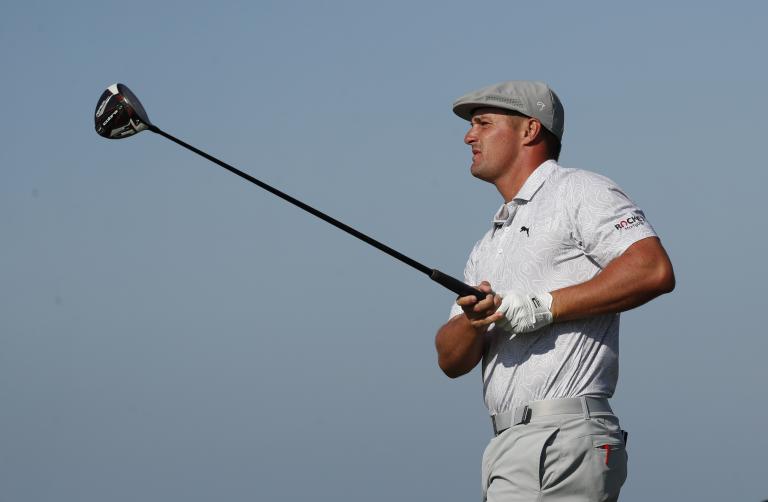
I know for one that GolfMagic Equipment Editor Alex Lodge, who plays off a low single-figure handicap, can hit the below numbers for fun - so some of you guys and girls out there may also be in the same boat.
See how your carry numbers compare to the world's best on the PGA Tour in the table below, starting with the driver and moving down to the pitching wedge.
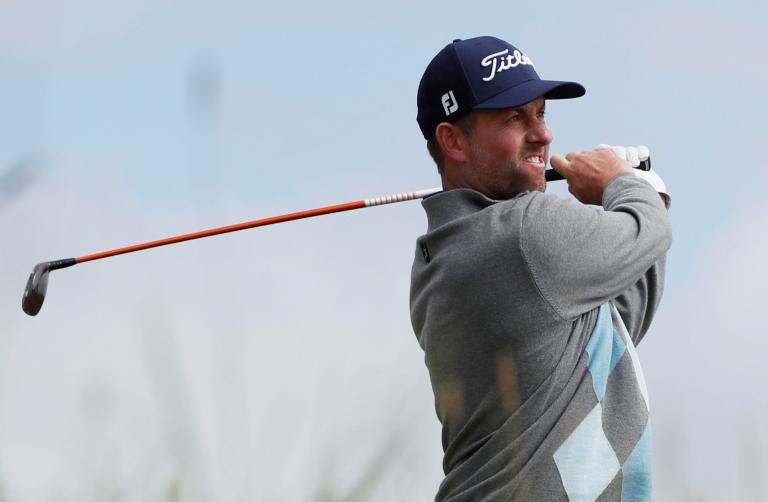
PGA TOUR AVERAGE CARRY DISTANCES 2021
DRIVER - 275 YARDS
3 WOOD - 243 YARDS
5 WOOD - 230 YARDS
HYBRID - 225 YARDS
3 IRON - 212 YARDS
4 IRON - 203 YARDS
5 IRON - 194 YARDS
6 IRON - 183 YARDS
7 IRON - 172 YARDS
8 IRON - 160 YARDS
9 IRON - 148 YARDS
PW - 136 YARDS
Stats: GOLFTV
How do your carry numbers compare to the averages on the PGA Tour? Come and share your thoughts over on our social media channels - Facebook, Instagram and Twitter - or head over to our YouTube channel.
PGA TOUR Player Stats 2022-23
- Statistics are updated nightly
- AGE : Current age of player
- EARNINGS : Official money won
- CUP : FedExCup Points
- EVNTS : Tournaments played
- RNDS : Rounds played
- CUTS : Cuts made
- TOP10 : Top 10 finishes
- WINS : Wins
- SCORE : Scoring average per round
- DDIS : Driving distance (in yards)
- DACC : Driving accuracy %
- GIR : Greens In Regulation %
- PUTTS : Putts per hole
- SAND : Save Percentage
- BIRDS : Birdies per round
- Terms of Use
- Privacy Policy
- Your US State Privacy Rights
- Children's Online Privacy Policy
- Interest-Based Ads
- About Nielsen Measurement
- Do Not Sell or Share My Personal Information
- Disney Ad Sales Site
- Work for ESPN
- Corrections
- Fairway Woods
- Golf Wedges
- Golf Technology
- Golf Gloves
- Golf Apparel
- Golf Accessories
- We Tried It
- Head-to-Head
- True Golf Fit
- Our Toolkit
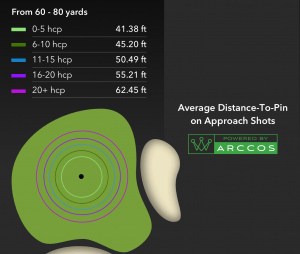
Course Management 101: What Layup Yardage is Your Sweet Spot?
- BY MyGolfSpy
- Nov 6th 2018
- Read all comments

What’s your go-to club for approach shots? That question can be bantered around your foursome and the answers would be legion. Some will know precisely what number they prefer. Others will guess a range. The majority likely wouldn’t be sure.
PGA Tour pros know this answer immediately. You can as well, but the only way to make this assessment is by using data.

Using the massive Arccos database that incorporates more than 100 million shots from nearly two million rounds , we split golfers into handicap brackets and analyzed each group’s proximity to the hole on approach shots from two yardage buckets: 60-80 yards and 100-120 yards. We wanted to find the yardage most people should try to navigate toward when laying up on a par-5 or punching out on a par-4.
With Arccos, golfers can automatically track stats on the course and use that information gathered to shoot lower scores. Arccos records on-course performance data via sensors installed in the grips of clubs . The system automatically records and analyzes all of a golfer’s stats, uses Artificial Intelligence to show a personalized strategy for every shot and leverages advanced analytics to inform practice regimens.
The results are clear : Every handicap bracket hits it closer from 60-80 yards versus 100-120 yards. (You’re probably saying duh, but stay with us!) The data also reveals a potential performance gap in a habitually forgotten practice area: the half-wedge.
The 0-5 handicap has a proximity to the hole of 41.38 feet from 60-80 yards out. Comparatively, the 20+ handicap has a proximity of 62.43 feet from that same range. That 21 feet difference will consistently contribute to more three-putts on a player’s card, giving the illusion that putting is the problem. Data reveals the truth – the higher handicappers need to start working some wedge distance control into their practice routines.
From 100-120 yards, the 0-5 handicap bracket performs relatively close to their 60-80 yard averages. There’s only about a 7-foot difference in proximity to the hole from the farther distance. However, moving back in yardage dramatically changes the proximity to the hole for the higher handicap players. The 20+ handicapper averages 83 feet from the hole on wedge shots from 100-120 yards. That’s about 21 feet farther than their distance from 60-80 yards!
As a point of reference, PGA Tour players average 19’ 7” from the hole on shots from 100-125 yards.
The data suggests that golfers should lay up as close as possible, and the logical extension of that is that they should also dedicate a big portion of practice time to wedge play.
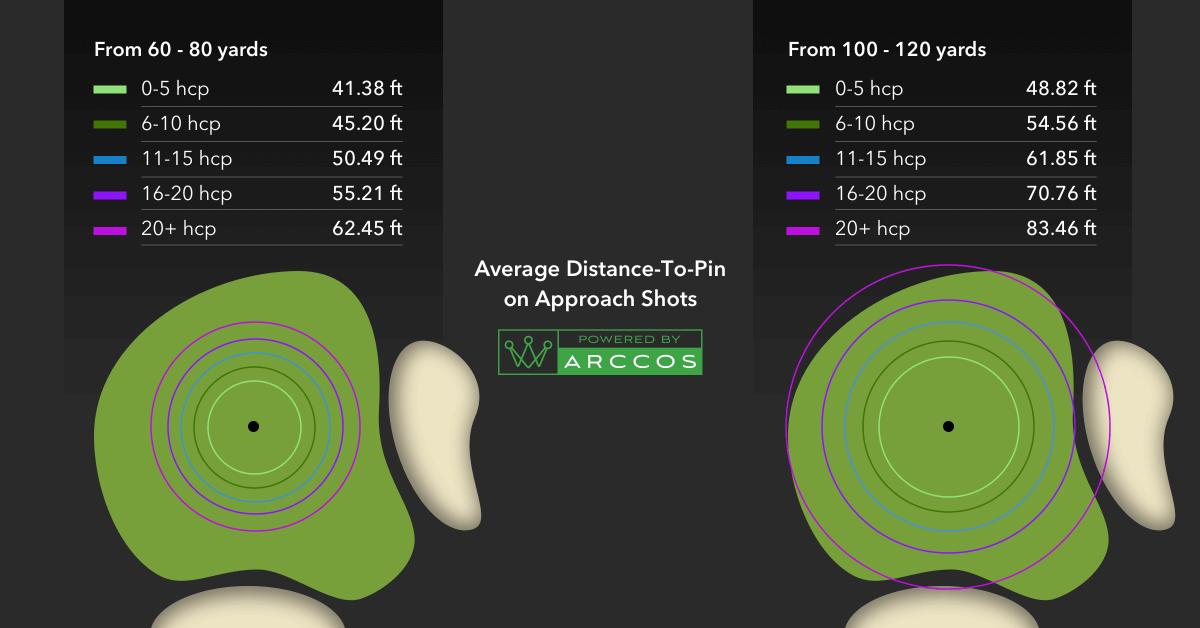
Average Distance to the Pin on Approach from 60-80 yards
- 0-5 handicap: 41.38 feet
- 6-10 handicap: 45.20 feet
- 11-15 handicap: 50.49 feet
- 16-20 handicap: 55.21 yards
- 20+ handicap: 62.43 feet
Average Distance to the Pin on Approach from 100-120 yards
- 0-5 handicap: 48.82 feet
- 6-10 handicap: 54.56 feet
- 11-15 handicap: 61.85 feet
- 16-20 handicap: 70.76 feet
- 20+ handicap: 83.46 feet
Every golfer is unique, but Arccos can help every player know the best strategy for their game. While on the course, tapping the “Caddie” button in the Arccos Caddie app reveals your optimal strategy on any shot from any point on the course. For a deeper dive, Arccos users can look at club performance for every wedge to learn which club has the best proximity to the hole. Then look at that club’s Smart Distance and voila, that’s your target layup zone.
Tour pros make carefully calculated decisions for every shot on the course. Some of the most informative PGA Tour coverage involves a player and his caddie hashing out what club to hit off the tee, how to construct a recovery shot or whether or not to go for the green. Often that process involves working backward from the green. With Arccos, amateurs can do the same.

Mar 19, 2024
Recovery strategies for golfers.

Ludvig Aberg Hopes to Replicate Rookie Success in First Full Season on PGA Tour

Mar 18, 2024
Ball lab: pxg xtreme.
- about the author
- latest posts

Our mission is #ConsumerFirst. We are here to help educate and empower golfers. We want you to get the most out of your money, time and performance. That means providing you with equipment reviews you can trust, as well as honest reporting on the latest issues affecting the game today. #PowerToThePlayer
Email Address
5 years ago
41 ft, seems far for a 0-5 handicap . At anything under 100 yards I can get inside 30 feet easily everytime. I’m a 6 handicap . If you go out and practice twice a week hitting 100 balls each time with your 54 wedge you should be able to get inside 20ft pretty regularly. Practice is the key. Puttting and wedges are way overlooked on the range. My buddies go out and hit 10 7 irons and 90 driver. Wedges and putting are the key.
Find a wedge that you can hit 95% of the time to the same spot. Practice to get it up to about 97-98% and that is your new layup distance.
Exactly. I want a full swing @ 100 yds if I can’t layup inside 20. Those are the 2 shots I am most comfortable and consistent with, probably because there’s never been a 25-80 yd practice green available for me.
I didn’t need data analytics to tell me something I already knew. I always have tried to get as close to the green on layup shots. There is no reason that amateur hacks should be “laying up to a number.” When in fact I can guarantee that they rarely practice that shot from “their” number. It’s a farce really in most cases. How many times have you seen guys beating balls on the range vs some guy actually hitting over 100 shots from 80 yards? I can say practically none. “What are you doing?” …. “I’m practicing my favorite lay up distance shot. This is where I like to be on 3rd shots into par 5’s.”
Most golfers have distance dismorfia, they hit the ball further than they actually do – it stands to reason that golfers are always closer to the pin than they actually are!! Arccos only states what happens. To question the data it means you have you do not like reality.
Does no one ever duff a shot. What happens when there are strong winds combined with biting cold and a tight lie? I know we still hit the perfect shot!!
Dustin Johnston became a world standard player when his shots from within a 100 yards improved. How did he do that practice and practice. …..
Most of us hackers don’t practice but that don’t make it right. We should and if we did then our handicaps would or should fall. To stick our heads in the sand and ignore what is happening is why our handicaps don’t get better.
Arccos will or should highlight the areas of weakness where we need to practice. Most of us need a reality check!!
Wow! I suddenly don’t feel as bad about my wedge play after seeing those “average” distances
Interesting that everyone just wants to argue against data while all they have is anecdotal or personal experience. Arccos has each player’s handicaps, and actual shot tracking that is better than what most players can do manually. Seriously if you were manually doing all this tracking on course it would be pretty slow and cumbersome. People seem to think scratch players are as good as pro’s with their approach shots. If you just watch on youtube, even the touring pro’s are way better than teaching pros. And the teaching pro’s basically can play to scratch with little practice. And you think scratch guys can land shots consistently close to the flag like a touring pro can? Don’t get me wrong, scratch players are awesome but there’s a reason why they are not even mini tour guys.
Jack, Mark Brodie’s Golfmetric app (developer of Strokes Gained methodology) claims from 100-150 yards the average proximity to the pin for a scratch golfer is 29 feet. It’s widely recognized data, Jack, nothing personal or anecdotal about it. Tracking my own game, as a 7 index, from 100-150 I’m 38 feet from the pin. How Arcoss (and now you) got these numbers so wrong is puzzling. Interesting you chose to argue for Arccos. More interesting is that Arcoss and MGS are silent on all these concerns regarding accuracy. Is Broadie off base? Is there a difference with interpretation?
So if Arcoss is standing by these numbers, and MGS is going to pump the product, shouldn’t we the consumers speak up? How is Arcoss going to help my game when they seemingly can’t do basic arithmetic?
And nobody here is claiming scratch golfers are as good as pros, Jack–where did you pull that from?
Correct me if i am wrong but the goal of the analysis was to show if a golfer should avoid certain yardages or aim for others. If these peaks and drops in performance existed, an average across all golfers like the one in the article would not show them since they are likely to be marginal and SPECIFIC TO EACH golfer. Thus maybe a better analysis would be to check across the shots of each golfer of a time if these weak yardages exist for this particular golfer; if they exist try to guess what causes them (maybe awkward half wedge yargade, mabe shot swung too hard with lobwedge instead of clubbing up…). If the percentage of golfers that experiences these weak yardages is significant then encourage each golfer to try and find his own strong yardages instead of giving broad advice that was likely since the beginning to show that the closer the more precise golfers are :).
I agree that the numbers for low hcp players seem high. I have been tracking this for years from stats on the PGA Tour web site. The median % error for fairway shots from 100-125 and 125-150 yards has been remarkably consistent in the 5.6-5.9% range. (my mechanics – take the miss distance from the middle of the pack for a given distance range, convert to yards and divide by average of the shot distance range. Be sure that you use a full year data; the current default is 2019.) The 2018 errors are 19′ 9″ and 24′ 3″ respectively giving for both an error of 5.8%. The % get worse slowly above 150 yards and quickly below 100. The takeaway from this is that if you hit a shot around 6% error, it is pro quality.
Instead of debating this article’s distances. A relevant approach would be your distances on full, half or quarter wedges to the green. This will determine the club selection for a lay up or miss hit.
This advice assumes a lot of practice. For somebody who doesn’t practice much, but has a very consistent swing, full hots are much easier to gauge than half shots. They are likely to be closer to the hole and easier to hit straight at the pin without significant errors. It is too easy to hit a half shot the wring distance especially if you play a lot of different courses. It is also easier to open or close the face in error on a half shot than on a full shot.
Erik J. Barzeski
You’d think that, but it ends up not being true in reality. Golfers hit shots from 50 yards, for example, closer than they do from 90 yards, even if 90 yards is their full swing and 50 is a yardage they almost never practice.
There are exceptions, no doubt, but generally speaking, you hit it closer from closer yardages. Exceptions are rare.
Well, it’s also obvious that people should be practicing wedge shots from not full shots. At least have a half and 3/4 swing with your wedges and know those distances.
Johnny Penso
A 0-5 handicap misses by 16 yards, on average, from 100 yards. Not buying it. The corollary to that means they average 2.3 putts from 50 feet. It also means that for every shot within 5 feet there is a miss of 90 feet…from 100 yards? That makes no sense to me.
Nice article, using data from Arccos, but the averages presented I view as horse hockey, especially the 2 lowest handicap brackets from both distances 60, 100yds (13 & 16yds) away. Have played golf for many years as a low handicaper, in a number of local handicap events, leagues & whatever, have hit/witnessed much better wedge/9I play, even from the higher handicap players from those distances.Of course from time to time, a shot will be missed, but playing full, half & open face wedges, you should be very consistent the majority of time, even hitting some stiff. Go out and play the game & hit various shots, types of shots, different distances, get a feel for your clubs; standing at the range pounding balls is not going to do it. If you have played the game for a while and you can’t do better than those reported figures & I’m sure they can provide their reasoning, perhaps it’s time to take up bowling, etc.
I disagree with “…and the logical extension of that is that they should also dedicate a big portion of practice time to wedge play.”
No, they shouldn’t, because what Lowest Score Wins calls the “O-Value” or the number of opportunities per round to hit this shot is pretty small, and the C-Value (ceiling) isn’t all that high. In other words, suppose a player can go from a 35′ average to a 25′ average. That 10′ difference is going to account for less than a tenth of a shot saved, and the golfer is only going to have that shot a few times per round. Thus, the time spent practicing that wedge shot is going to save less than half a shot per round.
Practice the higher “Separation Value®” skills more often.
Agree. The course I play is tight with trouble on both sides so practicing accuracy with driver, hybrid, long irons will decrease my overall score significantly more than hitting it 10′ closer with my SW or LW. Not to mention practicing my putting from within 6ft where a lot of my par saves come from.
Patricknorm
Excellent article. I play about 15 tournaments a season and my best scores are when I putt well and my approach shots are within reasonable birdie range. Of course playing on about 10 different courses each season brings in so many variables. I play to a 6.8 and my rounds are framed by the number of three putts and doubles. On long par 4’s I live and die by my ability to pitch the ball within range to realistically make a par. All my wedges are custom fit so I’m confident from anywhere from 100 yards in. My goal is to make par. I would say that my short game is better than my handicap but my tee to green is higher than my handicap. I’m a ham and egged.
I play to a 12 handicap. My GOAL from 100 yards and in is that my miss is no more than 10% of the total distance. The “half wedge” discussion doesn’t seem to apply for me since I carry wedges that allow me full swings from 60, 80 and 100 yards. If my misses from 60 yards were near 50 feet (28%) the wedges would be wrapped around a tree somewhere. I practice wedge play often. At least half the balls at the range are wedges.
Steve, I suggest you stop wasting so much of your time hitting wedges. You should be spending a good chunk of your wedge time on driving and approach shots.
For me it’s simple, get as close as I possibly can without putting trouble into play. 30yds is virtually always better than 40yds which is always better than 50, and so on. “Laying up to my favorite full wedge” is stupid if I can cut that distance in half and not risk a penalty. Then again, I probably hit as many partial wedge shots on the range as I do all full shots combined.
Wow, I am a 10 handicapper and usually track down my proximity to the pin with approach shots from 100 yards in and I am sure it is not 40 feet. Not saying this is wrong data but I am just surprised. Maybe because I usually play greens that are relatively small?
I’d guess someone took the proximity +/- of the hole and added them together. If you cut all those averages in half they seem appropriate. In reality, the difference between scratch and pro golfers from 100-125 yards is only 3 or 4 feet, not 22 yards.
…not 22 FEET.
Thomas Brokl
When I am 180+ out, I try to lay up to 80-85 yards. This is a perfect PW for me. If I am off on my distance, I am comfortable with a 9-iron from 90-95 or a Gap Wedge from 65-75.
You wouldn’t rather try to hit the green from 180 and then have a short chip if you miss?
He’s hitting a PW 80 yards. That means he can’t reach a green from 180 and taking it a step further, he probably can’t hit a ball that far to begin with unless it’s on a tee with a driver. Rather than hit a shot at his absolutely limit of around 150-160 yards with a lower probability of success, he’s using two reliable shots to keep the odds in his favour.
No way these numbers are accurate. On many course a 48 ft. distance to the pin would be missing the green entirely. With a SW from 100 yards. For a 0-5 hdcp. No way I’m buying that. I don’t play with one single digit handicap player that averages 48 ft. with a wedge in their hand.
It’s an average. No mulligans on bad shots.
Matt Sheehan
Missing a target by 16 yards on a 100 yard shot ON AVERAGE is bonkers to me. If I’m 16 yards away after a partial wedge I’m going to be upset and since it’s an average that means 0-5’s are often missing by more (maybe 20+ yards but that seems borderline impossible to comprehend with a wedge for such good players). I simply can’t wrap my head around scoring well if you can’t hit a green with a wedge.
I agree Jess — the data sounds wonky to me. I don’t know any 5 handicap guys that don’t regularly hit the green from 100 yards out. For that average to hold water, they’d have to miss badly as often as they hit the green.
Love this article. The numbers aren’t carved in stone as course conditons such as height of rough, dampness of grass, and/or wind factors may cause variances, but let’s just say the theory is more than sound. One reason alone is the mastering of The Half Wedge. I know that—“generally speaking”– from 65-75 yards out, my old timer’s swing likes a half a Gap Wedge, and from 80-90 yards a held off Pitching Wedge will do the trick. I had to learn this the hard way through experience, as we did not have this technology back in the day. I usually hit these within 30 feet of the pin. From 45-55 Yards is a “soft” Half-Sandy, while 35-45 is a Half a Lob. These will usually get me within 20 feet of the pin. Again—these are shots that take practice and have variances, but the basic overall theory is sound. I even have some shots measured off in feet vs. yards, for when I’m playing courses with smaller greens.
Hate to state the obvious all the time but few hit it closer from further than vice versa. Hmmm almost poetic. But aside from anecdotal stats most good golfers realize they “first” need to look at the pin location and “where” is the ideal putting target location. That is, if you lay up leaving a pitch over a trap to a pin 10’ from the fringe with the green sloping away that’s not ideal. On Sunday deChambeau got in trouble off a tee and had no shot left so hit his approach to the left of the green leaving an easier up and down than hitting to the front of the green. The issue is akin to 9-ball in pool where a skilled player will leave himself well positioned short shots that are less complicated than double bankers that leave an even harder next shot. Golfers who play lots of new courses often lament after playing a hole for the first time “I won’t play this hole from that side of the fairway next time” because they didn’t realize almost every hole is designed to be easier if you know the ideal place to hit from. So your article is interesting but perhaps the follow up one should be how to think your way around a golf course.
I was in a bit of disbelief at first like many. But these are averages. And single digit handicap’s flat out lag putt better. Hence the single digit.
That said how many times are you watching the pro’s on TV and are stunned at how often they miss by 25’+ on an 80 yard shot? “I can do better than that” you say!
After digesting it for a bit I have to concur. Mid handicaps miss far too many opportunities in the 60-80 yard range. Then there’s the errant shots going for it when they should have laid up. I see it all the time in my games.
Ten more yards off the tee gets the most noise but this is where scoring happens. My personal bests have always come when I’m avoiding penalties off the tee and my mid/full wedges are dialed in.
Go to any range and you see the higher handicaps banging away their bucket with the big dog. Look for the better swings and most of their time is spent with scoring irons and wedges.
If mid/higher handicaps played most holes for an up and down they’d eliminate a lot of their double bogey+ holes. That includes long par par 3’s. Toss a 9 iron out there then grab a wedge and pin seek. Avoid the dreaded 5-6 on a par 3. The 100+ scores are suddenly sniffing breaking 90.
Really good post here, with some very solid points.
This par 3 advice would only hold true if penalties were severe around the green meaning water and/or deep, deep rough and/or treacherous terrain. According to the data, that mid handicapper hitting from 60-80 yards after that 9 iron is still going to be 50-55 feet away which, for most, will translate to an average 3 putt for a 5 and that’s only if that 55 foot miss doesn’t put them into a trap or leave a tough chip from some rough or a poor lie.
I have never been a great ball striker so I have worked hard on my short game. I would rather have a partial 60° than a full shot any day.
Playing to your strengths is always a good idea.
Dave Johnson
While it is true that the 100 yd shot to the pin must be your perfect distance. You must have a high shot, a low shot, control of the backspin, and number of bounces. Dione by finger pressure 1 hop 2 hops etc etc
I’ve been trying to get guys in my 4some to figure out what club they want for their next shot, but most just want to get it as close as possible….on some holes that just brings a lot of trouble into play… I try to get to 90 with my new setup, it used to be 100 B4 I changed clubs.
Thanks for the write up.
Mbwa Kali Sana
ARRCOS :completely useless gimmick .Every seasoned golfer knows he”ll get closer to the pin if he hits a PW, a GW or a SW
Wow. I’m a single digit handicap. If I’m 40 feet from the pin after a 60 – 80 yard approach shot, I’m pissed. I’d really expect to be no more than 20 feet from 100 yards which is my preferred lay up distance. Folks need to put down their Big Dogs and hit more wedges on the range.
Wow so you expect to be better than the average Tour pro from 100 yards? Big expectations! I carry a plus handicap, but because I have realistic expectations I know hitting it inside 20 feet all that often from 100 yards is not going to happen. Unrealistic expectations with the short game have fueled the myth of the short game’s importance for decades. Stop giving bad advice, practicing short wedges instead of full swings will be detrimental to your golf game in the long run. Long game is more important than short game, get informed, don’t be sheep.
No Dan, Ping doesn’t expect to be better than tour average. His expectation is very much in line with his handicap. On a 60- 80 yd approach, (that’s the frame of reference in his post, maybe you should look again) where do you think he should expect to end up, on average? I think +/- 9.5% variance is FAR from “big expectations”, and is NOT better than tour average.
albatrossx3
40 ft average for 0=5 HDCP? That seems high, since that indicates that good players are up to 80 ft off line, distance as often as they are inside of 10 ft, dont buy it. But I have golfpad GPS and it does much of what Arccos does, and the flaw in the data is, are the players accurately marking the hole location. I dont do it, I dont even take my phone on the green to mark my location, takes too much time. So if this is not being done, too many shots would have a large error. But the premise stands, the closer you get, the easier it is to keep the shot online, then your error becomes distance, and that you can practice.
This is a great point. I use game golf for my own data and I’m fastidious about getting the pin position right but I don’t believe everyone else is quite so committed.
Graham Riley
Is it legal to play Arccos in an event or a club or tour tournament because it basically acts like a very well informed caddy…….. ??? Even so would love to have my clubs ‘connected’ even if it was practice rounds, i can’t think of a better way of learning your distances – even better than shotscope etc because this would be giving you that data while you are on the course and playing a round…… makes sense.
Nice, your actualy proving mark broadies, every shot counts, strokes gained methodologie with a whole net dataset. Thanks, Frans
I enjoy these articles. What the analysis is lacking in these 1 sided approaches is the approach shot strokes gained using a 3 wood from the deck to get to 40 yards away vs a hybrid to get to 90 yards away, what is the difference in that? I would bet the hybrid is far more reliable and would probably compensate for the difference in efficiency from 40 to 90 yards away. The 2nd aspect that is missing is also the 20 to 40 and 40 to 60 yards and 80 to 100 yards away, how much closer makes a difference, and is it worth it.
I find the 40 yard shot difficult, but don’t mind the 75 yard shot. Why on earth would I lay up to potentially end up 40 yards away because this analysis says hit it as far as possible. This is where a 3 wood approach shot has a wider range of distance where the hybrid is fairly reliable. I have read the Broadie book and there are great nuggets, but I still believe there are some flaws in the analytics.
I never do this, but I’m going to disagree with the conclusion on this one. I know, stay with me though…
The issue is, given the data, that all amateur golfers need to work on their 100 yard wedges/approach shots more – or whatever that full PW/GW/AW shot is that is in their bag. It’s easy to sit back and say, work on that half wedge, but that’s not going to be a reality for the average player. Any time you have a touch shot, you’re going to have outside vairables that screw things up. I discovered this last year when I went to a 50° wedge for all my approach shots inside 120 yards. Sure a full swing went X, a half swing went Y and I mapped out all those distances, but getting from 52 to 87 wasn’t an exact science. What did help, was determining where I wanted to hit in from, then leaving myself the needed yardage, plus or minus 5.
What this did was give me a full, comfortable swing with a club that was dialed in. It was also about the time I started to understand what a useless stat GIRs were. For that exact reason you stated above, hitting a green and having 60 feet in isn’t going to help my game at all, where as missing one by 2 yards that leaves me 20 feet to the flag will. A 25 foot chip is much easier to get up and down than a 60 foot putt is.
Ok, so to wrap up… My own conclusion on this exact subject was this: Find a wedge that you can hit 95% of the time to the same spot. Practice to get it up to about 97-98% and that is your new layup distance. Asking a weekend warrior to dial in their short game just isn’t feasible for most, but getting one full shot mastered sure can be.
The point was it is easier the closer you get, but yes you should still attempt to get to a good yardage. For example if a comfortable SW is 85 yards, dont lay up to 100 because that is what everyone says, also it depends upon your course, if you can reach the par 5’s laying up to 60 makes no sense, but if you cant reach them laying up to 40 is probably just as foolish unless you practice the Pelz system and know your partial swings. But in the end side to side dispersion is less the closer you get no matter what.
^This. Exactly. There are sooooooo many things that can go wrong and change the distance on a “touch” wedge. I found my distance (+/- about 4 yards) for 2 simple variations for my PW – normal & low punch. Working backwards from the green, decide which shot I need to hit, then lay-up to that distance. It’s also easy to make day-to-day adjustments for weather and how my back feels by simply hitting about 8-10 balls on the range.
My 3-putts have gone down nearly 70% and my recovery pars have increased by about 50%.
Sure, if you have the time to dial in a touch wedge distance, great! If not, try this approach.
As a high handicapper I fully agree with this approach.
Often, people are simply wrong about their accuracy or abilities from yardages. They almost all average closer from 40 yards than they do from 80, but if they hit it to 15′ from 40 yards they’re pissed, when that is really a lot better than they hit it from 80.
Heck, in one-club scrambles, we find that people hit it closer with (for example) a 5-iron from 120 than they do from their normal 200 yard yardage, despite _never_ having practiced that shot.
Bought a Cobra driver with the Arccos sensor but my phone would not pair. Called Arccos. Apparently phones must have a gyroscope & one other feature to work with Arccos. My phone had one of the two. Maybe my next phone will work. I’d love to have Arccos sensor’s on each club.
You need an accelerometer and gyroscope together with an android system 6 or higher. No idea about Apple.
If only we could all hit the ball consistently. Then golf would be easy and we would all get bored.
Accelerometer! That’s what’s missing! Thanks!
Leave A Reply
Notify me of followup comments via e-mail
Sign me up for the newsletter
This site uses Akismet to reduce spam. Learn how your comment data is processed .
TrackMan Average Tour Stats
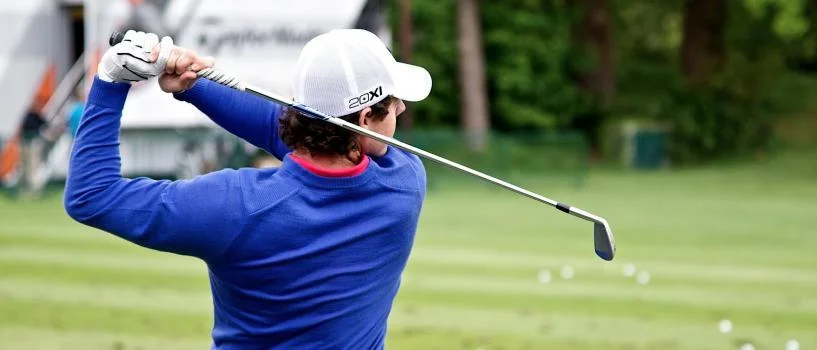
Tour stats include:
Club Speed, Attack Angle, Ball Speed, Smash Factor, Launch Angle, Spin Rate, Max Height, Land Angle and Carry.
TrackMan Average Stats Taken From The PGA TOUR
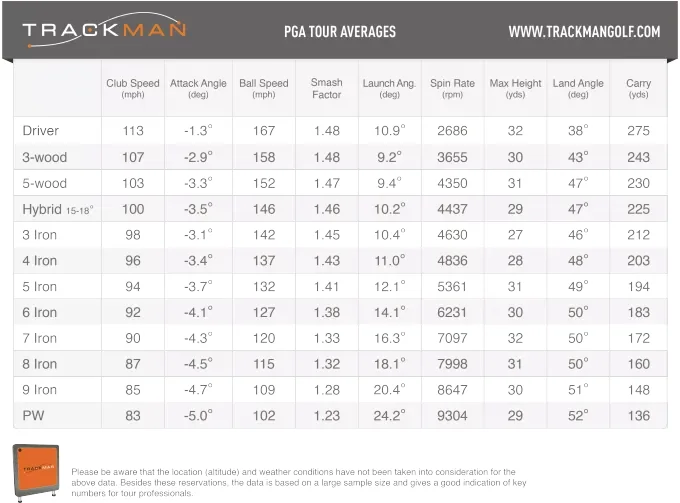
TrackMan LPGA Tour Average Stats
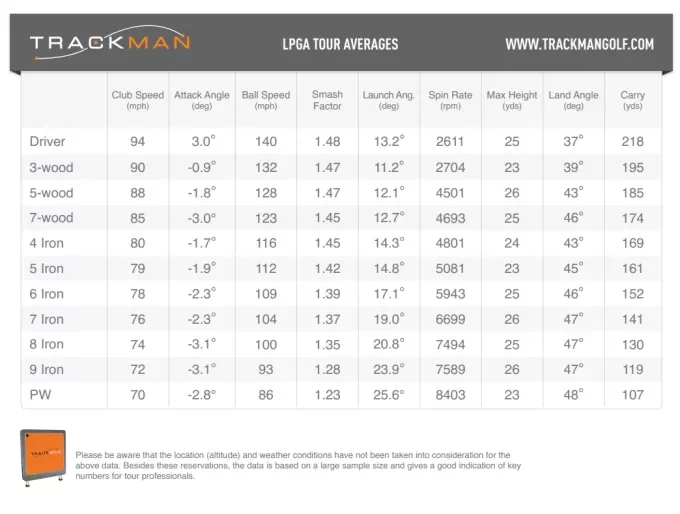
80 comments
So the average male Tour pro hits down on the ball slightly with the driver? Should attack angle vary with clubhead speed?
The attack angle for the pros varies on woods, but it’s more or less negative when it comes to hybrids and irons. For the average player, the attack angle on drivers varies and in general so should the ball that is hit from the ground always have a negative attack angle in order to get a better margin of error for the impact.
However, in order to get the longest carry possible, the ball should launch high with low spin. The optimal numbers are individual based on club speed – and that type of flight can easier be achieved if the spin loft is low together with a high dynamic loft. The more the attack angle is negative, then the higher the spin loft gets => the attack angle should be closer to 0 if anything IF the goal is to carry as long as possible.
But generally, the attack angle for irons should be from -2 – -5 for almost all players, but for drivers you can hit it further with a positive attack angle, no matter the club speed.
Niklas Bergdahl Support Manager EMEA & Asia
Can you send me the optimal numbers across the board that players and coaches should be looking for in lessons and trackman sessions
Strangely enough, with a driver you can achieve a carry of 300 vs 275 with the same clubhead speed of 113. Adam Young tries to get people to convert to this method. Attack angle = +8 degrees Launch angle = 19 degrees Backspin = 2,000 Smash Factor= 1.5
Hi. I can only confirm. I achieve those positive angles and l can carry the driver (9 degr loft) 245 yards with a club speed of 95mph. Rollout is average 20 yards.
No, it is 3° and that means the clubhead is movin upwards. – is downwards.
You are reading the LPGA (ladies) numbers Tim. The PGA (men) average is -1.3.
Looks like the average LPGA players trackman swing speed is more or less the same as an average 10 hcp male player. Though the ladies are a lot more skilled in hitting it on the right angles and in the right spot on the clubface. Would an average 10 hcp male player have a advantage or disadvantege using graphite shafts?
Harry, any player of any handicap can benefit from graphite shafts. More often than not, the memory in most players’ minds from graphite stems from a very long time ago when graphite was ONLY graphite. It was whippy, and not very accurate. Material advances and composite technology have nearly rendered steel obsolete. I say nearly, mind you. There are a number of outstanding graphite shafts out there that are super stable and responsive, enabling a lighter club and longer distance without sacrificing accuracy. Fujikura makes some really nice iron shafts that fuse both steel and graphite technologies called MCI. In fact, i have Fuji PRO 95i shafts in my irons and my iron game is better now than it ever was with steel. I’m a 3.5 index and relatively strong but it allows me to play all out without getting tired on the back 9 from heavy clubs. Being a club builder, i can tell you that in golf equipment there’s a trade-off in everything. wether it’s length, weight, or feel so your advantage or disadvantage is dependent on how precisely you build your piece of equipment.
Hey Chris thanks for the info below i find it very interesting. Curious do you have those same shafts in your wedges or do you have steel in your wedges? I played SteelFiber i95 shafts last year in all my irons including wedges. I liked them in my irons but i felt like it hurt my game in wedges. Do you have any thoughts on this? Thanks
Agreed. Shallow your angle of attack to match the LPGA players.
I have had a number of sessions on a Trackman, (the latest on Aug 22, 2015, at “Modern Golf” in Mississauga On.). My clubhead speed and distances are about the same as LPGA averages. I was doing wedge work, and see that for a pitching wedge, (48°), my angle of attack -about 7.5° – is n=much higher than LPGA average. My accuracy is good, (only 3 0f 19 shots more that 20′ away, and all when the face angle was over 4° closed). I’m thinking that I should weaken my left hand a bit, (it’s a little strong on pitch shots), and play the ball farther forward- 2″ ahead of centre. Am I on the right track, or will these changes introduce new problems?
I’m 74 years old, and am a long-time PGA of Canada member. Thanks for any feedback…. love Trackman outings.
I would recommend that you visit one of our certified coaches, he/she would be able to help you and find what numbers are best for you.
See our TrackMan Locator here.
I don’t disagree with these stats but I do it;s kinda weird. 87 miles mph with an 8 iron should produce 177 yards of carry not 160 that’s a lot of mph. Iv’e seen high school kids hit 9 iron 165 and they don’t swing 100 mph with a 9 iron. When I swing hard I hit my 8 iron 155 and my legit radar read 72 mph so logic would dictate at 88 mph you would get more like 180 yards carry again that’s a lot of mph.
Remember that’s a carry number not total distance. Also since the pros produce significant more back spin, their ball flight is higher, landing angle loftier producing minimum roll whereas your total distance might be benefiting from maximum roll. One more thing to check would be launch angle where you might be hitting a low ball flight to maximize distance which in my opinion is “cheating.”
The PGA Tour 8-iron goes 160 in the air for a couple of reasons. One, they usually hit weaker lofts than high school players (like I) do. Secondly, they spin their 8-iron at 7998 RPM to stop the ball on fast greens. I believe this is the combination that makes the 8-iron go so much shorter.
I’ve hit thousands of balls on Foresight simulators, and what I’ve found is that backspin significantly influences carry distance. Holding club head speed constant, greater backspin reduces carry distance on all clubs.
For mid-irons, I’d estimate that you lose roughly 5-7 yards of carry per 1,000 RPM in additional backspin. And with the driver it’s easily 10+ yards of carry lost per 1,000 RPM.
This explains why poorly struck balls will often fly as far, if not further, than a well-hit shot. The key to backspin is crispness of contact – a poorly struck shot simply won’t spin as much. Unless the impact is absolutely terrible, the lack of backspin on poorly struck shots will cause those balls to carry further than a well-struck ball. So if you’re flying balls over the green with your irons, the culprit could be too little backspin caused by poor contact, cheap balls, a dirty club face, etc.
I think this is also the key reason why fades don’t carry as far as draws. It’s not that a draw swing is any faster/more powerful – it’s simply that fades have more backspin due to the impact geometry/physics involved with that swing.
Now I may be wrong on some of this, so I’d love to get a true expert’s take.
One thing I forgot to add to my comment above is that you need a minimum of backspin on all golf shots just to get the ball up in the air. That may be 1,500 RPM for woods and maybe 3,000 for irons.
My point is that increasing backspin beyond this base level will generally reduce carry. For example, I can guarantee that increasing the backspin on your 7 iron from 5k to 7.5k will reduce your carry with that club, even if your swinging faster at 7.5k.
I totally disagree with your premise. Draws carrying further than fades? That makes no sense.
Bare in mind tour players play with proper golf clubs which are weak lofted so the people you see hitting a 9 iron further than tour average 8 it’s probably because that 9 iron is closer to a 7 iron loft
Spin determines weather you hit a draw or fade so logic would dictate distance will also be effected. In my experience draws do tend to be further for 2 reasons and both have to do with spin. With a draw you will usually get more roll out as well as flight because of the decrease in spin. This is especially true with a driver.
Depends what clubs you are using. There can be as much as 7 degrees of variation between a ‘standard’ loft on a 7 iron. If you’re playing the Callaway Mavrik irons, you’ll get 27 degrees of loft on a 7 iron. If you’re playing the Callaway Apex Pro then its 34 degrees. That’s a two club difference.
I was custom fit recently for the Apex 21’s and currently play Apex MBs. With the MBs my 7 iron has 34 degrees of loft and flies 165yds with 89mph average club head speed. Same swing with the Apex 21s (30 degrees of loft) flies between 177 – 180 yds. Big difference.
Larry , I would highly recommend you see Mark Evershed . Buy him lunch and get the answers your looking for .
Hi guys this was a recent session with a cobra 3 wood 16 deg loft.my question is my launch angle seems a little low ,interested in your thoughts .thanks Shot # Club Club Speed (mph) Ball Speed (mph) Smash Factor Launch Angle (degrees) Direction Back Spin (rpm) Carry Distance (yards) Total Distance (yards) 1 3 Wood 94 143 1.52 8.80 Straight 3874.00 215.00 232.00 2 3 Wood 98 148 1.51 9.10 Straight 4096.00 223.00 240.00 3 3 Wood 94 142 1.51 9.10 Straight 3904.00 213.00 230.00 4 3 Wood 94 143 1.52 8.80 Straight 3874.00 215.00 232.00 5 3 Wood 96 145 1.51 9.10 Straight 4000.00 219.00 236.00 6 3 Wood 94 143 1.52 8.80 Straight 3874.00 215.00 232.00 7 3 Wood 94 143 1.52 8.80 Straight 3874.00 215.00 232.00 8 3 Wood 93 141 1.52 8.80 Straight 3826.00 212.00 229.00 9 3 Wood 92 129 1.40 12.40 Straight 4138.00 190.00 207.00 10 3 Wood 94 142 1.51 9.10 Straight 3904.00 213.00 230.00 11 3 Wood 94 142 1.51 9.10 Straight 3904.00 213.00 230.00 12 3 Wood 94 143 1.52 8.80 Straight 3874.00 215.00 232.00 13 3 Wood 96 145 1.51 9.10 Straight 4000.00 219.00 236.00 14 3 Wood 93 140 1.51 9.10 Straight 3856.00 210.00 227.00 15 3 Wood 96 146 1.52 8.80 Straight 3970.00 220.00 237.00 16 3 Wood 92 140 1.52 8.80 Straight 3778.00 210.00 227.00 17 3 Wood 95 144 1.52 8.80 Straight 3922.00 216.00 233.00 18 3 Wood 96 145 1.51 9.10 Straight 4000.00 219.00 236.00 19 3 Wood 94 142 1.51 9.10 Straight 3904.00 213.00 230.00 20 3 Wood 91 137 1.51 9.10 Straight 3760.00 204.00 221.00 21 3 Wood 94 143 1.52 8.80 Straight 3874.00 215.00 232.00 22 3 Wood 95 144 1.52 8.80 Straight 3922.00 216.00 233.00 23 3 Wood 95 144 1.52 8.80 Straight 3922.00 216.00 233.00 24 3 Wood 96 146 1.52 8.80 Straight 3970.00 220.00 237.00 25 3 Wood 96 146 1.52 8.80 Straight 3970.00 220.00 237.00 26 3 Wood 96 145 1.51 9.10 Straight 4000.00 219.00 236.00 27 3 Wood 94 137 1.46 10.60 Straight 4054.00 204.00 221.00 28 3 Wood 94 143 1.52 8.80 Straight 3874.00 215.00 232.00 29 3 Wood 98 142 1.45 10.90 Straight 4276.00 213.00 230.00
What kind of balls were you using?
Brent. This was at a driving range with srixon range balls
Ok the one number that really stood out to me was the smash factor. Usually anything above a 1.50 indicates something is illegal. There’s a reason not even the PGA tour players aren’t averaging 1.50 off the tee. Other than that your numbers look good.
Brent what about the launch angle
Yes the launch is a little on the low side. But seeing how you’re still getting decent distance I wouldn’t worry too much about how it’s coming out. But try hitting down on the ball more to get it up in the air faster.
I frequently get above 1.5 on trackman with longer irons and my woods (I have raised this with your tech teams already). This is because your machine measures club speed just before impact and doesn’t detect acceleration through impact
Trackman doesn’t detect acceleration through impact on solidly struck shots so you can post smash factors above 1.5. It’s best to just rely on ball speed with Trackman
Brent in one of your comments you said my smash factor was high ,had a session last night at range and some of my smash factors were 1.53 is this something to try and change and if so how do I change it
Like you had said you were using range balls correct? If so the smash factor will be a little off since they aren’t a legal tournament ball. What the smash factor (as explained to me by the Carolinas PGA rules committee chairman) is, is a measurement of how well the ball comes off the face. There’s a specific calculation for it but I’m not positive of it and anything over a 1.50 usually is a tell tale sign that either the club or ball is illegal. What I would recommend doing is using the ball you would normally play a round with and get some readings off that ball.
I read not long ago that Rory Mcilroy had a smash factor of 1.53 as well . If Willie can hit it 380 the way Rory does, I wouldn’t change a thing.
Larry. I’m 55 years old 280 is my distance not 380 Like Rory
Ball speed divided by club head speed is smash factor
I’m currently doing my university project on green-side bunker shots, I was wondering if you have any shot data for a short bunker shot or flop shot? Thanks.
Sorry but we do not have any official data we can share, but it would be interesting to see your final research :)
Blair, My assumption would be that the cleaner a ball is picked out of a bunker the more spin it will have and vice versa. The more sand you use to move the ball the less spin.
Do you have TrackMan data for AoA and DL for greenside bunker shots?
Sorry we do not have any official bunker shot data.
In looking at the tour pro stats for men – the max height reading for all clubs is about 30 plus or minus 2. I am trying to understand how/why are the heights the same for all clubs? My assumption would be the more lofted the club the greater the height! Is 30ish the optimum figure for best distance? Because in my last stats my longest 9.5 degree driver shot was max height of 56!
Is there any data available from the Senior tour?
We do not have any official charts for the Senior Tour. But you can login on mytrackman.com and use the combine section and filter, to show only Senior Tour players.
Thanks Christian!
what month/year is this data from?
Is there any data on typical club path for a tour pro?
Can you please post stats for average path, club face, and face to path numbers for PGA tour?
Could you please post average path, club face, and face to path numbers for several top Tour Players?
Before all the hype about hitting up on the ball came about, I hit down on a driver anywhere from -2 to -4 degrees and swung 1-2 degrees left.
Once I started to try and swing up on it. I lost direction big time. An easy swing for me is 112, swinging hard at it I can get it up to 123. Does Trackman recommend those that have higher swing speeds to hit down on it for straighter direction?
There is no physics logic backing up that hitting up on the ball will give a decrease in accuracy. However to go from hitting down to hitting up you have made some changes to your impact obviously. The way you made the changes could well be the problem as this could have affected your impact location, swing path, clubface and the way you release the club
Can pga tour players carry the ball 293 yards.
A Question: Were some data change on this site? I ask because I’m quite sure to have read other data for the men’s driver trajectory. Am I wrong or can someone confirm this?
kindly zorro
Is my impression right, that the data for the men driver were changed from
[Daten alt: 112mph 165mph 11,2° 2685 31y 39° 269y] to [Daten neu: 113mph 167mph 10,9° 2686 32y 38° 275y] ?
Why did TM do that?
For the tour pro stats – mainly carry distance, launch angle and spin rate for the driver, you have the averages, could you supply the max and min (filtered for outliers)? I am going to run an experiment with Trackman at my golf academy and need a starting range for each item. The tour max and min range is a starting point versus having to create this from scratch.
Anyone know where I can find raw data of clubhead speed? It is for a College project. Thanks!
You know what would be great to see – average miss from target – left and right – for each club. Of course short and long from target matter as well, but solid contact isn’t really my issue – left and right misses is my challenge
I’m about a half club off of PGA Tour average distance wise. Technically I’m a 1 handicap, but more like 4 or 5 when the tourney pressure is on. I know from playing with better players the difference between me and them is pretty much how much more accurate they are from a left and right perspective.
You can find all this info from Mark Broadie. He has tracked all the shots on the us tour for years and also written a book Every Shot Counts about it
I have been playing Golf for less than 19 months. I must admit I was damn tired of the same Golf Lesson producing varying results with inconsistent instruction(s) which seemed contradictory to the previous lesson. I take Golf perhaps a little more serious than others and my “approach” to this game may be viewed as extreme due to my focus on Fitness/Strength Training combined with my Yoga and Nutritional regimen.
That notwithstanding I would like to formally THANK the Trackman Developers and Support Staff for FINALLY producing a “Standardized” curriculum eliminating the traditional random quick fixes and circumventing the often inconsistent and contradictory methods being taught today.
I currently own a Trackman 4 and although I DO NOT wish to teach, I am Certified as an Operator and successful in obtaining my Professional Level 1 & 2 Certifications and shortly will be submitting my Thesis to be considered for review. These Certifications have greatly assisted me in understanding Flight/Ball dynamics and greatly assists my Coach and I in our 4-5 hour daily Putting-Wedge-Iron-Wood and Driver Sessions providing the data necessary to produce a more consistent and …. I have a hard time with this next word…… F U N game. (There I said the word “fun” in the same sentence as “Golf.” I’m so proud of myself!!!
Seriously, I simply CANNOT thank Nathan Meyer for coming to my hometown and demonstrating the enormous benefit(s) of purchasing the Trackman 4 product.
Kym Fontana [email protected]
It has been an absolute pleasure getting to know you! Your work ethic, attitude, and kindness are all things that I can look up to. very excited for 2017 and I am looking forward to seeing you again soon!
-Nathan Meyer [email protected]
Are there numbers posted for an average 5 HCP player or 10 HCP player similar to the charts above for the ave tour player?
What is the #1 PGA Tour player in “Carry Distance” average carry distance??
I understand this data is pretty old, released soon after the time when trackman first came out. I’m sure things have changed since then. Any update?
Actually, we haven’t seen any huge changes over the past years, it’s more about roundings. For example, Avg. Club Speed for a driver: 2014: 113.0 mph 2015: 113.3 mph 2016: 112.9 mph And it’s pretty much similar with the other numbers.
We do have a graphical updated version of the Tour Stats here.
Not really. Lee Westwood was interviewed recently and advised that apart from his driver he hits everything else almost the exact same he has his entire career.
I’m looking for PGA tour averages for dynamic loft for different clubs. Does anyone have this data to share? Thanks!
Are there tour averages for club path?
Are all these stats full swings? Example: Would the avg tour pro hit a 6-iron further, if he turns fully and tries to hit it as far as possible (with a natural movement like on a driver – not with an unnatural swing that creates most possible power, but result in very unconsistent ball flight)?
Currently I practice indoors because of the winter. I do my practice with Trackman and I carry my 7 iron about 177-180 yards and total distance of 188-192 yards with my TaylorMade PSi irons. Lots of my shots with the 7 iron has a smash factor of 1.50-1.51.
This is a example of one of my shots with 7 iron.
Club speed: 80.2 | AoA: 1.3 | Ball speed: 120.5 | Carry: 164 meter | Total: 176 meter | Dyn Loft: 19.6 | Smash Factor: 1.50
Is that normal number for a 7 iron with a that club speed?
Averages are useful, but knowing them would be more useful if we knew the median and mode, as well as the range.
Hello, Are there updated PGA Tour Trackman stats?
On Trackman this week using 7i I noticed the spin rate I had was well below that of a pro by nearly 3,000 rpm but similar club speed and attack angle. How can I get my spin rate up?
It can vary a lot due to the ball and clubs you are using. For example driving range balls are normally very hard and will have much lower spinrates than a quality ball like a Titleist pro v1. Modern day irons are also built to higher the lauch angle and lower the spinrate so that the average golfer will achieve more distance
It would be great to know the average loft for each club, especially the irons!. I think 21-24-27-30-34-38-42-46 (3-Pw) are reasonable specs. What do you guys think?
What loft are the irons? A modern 7i is now 30°
Is this still the original data from 2015 or has it been updated?
I’d be very curious to see if the how the average attack angle has changed over this time in the PGA.
Please update this data from over the years of more testing.
Do you have any numbers on tour averages numbers on dynamic loft and spin loft?
I am a 2 handicapper and I hit my driver 280 yards on an average. What is the attack angle with driver of the best players on the pga tour?
these yardages are no doubt well below reality.
6 iron only 183yds carry? Most high handicappers hit it equally far.
Leave a Reply Cancel reply
- Coach Of The Month
Subscribe and get the latest Insights!
Recent comments.
- Keith Rogers on Paul McGinley – How To Practice
- Anthony on 6 TrackMan numbers all amateur golfers should know
- BillM on TRACKMAN HANDICAP
- Tim Work on How To Work On Attack Angle
- WAYNE B EISMAN on 6 TrackMan numbers all amateur golfers should know
Stay updated
Stay up to date and receive free notifications of new posts by email.
Email Address
Subscribe - It's Free!
- Coach of the month
How Far PGA Tour Players Carry Their Drives
What's the average carry of a PGA Tour player's drive, and how might that change in the future?
- Sign up to Golf Monthly Newsletter Newsletter

The driving distance debate is one that stubbornly refuses to go away… although that’s something governing bodies the USGA and The R&A are probably hoping will change within a few years.
That’s because they have confirmed golf ball rollback plans that will see driving distances reduced at every level of the game, starting in 2028 in the professional game and from 2030 elsewhere. But how far do PGA Tour players currently carry their drives, and how will the changes affect the numbers?
Carry distance is an important stat to know, but why? Well, it’s one thing to know how far your drives have travelled after the ball has come to a stop, but if you’re weighing up potential problems ahead from the tee box, such as water, bunkers or rough, carry distance is the priority.
According to figures released by Trackman, which also show how far PGA Tour players hit every club in the bag , players on the circuit carry their drives an average 275 yards.
That's over nine yards more than in 2007, when the PGA Tour began keeping carry distance records. Back then, the average carry distance was 265.7 yards. As with driving distances on the PGA Tour , that has increased over the years, but it won't stay on that trajectory indefinitely, because of the changes coming in 2028.
That will see the game’s longest hitters lose between 13 and 15 yards of their total driving distance. However, the average elite male player will not be as affected and can expect a reduction of between nine and 11 yards. Naturally, this will have an effect on carry distance, too.
Of course, the very longest hitters and average elite players are all part of the overall Trackman average, but it’s probably safe to assume that the average carry distance after the rollback will be around 10 yards shorter, or approximately 265 yards - in other words, somewhere close to the 2007 level.
Get the Golf Monthly Newsletter
Subscribe to the Golf Monthly newsletter to stay up to date with all the latest tour news, equipment news, reviews, head-to-heads and buyer’s guides from our team of experienced experts.
But what about the biggest hitter? After all, the further a player drives the ball, the more distance he will lose after the rollback. According to the PGA Tour website, Rory McIlroy , a key figure who supports the change , is at the top of the list for the 2022/23 season with an average driving distance of 326.3 yards.
Rory McIlroy supports the golf ball rollback plan
Let’s say that average comes down by the top figure given by the governing bodies once the change comes in – 15 yards. That will reduce his average driving distance to 311.3 yards, or a 4.5% hit.
McIlroy’s average carry distance for the same season is 307.4 yards and 4.5% of that is 13.8 yards. That means his carry distance could come down to around 293.6 yards after the rollback.
How Far PGA Tour Players Carry Their Driver
- Club speed (mph): 113
- Attack angle (deg): -1.3
- Ball speed (mph): 167
- Smash factor: 1.48
- Launch angle (deg): 10.9
- Spin rate (rpm): 2686
- Max height (yards): 32
- Land angle (deg): 38
- Carry (yards): 275
Numbers: Trackman
Mike has over 25 years of experience in journalism, including writing on a range of sports throughout that time, such as golf, football and cricket. Now a freelance staff writer for Golf Monthly, he is dedicated to covering the game's most newsworthy stories.
He has written hundreds of articles on the game, from features offering insights into how members of the public can play some of the world's most revered courses, to breaking news stories affecting everything from the PGA Tour and LIV Golf to developmental Tours and the amateur game.
Mike grew up in East Yorkshire and began his career in journalism in 1997. He then moved to London in 2003 as his career flourished, and nowadays resides in New Brunswick, Canada, where he and his wife raise their young family less than a mile from his local course.
Kevin Cook’s acclaimed 2007 biography, Tommy’s Honour, about golf’s founding father and son, remains one of his all-time favourite sports books.
The five-time winner of the Augusta National event has been named in the field for the 2024 edition, which takes place in April
By Mike Hall Published 20 March 24
The world No.5 is playing some of the most consistent golf on the PGA Tour, despite not winning since 2022
By Joel Kulasingham Published 20 March 24
- Contact Future's experts
- Terms and conditions
- Privacy policy
- Accessibility statement
- Cookies policy
- Advertise with us
Golf Monthly is part of Future plc, an international media group and leading digital publisher. Visit our corporate site . © Future Publishing Limited Quay House, The Ambury, Bath BA1 1UA. All rights reserved. England and Wales company registration number 2008885.

How Far Do Pro Golfers Hit Each Club? A 2022 Guide
Written by Graeme Hay | Last Updated: 12/03/2024
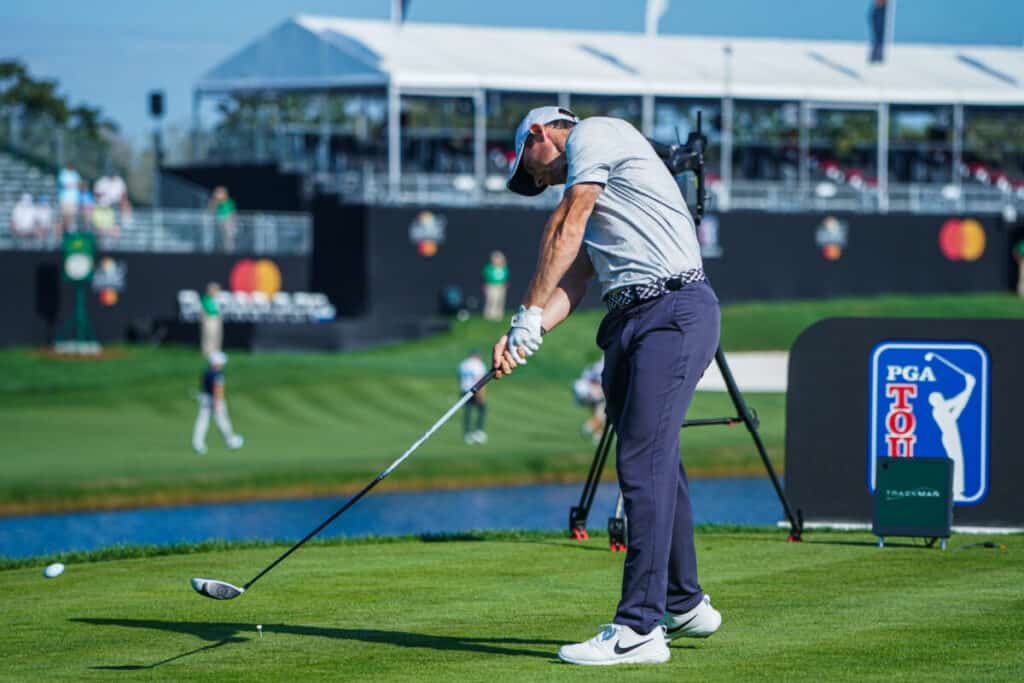
When you watch the PGA Tour or any major championship on TV it is hard not to notice how far pro golfers hit the ball.
Their drives seem to always go miles and I don’t know about you but I’m always checking myself to think whether I indeed heard the commentator correctly that they are actually hitting that high an iron for that 200+ yard approach shot.
So just to confirm what we are indeed up against we took a detailed look at just how far the top pros are hitting their clubs.
On average pros drive the ball a total of 296.6 yards (yds) according to official PGA Shotlink data. They hit a 3-wood an average carry distance of 249 yds, a 5-wood 235 yds and 3-hybrids 230 yds. 3-irons average 217 yds, 4-irons 208 yds, 5-irons 199 yds, 6-irons 188 yds, 7-irons 177 yds, 8-irons 164 yds and 9-irons 153 yds.
These high-level numbers of course don’t always tell the whole story as the pros like us are faced with an infinite variety of golf shots which don’t always mean they are hitting each club as far as they possibly can for every shot.
But if you take the averages over a season you are going to get more than a good idea of how far the pros are hitting each club.
What is fascinating also though as you dig more into the figures is the distance control options the best players in the world have with almost every club in their bag!

How Far Do Pros Hit Their Driver and Woods?
When it comes to talking about distance in golf the easiest and most obvious place to start is of course always with the longest club in the golf bag – the driver.
And as it is highly unlikely even the best pros in the world never want to hit their driver as far as they can so it is clearly the club we are going to get the best idea of the maximum distance they hit the ball.
So how far do pros drive?
PGA Tour players hit their driver a ‘total’ of 296.6 yards on average with a ‘carry’ distance of 284.3 yards according to official 2022 Shotlink data. The longest player hits it 320 yards on average and the longest recorded drive in 2022 is 460 yards. On the LPGA Tour the top pros hit their driver an average of 257.7 yards.
When it comes to how far the pros hit a 3 wood and the other longer clubs in the bag including their hybrids the distance analysis gets a bit more complicated because clearly the pros are starting to use these clubs for a wider variety type of shots than they do for their driver.
The pros, like the rest of us, will be hitting a driver as far as they can 99% of the time but when it comes to their 3-wood, 5-wood and hybrids they can be using those clubs off the tee and for approach shots and will not always be aiming for their maximum yardage with those clubs.
The best distance comparison we have for those clubs is therefore the ‘carry distance’. In other words the distance from where they hit the ball to the point of impact on the ground.
On average PGA Tour pros hit a 3-wood a ‘carry’ distance of 249 yards. By comparison a 5-wood carries 235 yards and hit a 3 hybrid, which measures from 19º to 21º, an average carry distance of 230 yards. On the LPGA Tour the top women pros carry a 3-wood 195 yards, a 5-wood 185 yards and a 7-wood 174 yards on average.
For those of you interested in how these averages compare to individual pros we have listed in the table below the average ‘stock’ carry yardages for a selection of the top pros when it comes to how far they hit their driver.
In the following table the list shows how far a selection of PGA and LPGA Tour pros hit their 3-wood, 5-wood and hybrid clubs.
[Note – If you are interested in what drivers and fairway woods the top 100 PGA Tour players are using check out the in-depth analysis we have done here .]
How Far Do Pros Hit Their Irons? Remember to Take Stock
Looking at how far pros hit their irons is a much easier task these days due to all the tracking technology that exists however it still does not make it an exact science.
And that is for the simple reason that pros will hit all manner of a variety of different shots with their irons, especially for their approach shots, and as such, they will hit the same iron a variety of different distances.
A look at Brooks Koepka’s yardage book below gives us a great insight into this and highlights how many types of shots pros can play with their irons.
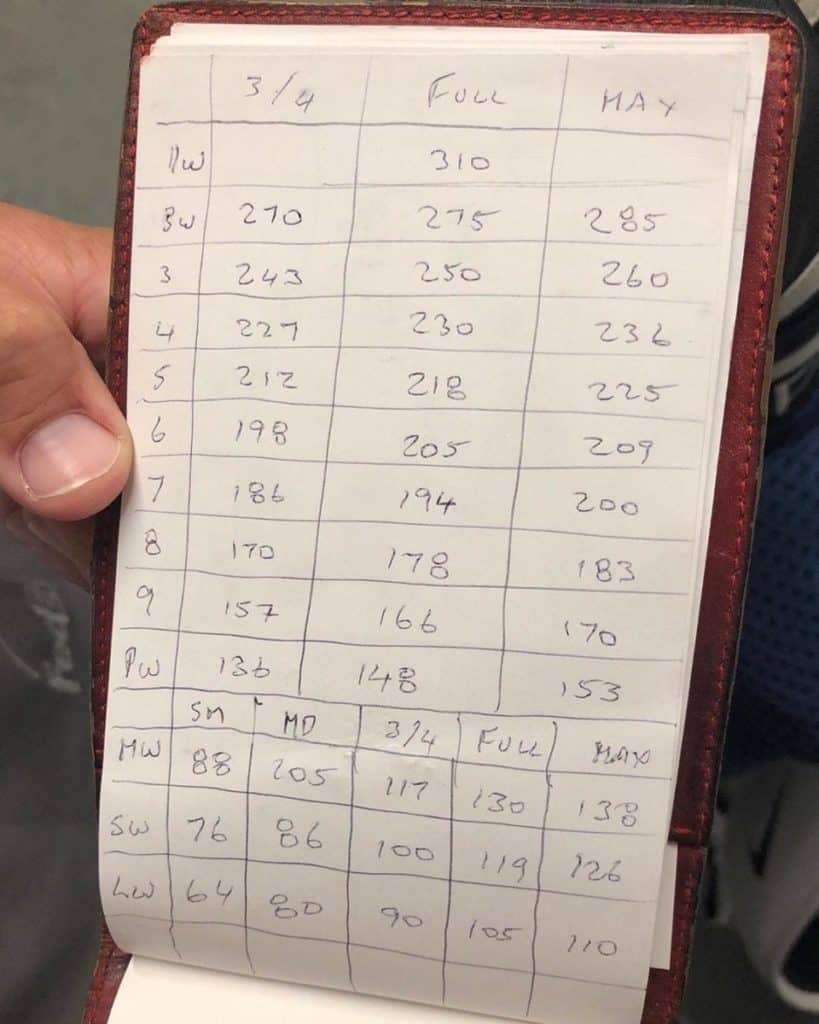
For example for a 170 yard shot into the green a quick glance at his iron yardages shows he could decide to play either a three-quarter 8-iron or try to hit a 9-iron as far as he can – his ‘max’ distance for that club.
When you account for factors such as wind, elevation, ground conditions and also the context in which the shot is being played Koepka, like all the pros, has a number of options for each iron shot which makes the question of how far he hits each iron a bit more complex than at first you may think.
However the pros have what is called a ‘stock’ yardage for their irons, which equates essentially to the average distance they will hit a full shot with each iron swinging normally.
When we compare these ‘stock yardages’ for irons between the pros we get a consistent view of yardage which we can accurately compare across the players.
On average PGA pros hit a 3-iron a ‘carry’ distance – the distance from strike to point of ground impact – of 217 yards. They hit 4-irons 208 yards and 5-irons 199 yards on average. For 6-irons the average is 188 yards, for 7-irons it is 177 yards and 8-irons, 9-irons and pitching wedges go 164, 153 and 141 yards respectively.
Different pros however clearly hit their irons different distances but in the table below we have listed the ‘stock yardages’ of some of the top pros, including Rory McIlroy, Dustin Johnson, Justin Thomas and Bryson DeChambeau, to let you see how they compare against the average.
And when it comes to how far Tiger Woods, arguably the greatest iron player of all time, hits his irons?
Tiger hits his 3-iron a ‘carry’ distance of 240 yards on average while his 4-iron goes 225 yards and 5-iron 210 yards. When it comes to his mid-irons he hits his 6-iron and 7-iron 195 and 180 yards. As for his short irons his 8-iron yardage is 165, he hits his 9-iron 150 yards and his pitching wedge 135 yards on average.
How Far Do Pros Hit Their Wedges
When it comes to looking at how far the pros hit their wedges the stock yardage they hit each club is again obviously only one of the multiple yardages they can hit the most versatile clubs in any player’s golf bag.
As we can again see from Brooks Koepka’s yardage book above he has 5 different yardages listed for each of his specialist wedges which highlights just how much distance control the best golfers in the world can exert with their wedges.
Another added complication when it comes to comparing the distances that the pros hit their wedges is the differing lofts each of them often carries for seemingly the same club.
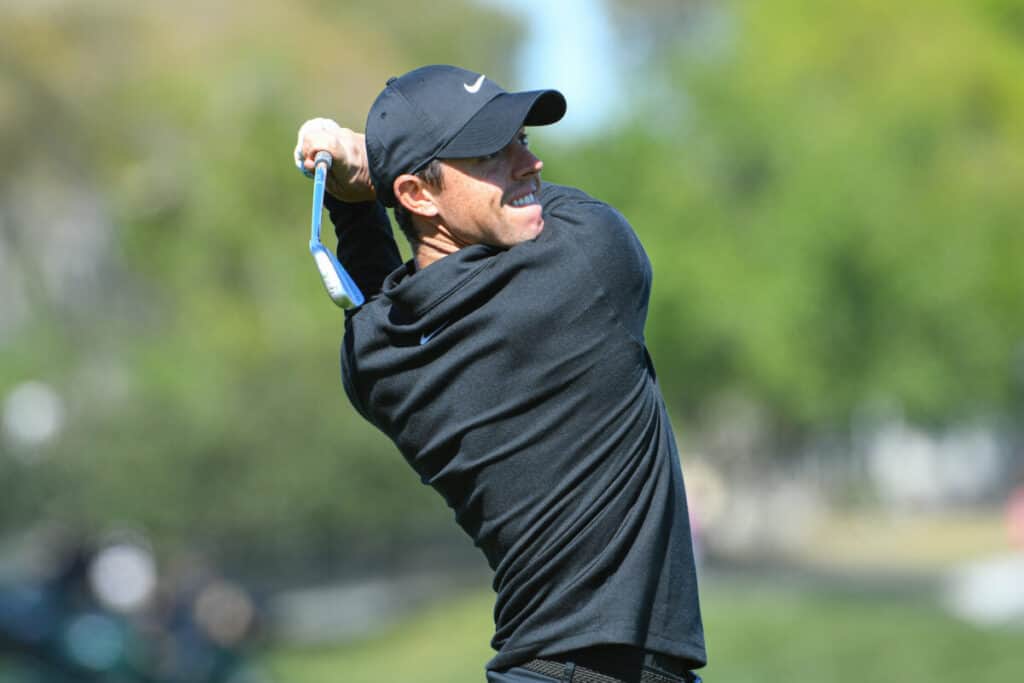
For example while one pro’s ‘gap wedge’ may be 50º another may choose 53 or even 54º for that same ‘gap wedge’ club and with such a difference in lofts it becomes very difficult to compare with any meaning how far the pros hit the same-named wedge.
Assuming however the pros are hitting ‘standard’ lofted pitching, gap, sand and lob wedges we found the following stock distances for how far the pros hit them .
As a whole PGA pros hit their pitching wedge an average carry distance of 141 yards. They hit 52º gap wedges a stock carry distance of between 126 and 135 yards and carry 56º sand wedges an average distance of 119 to 124 yards. Standard 60º lob wedges meanwhile carry 95 to 105 yards on average.
While these yardages will give you a general guide as to how far pros hit their wedges it is important to remember how particular all the pros are about these clubs especially.
It is vital for them to know exactly how far they hit their wedges with a variety of different types of shots because feel is so important from those short distances, especially at the top level of the game, where a yard or two can make the difference between winning or losing a tournament.
That is why you will find some pros’ wedges measured up to 0.5º or even 0.25º when listed and it is also likely that some of the actual strengths of the wedge lofts they use may in reality be stronger (i.e. a lower loft) or a touch weaker (i.e. a higher loft) than the actual degree loft number shown on their club.
To help however answer the question as well as we can the table below shows the varying distances some of the top pros, including Tiger Woods, Rory McIlroy and Dustin Johnson, are hitting their wedges, together with the degrees of loft their clubs are listed at.
Before you go …
While it is great to find out how far the top players are hitting the ball it is even better to know the reasons why they achieve the huge distances they get.
Is it simply down to the fact that they have access to the latest and best equipment or is it something else?
Read our next article to discover the real reasons the pros hit the ball as far as they do, and how you can potentially add 20 to 30 yards to your drives!
How Do Pros Hit the Ball So Far?
Other top articles related to this topic:
- How Far Should You Hit a Driver? FULL GUIDE By Age, Handicap etc.
- How Far Does a 3 Wood vs 5 Wood Go? Tee and Approach Shots!
- How Far Should I Hit My Hybrids? 2 vs 3 vs 4 Hybrid Distances
- Hybrids vs. Fairway Woods – FULL Distance and Comparison Guide
- How Far Should I Hit My Irons? By Handicap, Age & Swingspeed
- How Far Should You Hit Your Wedges? Be Sure to Fill the Gaps!
- Why Don’t Your Drives Go Far? Slow and Steady Loses the Race
- How Far Should Your Driver Swingspeed Go? 60 to 120 mph Guide
- Average Driver Swingspeeds? COMPLETE GUIDE by Age, Handicap etc.
- Ideal Spin Rate and Launch Angle for Driver? That’s Personal!
- How Far Should Your Ball Speed Go? 100mph All the Way to 210mph!
- The PGA Tour’s Rising Driver Ball Speeds Mean One Thing – $$
- What Should Your Driver Attack Angle Be? Try Not to Be Negative
- How Much Does Driver Loft Affect Distance? Loft is Dynamic Too!
- 10 Ways to Get More Distance off The Tee With & Without Speed!
- What Determines Driver Distance? Skill Triumphs Over All!
- Are Driving Range Distances Accurate? Golf Balls are a Problem
- Do All Golf Balls Go the Same Distance? Physics First
- What Affects Golf Ball Distance? Beware ALL the Uncontrollables!
- Do Certain Golf Balls Go Further? Brand and Cost Considerations
- Do Distance Balls Go Further? Marketing Matters
Leave a Reply Cancel reply
Your email address will not be published. Required fields are marked *
Save my name, email, and website in this browser for the next time I comment.
RECENT ARTICLES

From Tee to Green: Analyzing What Golf Balls Champions Tour Pros Use (2024)
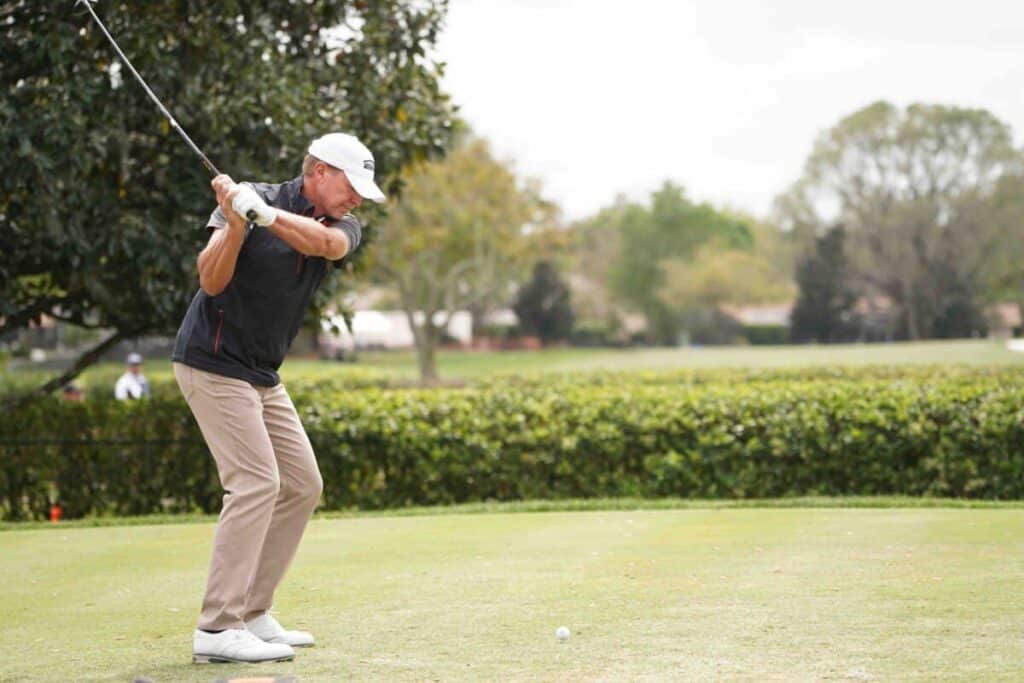
What Drives the Senior Tour Pros? Most Popular Driver on Champions Tour (2024)
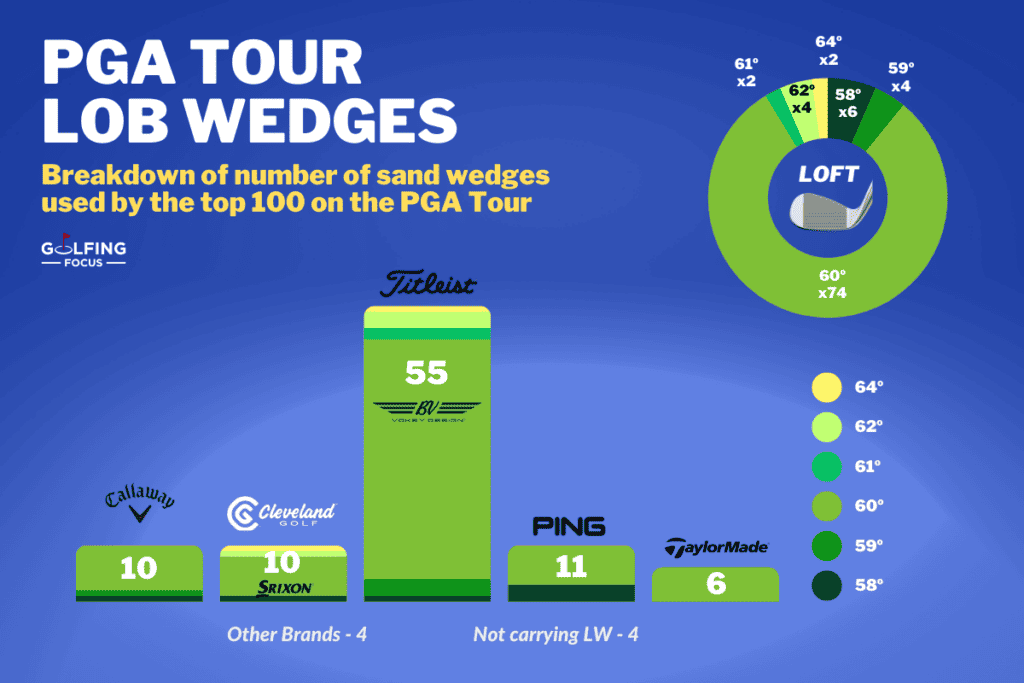
What Wedges Do the Pros Use? Top 100 PGA Tour Player Analysis (2023 update)
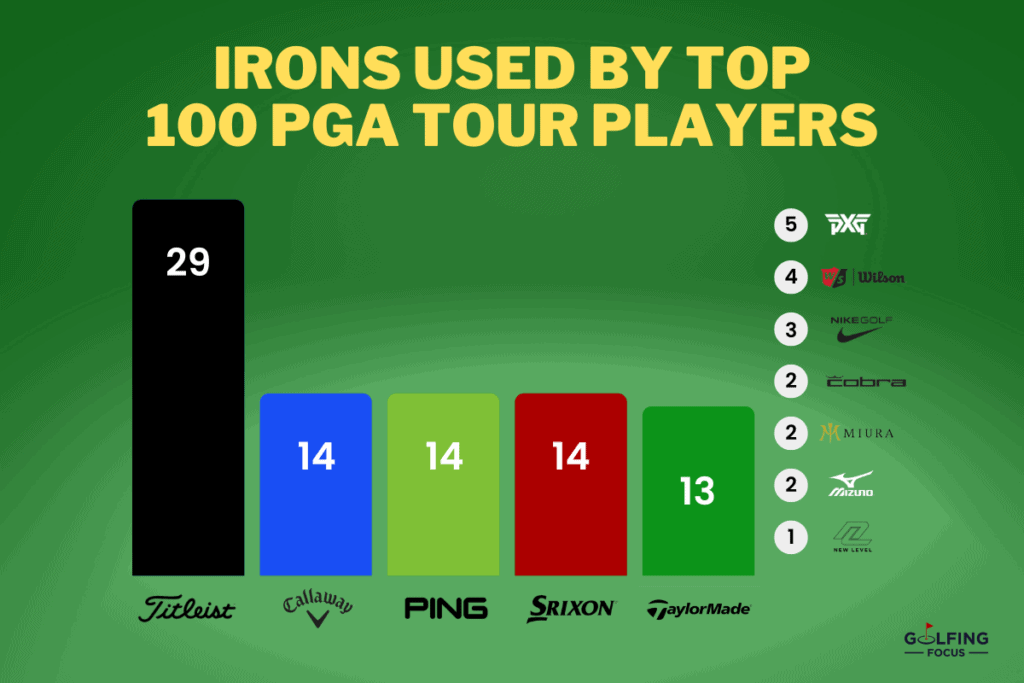
What Irons Do the Pros Use? Top 100 PGA Tour Player Guide (2023 update)
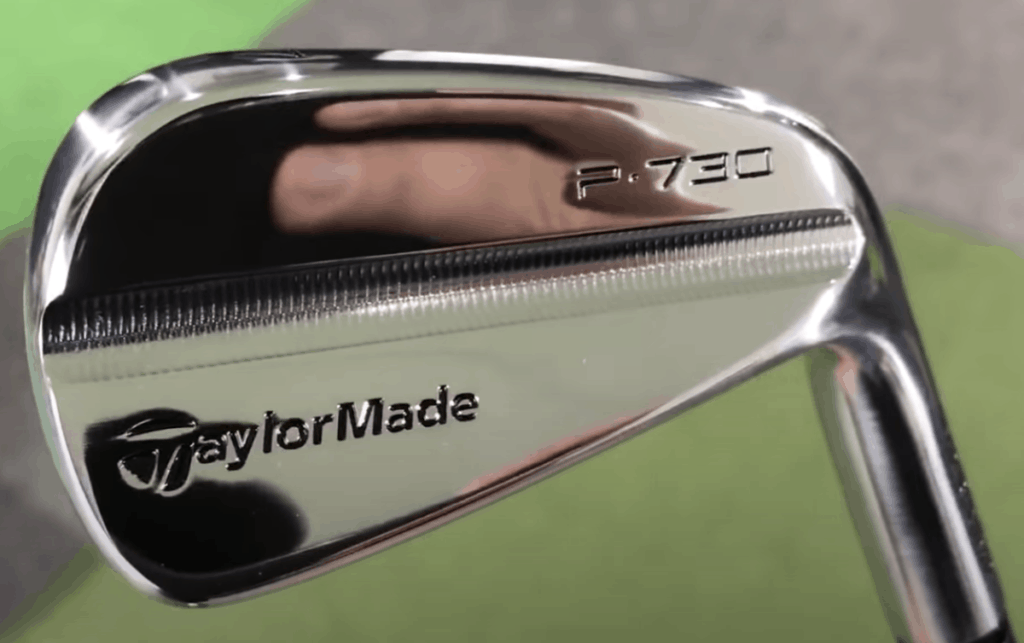
What Handicap Should Play Blades? Don’t Bother!
LEGAL INFORMATION
This site is owned and operated by Golfing Focus Limited, a private limited company whose registered office is in London, UK. Golfing Focus Limited is a participant in the Amazon Services LLC Associates Program, an affiliate advertising program designed to provide a means for sites to earn advertising fees (at no cost to you) by linking to Amazon.com. Golfing Focus Limited also participates in other affiliate programs with the eBay Partner Network, FlexOffers, CJ.com, Svorn and other sites and is compensated for referring traffic and business to these companies (again at no cost to you).
Our Socials
PGA Tour Averages: Proximity To Hole 50-200 Yards

You guys asked for it, so here you go. I wonder if there’s anything there that caught you by surprise?
PGA Tour averages – Proximity to hole:
50-75 yards: 16’ 6” 75-100 yards: 17’10” 100-125 yards: 20’ 4” 125-150 yards: 23’ 8” 150-175 yards: 28’ 9” 175-200 yards: 35’ 9”
PGA Tour: 2022-2023 Season – Through the John Deere Classic

Are You One of the 9 Out of 10 Golfers Getting It Wrong?
Are you tirelessly hitting balls at the driving range, jumping from one tip to another, hoping to find that magic fix? If this sounds familiar,

Avoid This Simple Error to Stop Three-Putting
Struggling with three-putts more often than you’d like? The solution could be as simple as the golf balls you practice with. Many golfers don’t realize

10 Looks at GIR After Your Tee Shot – Explained!
Have you ever heard the term “10 looks at GIR after your tee shot”? This concept is crucial for those trying to break 80, yet

Two PGA Tour Scrambling Stats: Crucial to Your Game!
Golf’s a game of precision and smarts, especially when scrambling to save par. Today, we’re diving into two key PGA Tour scrambling stats that can

Why Your Driver and Irons Never Seem to Agree!
Ever find yourself in this peculiar conundrum — your irons are spot on, but the moment you pick up your driver, it’s as if you’re

5-Step Pre-Round Putting Routine to Build Confidence!
Try this proven warm-up to enhance your putting confidence and prime you for success.

Three Gates to Make More 10-15 Footers!
Try these three key drills for accuracy, speed control, and sinking more 10-15 footers.

Striking a Balance – Training vs. On-Course Play
Striking the right balance between training and on-course play is crucial for improvement!
Discover more from Mike Bury Golf
Subscribe now to keep reading and get access to the full archive.
Type your email…
Continue reading

Players Championship: How hard is TPC Sawgrass for average golfers? Brutal
EDITOR'S NOTE— The average player data used in this story was through 2022.
Despite the lore and the gore of the Players Championship, the Stadium Course at TPC Sawgrass is not the toughest layout played on the PGA Tour. In the last decade, it has ranked in the top 15 just twice; it was 12th in 2022, which considering how horrible the weather was last year, its actually lower than you'd likely imagine. On the Florida swing alone, it often trails other theoretically less fearsome venues like PGA National, Bay Hill and even Innisbrook.
But those are just numbers. The Stadium Course’s true ferocity lies in a place that statistics do not always adequately measure. It is in that dry mouth or accelerated heart rate, the deep breaths that fail to find calm or the deeper sighs of soul-crushing despair. The Stadium Course is the worst kind of torture chamber: the one that exists in your mind.
RELATED: Inside TPC Sawgrass' tour-pro exclusive practice facility
What’s truly beautiful about the menacing Stadium Course is that as a public venue that sees about 50,000 rounds a year, average golfers pay (mightily, at $600 per, not including caddie) for the privilege to be embarrassed 18 separate times. Moreover, what the average tour pro feels and experiences so, too, does the average Joe.
While the Stadium Course routinely plays over par for the Players Championship (72.619 in 2022), it also brings out the worst in average golfers. That’s what the statistics say from the researchers at Arccos Golf, whose GPS sensors track every swing in a typical round. According to Arccos, the average score for players in the 5- to 15-handicap range is 89. That number is more than confirmed by those who’ve seen it in the flesh. Brandon Barfield is a 12-year veteran caddie at TPC Sawgrass and currently the assistant caddie master. He’s seen scores as high as 202 by a paying customer at the Stadium Course, and only once in over a thousand loops has a player shot even par.
“Most people who come out here, if they’re a 5- or 10-handicap, they’re going to score more like a 10- to 20-handicapper,” he said. “The course just plays 5-10 strokes harder. That might just be from their mentality coming out and knowing what they’re about to go through.
“That guy who shot 202 said he watched the Players on TV and he wanted to see exactly how hard it is. He found out exactly how this course can jump up and bite you all day long. My legs were hurting after that, but his arms had to hurt even worse.”
Of course the Arccos numbers for average golfers are predictably bad, although not as debilitating as 130-over-par. The group of 5- to 15-handicappers, somewhat better than the average golfer of course, score almost a full stroke over par or worse on 14 of the 18 holes. Arccos show the 5th, 7th, 14th and 18th holes all with an average score of around 1.2 strokes over par. Only on one driving hole do they hit the fairway more than half the time. On only one hole do they hit the green in regulation more than half the time, and we’re not entirely sure even that’s the case (more on that later). All that ineptitude doesn’t get any better the closer they get to the hole, either. The only time a chip or pitch shot from these Average Joes consistently gets inside 10 feet on a Stadium Course green is when it’s less than 10 yards from the hole, and even then it only happens about 61 percent of the time. Outside 10 yards, those pitches and chips get inside 10 feet only 30 percent of the time.
It’s not that the Stadium Course seems unfair or cartoonishly evil. Rather, it seems doable, gettable, until, of course, the golfer tries to do too much beyond his ability level. As Patrick Cantlay said in 2021, Dye fools you and challenges you at the same time.
“I feel like it will show you one side with trouble and you almost have to ignore the big flashy trouble but hug the trouble, because the worst side will be the bailout side, and once you bail out into the fat side, then the troubles start mounting,” Cantlay said. “Pete Dye kind of does that all day, and if you have enough guts to hit quality shots all the way around, you can shoot good numbers.”
Having enough guts is a universal challenge in golf and most especially at the Stadium course. Nothing typifies that emotional trauma more than its finish, a play in three acts that seems equal parts opportunity and misfortune, skill and will, execution and, well, execution (as in lethal injection). Navigating 16, 17 and 18, whether it’s to win a Players Championship or take home all the bets on the 19th hole, requires a player’s best but more often leads to his worst.
Here’s what the PGA Tour stats and Arccos’s average golfer numbers say about how the last act of the Stadium course plays out.
The tantalizingly reachable par-5 16th is the easiest hole on the course by the numbers, which of course everybody knows going in to the round, but as a player’s last best chance to post a score it exerts a pressure to succeed that is somehow greater than the fear of failure looming at the following two holes. Case in point: In the last 20 years, while it has accounted for the most birdies and eagles of any hole on the course, it’s also led to more balls in the water than any other hole, save the two to come.
For average golfers, the Arccos numbers say the 16th produces the longest drive of any hole at 233.9 yards, but the average score is just 5.85. From the typical resort guest tees, that’s still going to leave a 250-yard second shot and more often one of the trickiest layups on a par-5 this side of the 15th at Augusta National. With the water looming right, the average golfer’s bailout leaves him blocked by the overhanging oak tree just left and 50 yards short of the green. According to Arccos data, average golfers at the Stadium Course are still only hitting the green 48 percent of the time, mostly with their third shots.
PGA Tour players, who go for the green in two 73 percent of the time, hit the green 81 percent of the time and make birdie or eagle 47 percent of the time. Despite three-quarters of the shots coming from players going at the green in two, the average proximity to the hole is still about half that of the proximity of average golfers who mostly are going at the green with a wedge (53 feet for the pros vs. 102 feet for the Joes).
The villainously infamous island green par-3 17th , barely much more than a wedge shot these days, is the toughest par 3 under 150 yards in the two decades of the ShotLink era, averaging just a click over par. And yet its green-in-regulation average is the highest on the course and its average proximity to the hole barely differs from any other similar length shot on tour. Like so much of the Stadium Course, the 17th haunts not for what it actually ends up being but instead for what it might be. In many cases, that easy “3” can be a double or even a quad. In 2021, there were 66 balls in the water at the Players Championship, or about one of every seven attempts that week. In 2022, wicked winds and nasty weather meant tour pros made 30 double bogeys and 14 "others." Compare that to 17 made on holes 1 through 16 for the entire tournament. All told, 64 balls found the water on this hole in 2022.
For resort guests and other public access players, the 17th is such a carnival ride that it should come with its own “I survived” T-shirts. Barfield, the TPC Sawgrass caddie, calls it a mind game that starts long before they get to the tee box. “When they hit their third shot on 16 and start looking over at 17, that’s when they start getting nervous,” he said. “You see the swings change a lot on 17. It’s like they’re trying to control everything, their swing, their emotions, all of it.
“We’re trying to cool a player’s mind as much as we can. On the walk, we might not be staring at the hole as much. Maybe take a picture to get his head out of worrying about the hole. But you can’t really change someone’s mind on that hole too much. They’ve been thinking about it since they pulled into the parking lot.”
For all its allure, the 17th hole can become a nightmare made real. We’ve all heard the story of the legendary Golf Digest “Worst Avid Golfer” contest in 1986 , where a Pittsburgh grocer named Angelo Spagnolo made a record-setting 66 after having to resort to putting the ball along the path to the green because he couldn’t get a regular tee shot to stay on the putting surface. (When the Golf Channel had him recreate the scenario in 2011, he made a 44, including a bad ruling.) Barfield said he’s seen a 23 on the hole during his watch, but the standing rule is to limit golfers to three shots at the island green. “I would say that drop area doesn’t see very many balls,” he said. “They retee it right where they’re at and hit until they hit the green. I’d say one out of every eight guys is using a sleeve of balls on 17. And most of the time it’s one out of every four.
“I’ve done over a thousand loops out here and not once have I seen all four balls of a foursome on the green in one shot.”
It seems fair to say that so vexing is the 17th hole that it may cause most average golfers (and several pros) to lose their senses. The Arccos data backs that up, if only because it is so mysteriously positive. The average score by Arccos research at 17 is only 3.78 and the numbers say our collection of 5- to 15-handicappers hit the green 61 percent of the time, better than they do at any other hole at Sawgrass. What gives? Golf data analyst Lou Stagner, who is Arccos’s data insights lead, has a simple explanation. “A lot of those shots that hit the green most likely are mulligans,” he said. A player has to note on the Arccos app when penalty shots need to be added, and when you’re firing a sleeve into the drink at the most famous par-3 in the world, sometimes accounting goes by the wayside.
Stagner estimates that the greens in regulation at the 17th for average golfers in reality might be barely 20 percent. Indeed, he studied the random scatter of shots from a similar distance and found it encompassed an area more than twice the size of the 17th green. So he probably rightly believes an average score is most likely closer to something in the 5s than it is in the 3s. Barfield agrees.
“Some guys hit the green and it rolls off and they drop it up there on the green even though we know that’s not the rule. So they make some fake bogeys that way,” said the caddie. “Scores are not what people say they make out there. Just on that hole, though. I feel on every other hole they tell the truth.”
There is of course no sterner truth at the Stadium Course than than the heroic 18th. That might be especially true for average golfers, Barfield says, because “they think the round is over after 17 and that tee shot on 18 is the hardest on the course.” For ams and pros alike, the 18th offers one closing insult or pyrrhic triumph. For the PGA Tour, it stands neck and neck with the 14th as the hardest hole statistically on the layout. The number of bogeys or worse triples the number of birdies. In the ShotLink era, it is the toughest on the course, recording more doubles than any other hole. The best players in the world hit the green in regulation only 45 percent of the time, the least of any second shot on the course.
While the average golfer plays a tee 36 yards shorter than the pro tee, his drive according to Arccos data is more than 60 yards shorter. That means his second shot is even harder than the tour player’s: it’s longer and being executed by someone with considerably less ability. The amateur’s average proximity to the hole at 18 is almost 100 feet, about 60 feet more than the tour pro’s.
Conservatively, the amateur golfer is taking an average of close to 17 shots on the Stadium Course’s final three holes, or five over par, but even the PGA Tour player isn’t getting through that closing gauntlet unscathed. The average score last year was 12.1, or one over. It surprises no one that since 2003, almost 2,300 balls during the Players Championship have ended up in the water on those three holes alone, or that the course retrieves 140,000 balls annually from the pond at the 17th green.
“We try to make the last three holes the most demanding and 16, 17, 18 have done a pretty good job,” Dye once said, just the wryest of cackles in his voice. “If you finally get a golf hole that works on their minds a little bit then you’ve hit the jackpot.”
Dye hit that jackpot three times in a row with 16, 17 and 18. Said Barfield, “I think we’d get as many people signing up just to play 16, 17 and 18 as we do for full rounds. We’d probably have just as many balls end up in the water, too.”
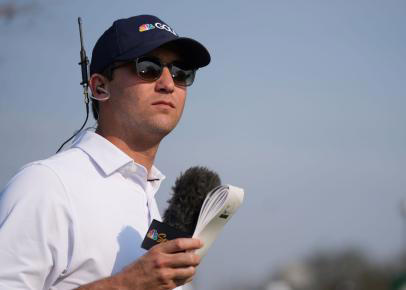
Advertisement
5 best bets for the 2024 valspar championship, share this article.
Throughout the PGA Tour season, I use statistical modeling to see how each golfer should fit that week’s course by parsing strokes gained data at a granular level before placing bets on outright winners. We’ll use this same data to identify the best DFS plays and fades, finding the guys who score tons of points that very few other players may decide to roster.
Along the way we’ll let you know when we find some value among prop bets. I’ll be primarily using data and the tools from RickRunGood.com, PGA Tour and Shotlink f or this column.
Rejoice. For there is no Scottie Scheffler and his newfound putter to ruin the party this week in Florida.
Needless to say after his victory at The Players Championship, when Scheffler can put at an average level, he's probably going to win. He is that good tee-to-green. We are witnessing a stretch of golf that is so good it does occasionally remind you of a certain large feline.
In any case, we continue the Florida swing at Innisbrook Copperhead for the Valspar Championship still in search of our first outright winner of the week, which actually feels nearly impossible. We will keep taking swings because we simply do not know any other way. Mike Trout, arguably the greatest hitter in baseball once went through an 0-for-23 stretch. There's a million other comparisons that I'm quite frankly too lazy to look up. I ask you simply one question: Why not us?
The Course: Innisbrook (Copperhead)

(Photo by Julio Aguilar/Getty Images)
Innisbrook is a true test, and features one of the toughest closing stretches in all of professional golf with The Snake Pit,. The three holes play as a trio at nearly 0.6 strokes over par historically and are generally a source of fireworks down the stretch.
While 16-17-18 will certainly grab many headlines, the rest of the course is no slouch either. Unlike the declawed version of PGA National we saw a few weeks ago, this course still has plenty to offer in terms of testing the best players on Earth, and I’d expect a winner in single digits under par this week or very close to it. Even one of the theoretical “birdie holes”, the Par 5 fifth hole offers little respite playing at basically even par and measuring a staggering 601 yards. It does play a bit longer than the roughly 7,300 yards it measures with several forced carries and Par 4s that will ask the players to hit less than driver. For all the talk about how important approach play will be this week – and make no mistake, it will be the most important statistic – Innisbrook features some incredibly difficult green complexes with subtle undulations that have caused several pros to draw some parallels of the Larry Packard Par-71 to Alister MacKenzie’s crown jewel just 451 miles north of here.
The key stats we’ll be focused on this week are:
- SG: Approach (Particularly in the ranges of 150-200 yards)
- SG: Difficult Courses
- Bogey Avoidance
- SG: Putting (Bermuda + Total)
- Going for the Green %
- Par 5 Scoring
Justin Thomas – 1 Unit (+1400)

Tony Finau – 1 Unit (+2500)

(Photo by Sam Greenwood/Getty Images)
Eric Cole – 1 Unit (+4000)

Doug Ghim - 1 Unit (+4500)

(Photo by Douglas P. DeFelice/Getty Images)
Aaron Rai - 1 Unit (+5000)

(Photo by Hector Vivas/Getty Images)
Gannett may earn revenue from sports betting operators for audience referrals to betting services. Sports betting operators have no influence over nor are any such revenues in any way dependent on or linked to the newsrooms or news coverage. Terms apply, see operator site for Terms and Conditions. If you or someone you know has a gambling problem, help is available. Call the National Council on Problem Gambling 24/7 at 1-800-GAMBLER (NJ, OH), 1-800-522-4700 (CO), 1-800-BETS-OFF (IA), 1-800-9-WITH-IT (IN). Must be 21 or older to gamble. Sports betting and gambling are not legal in all locations. Be sure to comply with laws applicable where you reside.
Most Popular
Wildlife officer thought angler was joking when reporting a rare catch, ranking all 68 of the 2024 men's ncaa tournament teams by mascot, cameras captured the awkward moment kim mulkey had to tell angel reese lsu earned a no. 3 seed in women's march madness, nfl power rankings, post-free agency: falcons immediately become contenders with kirk cousins, 7 men's college basketball teams that declined to play in the 2024 nit, 6 men's hoops injuries to monitor ahead of march madness, including kansas' kevin mccullar jr., meet the 13 teams competing on the amazing race for season 36.
Please enter an email address.
Thanks for signing up.
Please check your email for a confirmation.
Something went wrong.

Understanding Wyndham Clark as he threatens to run away with The Players

PONTE VEDRA BEACH, Fla. — The leader of the 50th Players Championship stepped to the tee box at the 18th hole at TPC Sawgrass late Friday morning, staring dead in the face one of the most difficult par 4s this place has to offer. Swing the big stick, right?
Brian Harman had a driver in his hands. Collin Morikawa took a wood. Wyndham Clark, the man flashing atop the leaderboard some 450 yards away, had a 4-iron. There would be no smashing, just execution — that 4-iron was hit 250 yards into the middle of the fairway and kept Clark going on his way to a second consecutive round of 65.
Advertisement
“Sometimes you just play to your game, and I hit it where I had a full 7-iron in and just said, ‘Hey, this is not a birdie hole for me right now, and just, we’ll move on and try to eliminate any big numbers,’” Clark said.
I’ve been skeptical of Clark. Two years ago, he was No. 268 in the world. A year ago, he was 109th. He had never won a PGA Tour event. Yes, he has now won the U.S. Open. Yes, he now has wins at Quail Hollow and Pebble Beach. But how many guys spend their 20s just trying to hang on to their PGA Tour card and spend their 30th year around the sun becoming one of the best golfers on the planet?
I figured it was a blip. Lots of guys have one major and then slide back to the pack. Even more have made one Ryder Cup team. OK, so Clark would peak as one of the 20-25 best guys on the PGA Tour for a year, two at most, but that would be it.
It’s increasingly obvious that I was quite wrong — Clark is now No. 5 in the world, per the Official World Golf Ranking, and can rise to third with a win. But even after a second-place finish at the Arnold Palmer Invitational, I was still holding steadfast in my wrong-headedness, despite colleague Brody Miller’s increasingly exasperated arguments otherwise. He showed me the numbers — strokes-gained totals that showed just how it has happened and how Clark’s rise is more than luck or circumstance. That when Clark was good, he was great. It still did not move me.
. @Wyndham_Clark is a MACHINE. A clutch par save to maintain a two-shot lead. pic.twitter.com/n5kAshZMTF — PGA TOUR (@PGATOUR) March 15, 2024
Watching how Clark worked his way around the course Friday, though, handling whatever TPC Sawgrass threw at him, it became clear that my hesitancy to embrace him was rooted in how different his story and game are from so many of his peers. That’s the point, though. It’s a feature, not a bug.
Wyndham Clark is great because he is Wyndham Clark, not a guy cosplaying as someone he’s not. He hits an iron even if you’re hitting a driver. No big deal.
“I used to worry so much about that stuff (world rankings) and was not getting the results I wanted,” Clark said Thursday, after a first-round 65 tied him with Rory McIlroy and Xander Schauffele for the lead. “Now I really focus on my internal stuff, and I’m getting the results and the things I want.”

Scottie Scheffler hurt his neck. What happened next proves that he's now golf's big star
What happened after hole No. 18, when Clark went to the front nine to finish his round, is when things turned special. He birdied four consecutive holes, drained a 22-footer to save par on No. 5, had another birdie on No. 6 and then birdied No. 9 to finish his round. By the end of his morning, the shouts for his name coming from the increasingly large gallery were more and more prominent. People are figuring out this Wyndham Clark guy, especially after he was comfortable talking about his mental health journey in the second season of Netflix’s “Full Swing.” They like what they’re seeing.
Clark, to this point, has not necessarily been the most consistent guy on tour. He’s gone T29, T39, 1, T41, missed cut, 2 in six starts to start 2024. But he also began this week sore from Bay Hill and with enough commitments (the life of a top-five player) to alter his prep Monday through Wednesday. It has hardly mattered.
“I thought I handled it really well because I would come out here, and I wasn’t hitting the best shots, but I knew my game was in a good spot. So I would say ‘aware’ is where I’ve been at,” Clark said.

Rory McIlroy, Jordan Spieth and the awkward tension at The Players Championship
The other way to look at that body of work is that Clark is someone who gets himself up for the big ones, the spiritual successor to Brooks Koepka. His three wins are one major and two signature events, and the Arnold Palmer Invitational was also a signature. The Players is The Players, less than a major but more than a signature.
Clark will start Saturday in the lead, a commanding four shots ahead of Schauffele. Matt Fitzpatrick, Scheffler, Harman, McIlroy and the rest are even farther back.
Still skeptical? Get over it.
(Top photo: Kevin C. Cox / Getty Images)
Get all-access to exclusive stories.
Subscribe to The Athletic for in-depth coverage of your favorite players, teams, leagues and clubs. Try a week on us.

Hugh Kellenberger is the senior managing editor of The Athletic's golf group. A native of North Carolina, Kellenberger previously served as sports editor and columnist for the Jackson (Mississippi) Clarion Ledger. He first covered Ole Miss for the paper, and in the past has covered Indiana for the Bloomington Herald-Times and the ACC for the Rocky Mount Telegram. Follow Hugh on Twitter @ KellenbergerCBB
An injured Scottie Scheffler proves invincible at THE PLAYERS Championship
After playing through neck pain, authors historic final-round 64.
Change Text Size
PONTE VEDRA BEACH, Fla. – Scottie Scheffler was on the move, and the eight carts located around TPC Sawgrass’ practice putting green circled into formation behind him. He was headed to the range to keep loose as his final challengers played the course’s famed finishing hole, hoping for one last long-shot birdie to force a playoff with the tournament’s defending champion.
The ropes that keep spectators at bay had already been removed, so security scrambled to clear a path. Scheffler, with a wedge in hand, looked up when groans arose in the distance. They signified that one threat had been placated. He kept walking to the far end of the range, trying to in vain to find a quiet place to spend the final moments of THE PLAYERS Championship and prepare for a potential playoff.
Fifteen people quickly gathered behind him, however, including several cameramen, and another two dozen fans crowded behind the chest-high steel barricade guarding the practice area. Scheffler took one brief look at his phone before pulling a ball out of the bag and striking a shot with his wedge. He hit a handful of balls, fittingly flushing one last one before another far-off reaction let Scheffler know that the title was his. He and caddie Ted Scott turned to the crowd for confirmation. One bystander waved his hand across his throat.
Scheffler bent over at the waist and put his hands on his knees as NBC’s Smylie Kaufman waited to conduct the winner’s interview for the broadcast.
“I put up a good fight for four days,” Scheffler said. “That's really all there was.”
If Scheffler looked unbeatable a week earlier, when he seemingly solved his putting struggles and cruised to a five-shot victory at the Arnold Palmer Invitational presented by Mastercard, his performance at THE PLAYERS took his appearance of invincibility to another level.
Scottie Scheffler’s news conference after winning THE PLAYERS
Despite the injury, Scheffler authored an unprecedented performance in the 50-year history of THE PLAYERS. Not only did he finish atop a leaderboard containing many of the best players in the world, but Scheffler tied tournament records by shooting 64 on Sunday to overcome a five-shot deficit. He equaled the lowest final round by a PLAYERS winner and the largest fourth-round comeback at TPC Sawgrass. That allowed him to become the tournament’s first back-to-back winner in five decades.
The neck injury that arrived unexpectedly early in his second round made it painful even to hit chip shots. It was on his third hole Friday morning that he called over a PGA TOUR rules official to ask about receiving medical care on the course. Hitting a 90-yard wedge shot on that hole was so painful that he questioned whether he could continue.
Scottie Scheffler overcomes neck injury to win THE PLAYERS 2024
“I didn't really know if I was going to be able to swing,” he said. He received on-course massage and manipulation from physiotherapist Marnus Marais before hitting his tee shots on the 14th, 15th and 16th holes, and immediately after completing his second round.
Ted Scott, Scheffler's caddie, told his wife that he was uncertain if Scheffler could complete the tournament.
“It was kind of miraculous that he could even get it around,” said Scott. “It just shows you what tenacity, resilience, whatever fancy words that you want to use to describe Scottie Scheffler.”
Scottie Scheffler’s Round 4 winning highlights from THE PLAYERS
Scheffler had to take extra club on his approach shots because he couldn’t swing at full speed, and his average driving distance dropped more than 20 yards between the first and second rounds. Scheffler said he was resigned to “slapping it around” in the second and third rounds. He was hit by a wave of pain each time he took the club back.
And yet, an injured Scheffler was still the best ball-striker at TPC Sawgrass. He led the field in Strokes Gained: Tee-to-Green, SG: Off-the-Tee and Driving Accuracy, while also ranking in the top 10 of Greens in Regulation (T3) and SG: Approach-the-Green (7th).
"He was getting frustrated. He couldn't hit the shots that he wanted to hit," Scott said. "So that goes to show you how tough he is. He couldn't move. He was hurting. He was in pain."
Randy Smith, Scheffler’s longtime swing coach, watched the win from afar after leaving TPC Sawgrass earlier in the week. He saw the same tenacity that Scheffler has displayed since he was 7 years old.
“He just wanted to wear you out,” Smith said. “You call it a will to win … but he tends to take it a little bit further than most players I’ve seen.”
This latest victory was reminiscent of Scheffler’s high school days, when he won a Texas state championship while wearing a walking boot. He also played basketball so selflessly and wholeheartedly at Highland Park that the Scots’ basketball coach, David Piehler, had to temper Scheffler’s eagerness to take a charge in order to help the team.
“I had to pull him aside a few times and say, ‘If you see a big guy coming down the lane, you step aside,’” Piehler said. “He was unconcerned with his well-being. … My biggest fear was that he’d jeopardize his golf career.”
This result at TPC Sawgrass seemed inevitable, but Scheffler took an unexpected route to victory. After cruising to a five-shot win the previous week at Bay Hill, Scheffler shot a first-round 67 at TPC Sawgrass. When he birdied his first hole Friday, he seemed unstoppable. Then his neck pain began, and the week took a turn.
“Looking up to see the line on my putt was pretty difficult,” Scheffler said. “It was hard to hit putts because right when I turned my head to look at the hole my brain's sending pain signals … to my brain. It's not easy to focus on making a putt when you're in pain.
“I figured as long as I could get through the round on Friday, Marnus did a good job kind of getting me going for Saturday. I felt a little bit better, like I said, and then Sunday, today, I felt pretty good overall.”
Three consecutive birdies to close his third round put Scheffler within striking distance, five shots behind leader Xander Schauffele. Scheffler parred his first three holes Sunday before holing out from 92 yards for eagle on No. 4. He birdied the next hole, as well, and closed his front nine with two more. He missed a 12-footer for birdie on No. 10 but added another pair of birdies on the next two holes.
Scottie Scheffler holes out 92-yard eagle on No. 4 at THE PLAYERS
Wyndham Clark, who played alongside Schauffele in Sunday’s final group, said he laughed when he looked at a leaderboard for the first time on the back nine and saw Scheffler’s name on top.
“I said, ‘Yeah, of course.’ I mean, he's the best player in the world,” said Clark, the reigning U.S. Open champion who won earlier this year at the AT&T Pebble Beach Pro-Am.
Scheffler’s birdie at 12 tied him with Schauffele for the lead at 19-under par. Scheffler made just one more birdie – getting up and down from a bunker on the par-5 16th – but it proved to be enough after Schauffele, Brian Harman and Wyndham Clark missed their opportunities to tie on the closing holes.
That trio tied for second at 19-under par, one shot behind Scheffler.
“It’s just another week,” said Schauffele, a reference to Scheffler’s continued success.
The victory is Scheffler’s eighth in the past 25 months, a haul that includes the Masters and two PLAYERS titles. He has been the No. 1 player in the world for the majority of that span and is the first player since Tiger Woods to win the PGA TOUR’s Player of the Year Award in consecutive seasons.
Scheffler has finished in the top 10 in nearly two-thirds of his tournaments since the start of the 2022 season (34 of 55, 62%). Last year, his 17 top-10s were the most on TOUR since Vijay Singh in 2005. And he’s been outside the top-10 just once in seven starts in 2024, including these back-to-back wins. The only hardship Scheffler has seemed to suffer on the course in that span were the putting struggles that hampered him last year. But he enlisted noted putting instructor Phil Kenyon last fall and switched to a mallet putter last week at Bay Hill. He also gained strokes on the green (+1.25) this week, but this victory isn’t about the numbers.
“He played with what he had,” said Smith, “and he knows he didn’t have anything but his hands and his creativity to get through it.”
Those hands were on display one last time at TPC Sawgrass when Scheffler first saw his wife, Meredith, after his victory was official. He raised his arms straight in the air as he rode in the passenger seat of a golf cart. Meredith, who is due with the couple’s first child next month, ran toward her husband in a scene that has become rather familiar over the past two years.
The Schefflers have a lot to celebrate, and more to come.
Sean Martin is a senior editor for the PGA TOUR. He is a 2004 graduate of Cal Poly-San Luis Obispo. Attending a small school gave him a heart for the underdog, which is why he enjoys telling stories of golf's lesser-known players. Follow Sean Martin on Twitter .

IMAGES
COMMENTS
Top 10 Finished | Scoring Average | Greens Percentage | Scrambling ... Approaches from inside 100 yards (Rgh) ... PGA TOUR, PGA TOUR Champions, and the Swinging Golfer design are registered ...
They're definitely not twice as easy as 100-yard shots. Pros hit it, on average, just 3 feet closer from 50 yards than they do from 100 yards. ... Only 80.4 percent of PGA Tour pros hit the ...
Now let's examine the 150-yard shot from each group of players. William McGirt (151.4, 149.9, and 151.0) As a PGA Tour Professional, you would assume that the yardages would again be perfect — and they're close, with an average of 150.8 yards. But one thing I want to point out is how TIGHT the dispersion is from this distance.
From under 200 yards, PGA Tour players hit just a little more than half of the greens and when they do, they average 34 feet from the hole. 150-175 yards = 63% of greens. From this range, players hit the green 10% more the last category, but still average 27 feet from the hole. 125-150 yards = 69% of greens.
Approaches from 100-125 yards. Season. 2024. Time Period. Year to Date. Tournament. Cognizant Classic in The Palm Beaches. Through the Cognizant Classic in The Palm Beaches, Mar 3. TOUR AVERAGE20' 7".
Scoring Average. Scottie Scheffler. 69.286. Avg. 1. Doug Ghim. 69.991. Avg. 2. Xander Schauffele. 70.118. Avg. 3. ... PGA TOUR, PGA TOUR Champions, and the Swinging Golfer design are registered ...
INSIGHT #1: Through the entire 2021 season, only ONE tour professional averaged less than 12' from 75-100 yards, and the tour average is almost 18 feet from that range. Now we all know that they hit it to three feet or less reasonably often, so that must mean that it is just as "normal" for tour players to hit a 75- to 100-yard wedge shot ...
PGA Tour Stats: We take a look at the top five in approach-shot proximity from inside 100 yards—and the lob wedges they use.
On average PGA Tour Pros hit 75.4% of greens from 100 to 125 yards away from the fairway. To put this another way, they miss 1 in 4 greens from the fairway with a wedge in hand. The best last season was Nicolai Hojgaaerd with an average proximity of just inside 16ft. The Tour average was 20ft.
PGA TOUR AVERAGE CARRY DISTANCES 2021. DRIVER - 275 YARDS. 3 WOOD - 243 YARDS. 5 WOOD - 230 YARDS. HYBRID - 225 YARDS. 3 IRON - 212 YARDS. 4 IRON - 203 YARDS. 5 IRON - 194 YARDS. 6 IRON - 183 YARDS.
The complete 2022-23 PGA TOUR Scoring average per round rankings on ESPN. The full list of all PGA players ranked based on Scoring average per round.
The 20+ handicapper averages 83 feet from the hole on wedge shots from 100-120 yards. That's about 21 feet farther than their distance from 60-80 yards! As a point of reference, PGA Tour players average 19' 7" from the hole on shots from 100-125 yards. The data suggests that golfers should lay up as close as possible, and the logical ...
Rollout is average 20 yards. Reply. Tim March 5, 2021 at 8:16 am . No, it is 3° and that means the clubhead is movin upwards. - is downwards. Reply. Rufuss August 30, 2021 at 5:55 am . You are reading the LPGA (ladies) numbers Tim. The PGA (men) average is -1.3. ... I'm about a half club off of PGA Tour average distance wise. Technically I ...
In the 2022-23 PGA TOUR season, there were 55 total wins spanning players from 14 countries. The USA (27), Canada (4), Spain (4), England (3), South Korea (3) & Norway (3) were the only countries with more than three victories this season. Youth Movement Last 10 Seasons: 23 total wins by players in their 20s in the 54 events of the 2022-23 PGA ...
Pohl led the tour in driving with a respectable 274.3-yard average and accruing over 51,000 yards driven. Pohl, unfortunately, would not pick up a win on Tour in 1980 — or '81, when he led the ...
From 25 yards in the fairway, the odds of a pro holing out are about 100 to 1. From 50 yards, the odds swell to about 300 to 1. From 100 yards, the odds are closer to 900 to 1.
Scoring Average. Season. 2024. Time Period. Year to Date. Tournament. Cognizant Classic in The Palm Beaches. Through the Cognizant Classic in The Palm Beaches, Mar 3. TOUR AVERAGE71.372.
According to the PGA Tour website, Rory McIlroy, a key figure who supports the change, is at the top of the list for the 2022/23 season with an average driving distance of 326.3 yards. Let's say that average comes down by the top figure given by the governing bodies once the change comes in - 15 yards.
On average PGA Tour pros hit a 3-wood a 'carry' distance of 249 yards. By comparison a 5-wood carries 235 yards and hit a 3 hybrid, which measures from 19º to 21º, an average carry distance of 230 yards. On the LPGA Tour the top women pros carry a 3-wood 195 yards, a 5-wood 185 yards and a 7-wood 174 yards on average.
Dive into the PGA Tour's proximity averages from 50-200 yards for the 2022-2023 season. How do the pros measure up? PGA Tour Averages: Proximity To Hole 50-200 Yards. ... 175-200 yards: 35' 9" PGA Tour: 2022-2023 Season - Through the John Deere Classic. Related. Share: More Posts.
Here's what the PGA Tour stats and Arccos's average golfer numbers say about how the last act of the Stadium course plays out. ... While the average golfer plays a tee 36 yards shorter than ...
He ranks third in the entire field in SG: Approach over his last 100 rounds and has been particularly excellent in the distance buckets of 150-175 yards, and 175-200 yards where he ranks 21st and ...
Strokes Gained | Scoring Overall | Under Par Scoring | Over Par Scoring | Scoring by Round | Par 3,4,5 Scoring | Front 9 Scoring | Back 9 Scoring | Early Scorin
"On the PGA Tour, from 20 yards in the rough, when you have at least 10 yards of green to work with, [Tour pros] leave 50 percent of their shots outside of eight feet." Instruction
Average LPGA Tour driver distance 238 yards Average PGA Tour driver distance 295 yards #trackman #titleist #footjoy Let's find your distance @lakehousesports #bryanhaasgolf. Ivan Kay · Check This Out
The par-4, 475-yard 16th hole was the ninth most difficult hole in 2023 with an average score of 4.373, +.373 strokes over par; ... The golf course as a whole was the seventh most difficult venue on the PGA Tour last season, with an average score of .935 strokes over par. The par-71 layout will measure 7,340 yards once again in 2024.
PGA TOUR, PGA TOUR Champions, and the Swinging Golfer design are registered trademarks. The Korn Ferry trademark is also a registered trademark, and is used in the Korn Ferry Tour logo with permission
There would be no smashing, just execution — that 4-iron was hit 250 yards into the middle of the fairway and kept Clark going on his way to a second consecutive round of 65.
Scheffler had to take extra club on his approach shots because he couldn't swing at full speed, and his average driving distance dropped more than 20 yards between the first and second rounds.